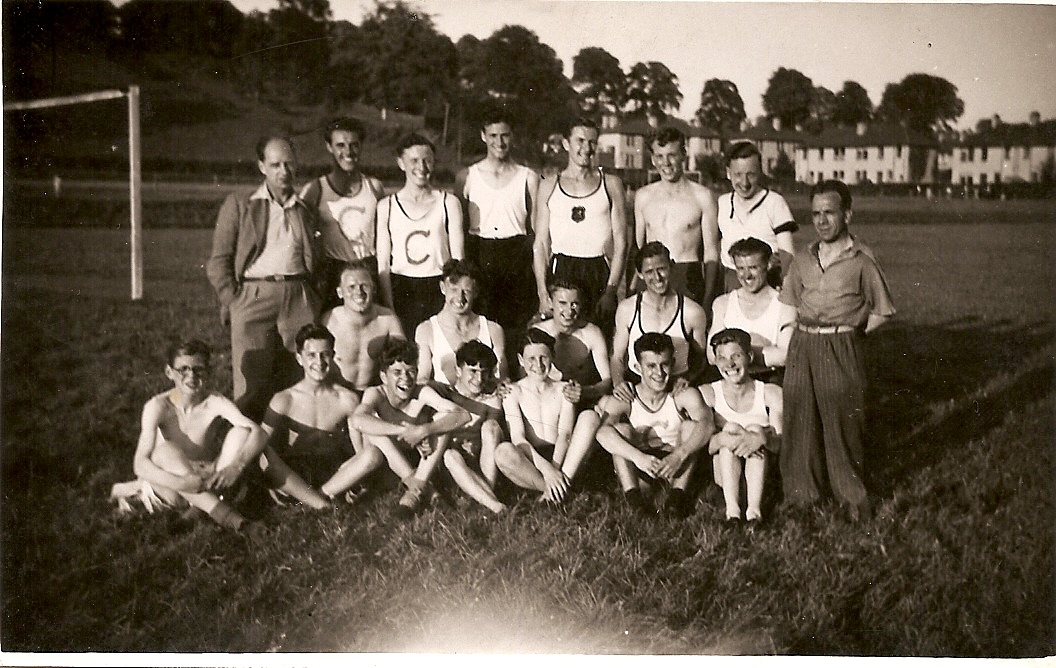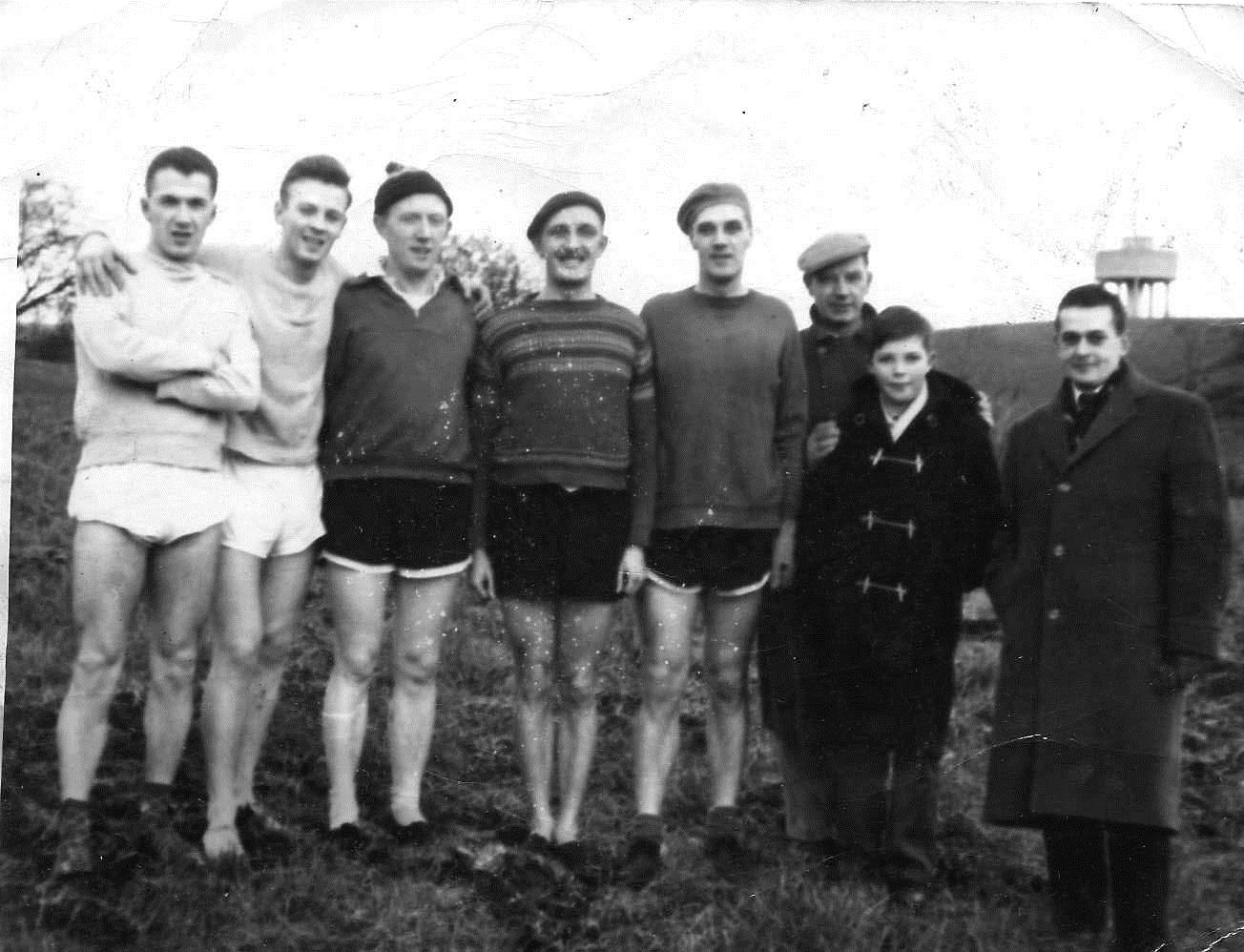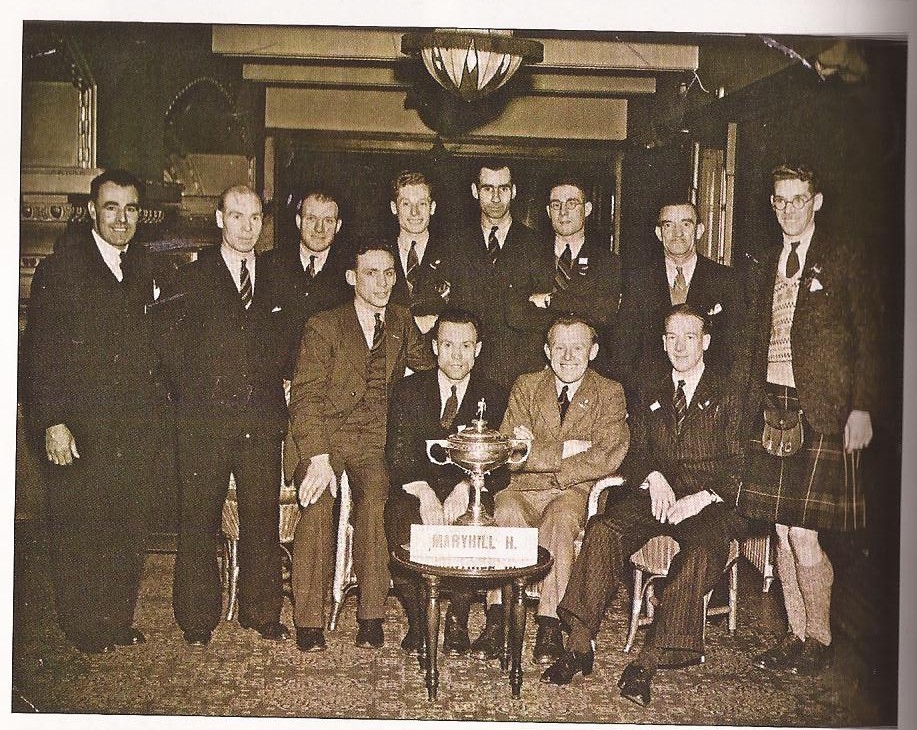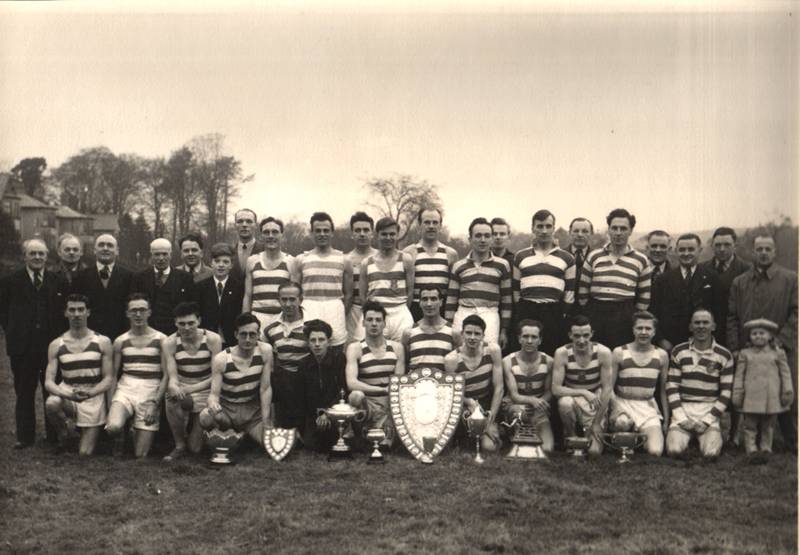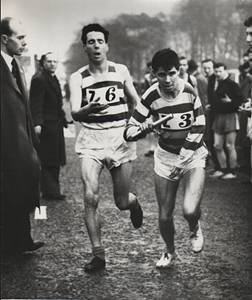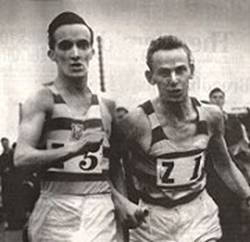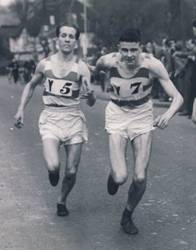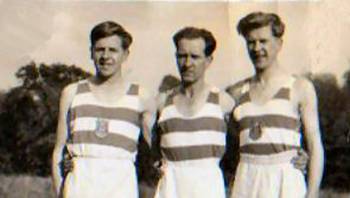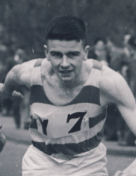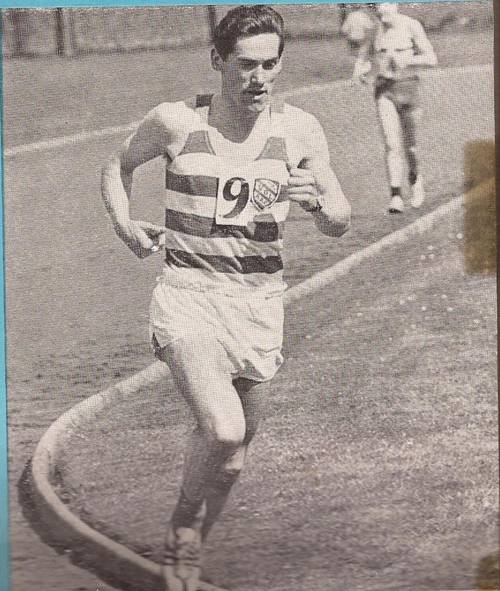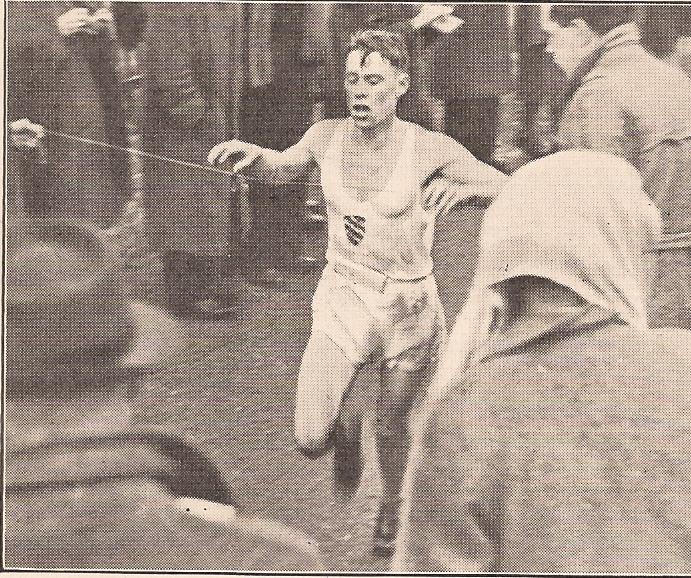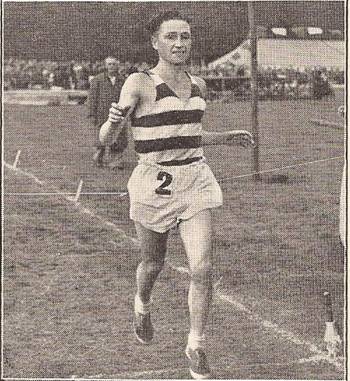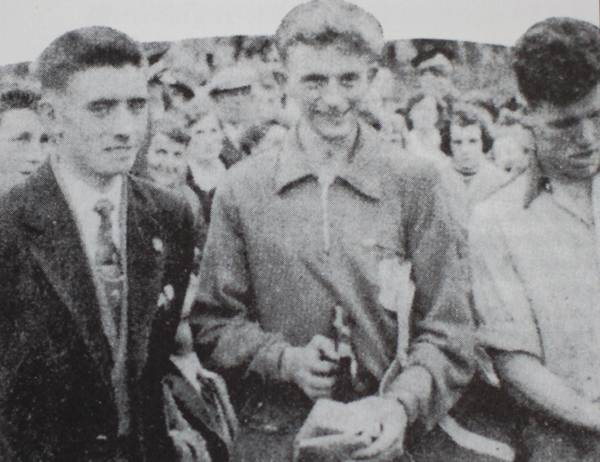Category: The Fast Pack
Edinburgh University winners in the Edinburgh to Glasgow Road Relay
WINNING THE EDINBURGH TO GLASGOW ROAD RELAY
EDINBURGH UNIVERSITY HARE AND HOUNDS 1959-1984
Alistair Blamire’s marvellous book “The Green Machine”, which tells the story of many successes by EUH&H runners between 1960 and 1970, is meticulously researched and must be read and enjoyed to appreciate fully the club’s many achievements during those years and to learn about the athletes who contributed to such excellence.
This article will concentrate mainly on a single annual event: the much-loved and sadly-missed Edinburgh to Glasgow Road Relay. This took place on 64 occasions, nearly always in November, between 1930 and 2002. Usually the route was 44 miles in length, divided into 8 stages. The top 20 clubs in Scotland were invited; and the race was considered to be the ‘blue riband’ of the Winter season and, for many participants, may have been more popular than the Scottish Cross-Country Championships.
Edinburgh University Hare and Hounds after winning the 1965 E to G.
Back row, left to right: Roger Young, Chris Elson, Willie Allan, Frank Gamwell, Iain Hathorn (Secretary);
Front row: Fergus Murray, Jim Wight, Alex Wight, Alistair Blamire.
On the 20th of November 1965, Edinburgh University demolished the E to G course record, and set new individual marks on Stages 1, 6 and 7. This victory, as well as others in 1966 and 1967; and further gold medals won by EU graduates, with brief individual profiles, will complete the piece.
Here is the race report, published a week later in ‘Athletics Weekly’.
The winning team, in running order, was: Alistair Blamire (record on 1); Alex Wight; Willie Allan; Chris Elson (2nd fastest on 4); Frank Gamwell (fastest on 4); Fergus Murray (record on 6); Jim Wight (record on 7); and Roger Young (second-fastest on 8). Supplying only initials for first names can be irritating. For other clubs, especially fine performances were produced by Bert Carse on Stage 2, Pat Maclagan and John Rough on 3, Bert McKay and Des Austin on 7, and Alastair Johnston and Dick Wedlock on 8.
“The weather was damp with slight drizzle at times and a slight following breeze.” Well, records in this event were always aided by a tailwind (for example in 1975, when Edinburgh Southern Harriers broke EU’s 1965 record; and 1983, when Aberdeen AAC won in the second-fastest time ever up to that year.)
Edinburgh University’s entire team ran very well, with Fergus Murray (as usual) the major star; but Jim Wight took no less than 39 seconds off the Stage 7 record, ‘running scared’ from Bert Mackay, who was only 4 seconds slower.
Chris Elson kindly looked out a (beer-stained?) race report from The Edinburgh Southern Times.
But what had led up to this break-through triumph? “The Green Machine” suggests the following: training ideas (like hill-repetitions, fartlek and many miles of steady running) from Percy Cerutty and Arthur Lydiard; Chris Elson learning a lot (from Olympic 1500m runner Alan Simpson) and, through his own “enthusiasm and innovative training methods”, encouraging athletic improvement in others; Fergus Murray’s influence as a role model; and the three-year lease (1965-68) that Alistair Matson secured at 78 Morningside Drive – ‘The Zoo’ – where so many athletes resided and ran hard with other ‘Serious Amateurs’ who joined in zealously.
Which Edinburgh University runners (and/or graduates) featured in winning E to G teams? The 1965 super-team obviously; and participants in the 1966 and 1967 EU victories. Certain graduates won gold in 1969, 1973, 1974, 1975, 1977, 1978, 1982 and 1984. Please read on.
For Edinburgh University, Martin Craven (“nicknamed ‘The Crab’ because of his slightly eccentric running style” ran the E to G in 1959 (17th) and 1960 (10th). For ESH, he was an important contributor to winning teams in 1973 (fastest on 5), 1974, 1975 when he broke Iain Hathorn’s 1966 Stage 3 record with 20.42, 1977 (fastest on 8) and 1978. Martin also won team gold medals for ESH in the 1976 Scottish XC Relay; the 1979 and 1980 Six-Stage Road Relay; and the 1979 and 1980 Senior National. He represented Scotland in the 1963 International XC Championships; and Britain in the 1967 Kosice Marathon in Czechoslovakia.
The 1961 E to G included the EU debuts for Chris Elson and Fergus Murray; 1962 added Alex Wight and Frank Gamwell; 1963 was strengthened by Roger Young along with Chris, Frank and Fergus (who was fastest on the prestigious Stage 2); in 1964, when the team improved to second, the record-breaking outfit was almost complete, since Alistair Blamire and Jim Wight featured, along with Chris, Roger and Frank, as well as Fergus (fastest once more on 2) and Ian Young (fastest on 8).
Chris Elson (‘The Bear’) was part of E to G victories in 1966 (when he set a new record of 23.21 on 8) and 1967. In addition, he helped EU to: 1963 Scottish Junior National XC gold; and 1967 cross-country successes in the Scottish Senior National and the British Universities Championship. His personal best times as a ‘Veteran’, from M40 to M60, were very impressive. Chris continues to coach young athletes at Bristol and West Athletics club.
He remembers this about the 1965 E to G: “I got some sort of a stitch earlier on, due to the slush freezing my lower half. Happily, I got over it and could run hard for the last section. A good job in the circumstances!”
Fergus Murray. What can one say? “The Green Machine” includes a long, detailed chapter on his stellar running career: very hard-training, inspirational and encouraging. An Olympic 10,000m runner in 1964, frequently a British International at that event and the marathon. Scottish XC Champion three times in succession. Scottish International (Track and Country). A great team man; and modest in spite of all that individual success. Fergus also featured in four winning E to G teams for ESH (1969, 1973 – fastest on Stage 4 – 1975 and 1977). He was in two victorious ESH Senior National teams (1969 and 1970).
Fergus recalls this about his EU days: “I don’t think any of us remember much about being competitors and certainly, on a personal level, it is the Relay/Team wins that endure – Edinburgh-Glasgow, Hyde Park and the SCCU (I’d left by the time they won BUSF).
I would like to comment on how prominent ‘The News of the World’ was in sponsoring Athletics in that era, and earlier. The 8 Stage buses for the E-G, the meal afterwards and one of the most attractive medals ………including one for the Club with the most meritorious unplaced peformance. The News of the World also sponsored the English equivalent of the London- Brighton. Apart from these, all GB v other Nations International athletics meetings in the summer at the White City Stadium were also sponsored by ‘The News of the World’ with a dinner in a top hotel afterwards.
The “column inches” of newspaper athletics reporting in those days far exceed the coverage of present times apart from the few at World elite level………….how times have changed.
Another memory too, was that SNOW was not an unusual encounter in November!”
Alex Wight tried to run 100 miles per week, while living in ‘The Zoo’. For EU and subsequently EAC in the E to G, Alex won two gold and five silver medals. In 1972, he was fastest on Stage 4. In the Scottish Senior National XC, between 1965 and 1979, Alex won an amazing seven gold, three silver and three bronze team medals. Both brothers featured in the greatest team performance in National history, in 1975, when EAC’s six counters could only total a measly 37 points! Alex, whose best individual place was 8th, was unlucky not to run for Scotland in the International Cross-Country Union Championships. On the road, Alex was twice victorious in the 36 miles Two Bridges ultra, once in record time; won the 44 miles Edinburgh to Glasgow Individual Race (and for EAC, inevitably, the team award!) and had a very impressive marathon best of 2.15.27.
Alex wrote: “Nowadays, we think that the mind plays a much bigger part in performance, so I wonder if, in those far-off days of innocence, I put far more pressure on myself in road races than I did in more happy-go-lucky appearances in the mud when, as I recall, my aim was first just to try and make the counting six.”
Frank Gamwell was a valuable member of the illustrious mid-1960s Edinburgh University team. In the 1964 E to G, EU secured silver medals. One real highlight was in the 1965 event, when EU broke the race record and won gold. Frank took them into the lead when he was fastest on Stage Five. Another great day was in the 1966 Senior National XC, when the students finished first in the team contest.
Roger Young started at Edinburgh University in 1962/63, having been a noted athlete at school level. Second to Ian McCafferty in the 1965 National Junior cross-country championships, he was selected to represent the Scotland Senior team in the International but, sadly, due to excessive strictness from an EU tutor, had to withdraw. Captain of EUH&H in 1964/65 he was virtually ever-present in teams at District and National championships. In the E to G, he contributed to silver medals in 1964 and gold (running the final ‘Glory Leg’) in the record-breaking 1965 team. In the 1966 Senior National XC he finished 8th and EU won the team title. He retired from competitive running in 1966.
‘The Green Machine’ includes the fact that one of Roger’s favourite anecdotes relates to the 1965 E to G triumph. “Roger ran the last leg and, as the lead runner, was expecting to be handed the ceremonial baton a couple of hundred yards from the finish.” This special baton contained “a message from the Edinburgh Lord Provost to his Glasgow counterpart. But there was no baton and no Lord Provost and the only official at the finish was the timekeeper – everyone else, including the baton and its intended recipient, was in a nearby watering hole. So, after completing the race, Roger was told to run back up the course and do the finish again once the Lord Provost had emerged from the pub.”
Alistair Blamire enjoyed a marvellous athletics career. He won the 1964 Scottish Schools steeplechase in record time and then represented Scottish Schools and Scottish Juniors on the track. In 1966 he ran for Scotland in the International Junior XC, finishing a good 15th. Alistair went on wear the Scottish vest five times in the International Senior. He was silver medallist in the 1968 Scottish Senior National, just one second behind Lachie Stewart; and second again, to Jim Alder, in 1971; when he was 11th in the English National XC, running for the winning Shettleston Harriers team. On the track, Alistair ran the steeplechase several times for Scotland and also Great Britain, setting Scottish National (8.41.4) and Native (8.46.2) records in 1969. He won the British Universities title; and, in 1972, the Scottish Senior championship. He was an important part of many Scottish team triumphs: in the E to G, three gold medals with EUH&H, one with Shettleston, two and with ESH. In the Scottish Junior National, two with EU. In the Senior National, one with EU, one with Shettleston, plus five silver medals with ESH. In 1976, for ESH, Alistair added gold in the Scottish Cross-Country Relay championship.
Alistair added memories of (thoroughly justifiable) post-race celebrations: “After the E to G we would head back to Edinburgh and maybe have a pint in the Men’s Student Union, then walk down to Rose Street, to The Abbotsford (probably our favourite) or Milne’s Bar (howff of the famous poets – Hugh MacDiarmid, Norman MacCaig et al) or The Café Royal or Paddy’s Bar, looking for pints and parties. The 10pm closing time put pressure on us to drink more quickly than would have been advisable. Three pints an hour…still competing…? For those lucky enough to be on an early leg in the E to G, there was a pub somewhere in the wilderness near Airdrie which we could drink in while watching the start of Stage Six, before hopping back on to the bus…” (That was at the end of Stage 5: the Forestfield Inn, now gone, alas.)
Jim Wight had a weekly training target of 60 miles per week, which went up to 75 by the end of the 1960s. For EU and subsequently EAC in the E to G, Jim won three golds and a silver. His finest cross-country result was probably 17th in the 1972 English National at Sutton Coldfield, coming through very strongly despite the notorious blizzard. He was in the winning EU Scottish Junior teams in 1964 and 1965. Between 1967 and 1975, Jim won four Senior National XC gold, two silver and two bronze team medals, plus an extra silver in the National Cross-Country Relay. Jim ran for the Junior International Scottish team in Dublin 1964; and the senior Scottish team in Cambridge 1972. On the road, he had a most impressive best marathon time of 2.15.43. Jim ran for Scotland in the 1974 Commonwealth Games marathon; and later that year won the prestigious Harlow Marathon in 2.16.28; plus the Two Bridges 36.
He wrote: “As well as living near The Zoo – about a couple of miles away in Newington – I actually lived there as well for a while (at least a year) after I finished my first degree in 1966. I shared a room with John Bryant, which ties in with the text saying he lived there in 1966/67. I can’t remember when I moved out, or the details of what I did – I suspect with little competitive running – stuttering towards the world of work until returning to Edinburgh in April 1969, where I remained until I came to Newcastle in 1986.
In the 1965 E to G, I was “running scared” on Stage 7 in 1965 because I imagined that, being holders, Motherwell were favourites. Having taken over in the lead I was fearful of losing it. I thought I had Bert McKay breathing down my neck but looking at the times now. I had a bigger lead than I’ve always thought I had. It came as quite a surprise when told I had broken the record.
I would agree that the 1972 English National probably was my finest XC run but I might even say it was because of the blizzard. The cold, not just that day, didn’t seem to affect me as much as it did others but the heat could do for me.”
Willie Allan was Scottish Schools Triple Jump champion in 1962 for Dumfries Academy (the same school Alistair Blamire attended) but became a very successful long-distance runner while at Edinburgh University. He won several honours in cross-country and road team competition while at Edinburgh University. These included team victory in the Edinburgh to Glasgow Road Relay in 1965 (where he was third fastest individual on the third leg), third team in the Scottish Junior Championships in 1966, first team in the Scottish Universities Championships in 1967 and first team in the Scottish Senior Championships in the same year. In 1969, running for ESH, Willie won another Senior National team gold. Willie’s main event on the track was the steeplechase in which he was Surrey champion in 1970 and had a best time of 9:13.0 set at the Scottish championships in 1968. After graduating, Willie moved to England and went on to have a very successful career as a veteran, running for England and winning British Masters titles. At his peak Willie ran 80-90 miles per week in training. This included a long run of 16 miles on a Sunday, two fartlek sessions a week and twice daily training on five days.
He wrote: “In 1965 I thought myself very lucky to be named as first reserve for the E-G team, never dreaming that I would have to run. However, someone (Ian Young) was ill the week before the race and I was in. Knowing that the team had a great chance of winning I have never before or since been so petrified on the day of a race as then, in fact quite sick. It was daunting to know that, if I had a bad run, I might end the team’s chances. As it turned out I ran half decently but I’ll never forget the feeling and can still break out in a sweat at the thought.
I won two British Masters titles. An M60 ten miles road title (1965) and an M70 half marathon title (2015). I didn’t win an XC title but was runner-up twice. Once at M60 (2006) and once at M65 (2011). I was also runner-up in that M65 year in the 5k, 10k and Ten Miles.
I was 2nd in the British and Irish Masters International XC in Dublin to fellow Glaswegian Bobby Young in 2005 when, if I had been able to run for Scotland, as I wanted to, rather than England, the Scottish team would have gained a notable and rare team victory. As it was, I led the England team to victory. Now I have only a year to go until entering the M75 age group and hopefully winning again!”
Edinburgh University’s second successive E to G win was in 1966. In running order, the team was: Alistair Blamire (new record of 27.01 on Stage 1); Alex Wight; Iain Hathorn (new record of 21.05 on Stage 3; Dave Logue (3rd fastest on 4); Ian Young (second fastest, only one second slower than Alastair Johnston’s new record, on 5); Gareth Bryan-Jones (3rd fastest on 6); Jim Wight (fastest on 7); and Chris Elson (new record of 23.21 on 8).
Ian Young came up through the age groups as one of Eddie Sinclair’s battalion of young athletes in Springburn Harriers who conquered almost everything that was put in front of them. Ian was second to Ian McCafferty in the Youths National in 1963, was first winner of the SSAA Cross-Country championships and won the SSAA Mile the same year. He ran for Scottish Schools and also for the Scottish Junior team in the cross country international in Dublin in 1964. He went on to study at Edinburgh and started running for them in season ’64/’65. He gained a second Junior International vest that year for the race in Ostend. As a student at Edinburgh he had a sparkling athletic career In the E to G, for EU, he was fastest on Stage 5 in 1968. Ian was second in the S.A.A.A 3 miles in 1967; and secured a Scottish International Track vest that year, racing 2 Miles against Denmark. His personal bests were: 2 miles: 9.20.0 in 1967; 3 miles: 14.01.6 in 1967.
Ian wrote: “My first experience of the E-G was in 1963 wearing the blue of Springburn rather than the green of EUH&H. I was a reasonable 6th fastest on Stage 4 which broke me in nicely for 1964 when I had the fastest time on stage 8 as you pointed out, bringing EU home in 2nd place. As I crossed the line, the wonderful ‘Old’ Jack Crawford, doyen of Springburn officials, came up to me and said, “I thought I recognised the face, but I couldn’t recognise the vest you were wearing….”
You were good enough to mention my 2nd place in the SAAA 3 miles in 1967, behind Lachie Stewart (Vale of Leven) and ahead of Eddie Knox (Springburn). That result followed wins in the Scottish Universities Cross Country over our own Braid Hills course and the Scottish Universities 3 miles, during a good year leading up to the 1967 E-G win.”
Dave Logue. After representing Northern Ireland in the mile in the Schools International in 1965, he studied veterinary science at EU. He was a member of winning teams in the Scottish Junior National in 1967 and the Senior National in 1968; as well as contributing to more titles with ESH in 1979, 1982 and 1983. He was Scottish Universities and Midland District Cross-Country Champion. In the E to G, he won twice with EU; and four times with ESH, being fastest on Stage 6 twice, in 1975 and 1976. For Northern Ireland, while still at EU, he set a NI steeplechase record in 1970 and took part bravely, despite painful injury, in the 1970 Commonwealth Games at Edinburgh. Dave’s 5000m personal best is 13.53; and for 10,000m 29.03.8. In 1974 he won the Northern Ireland XC title; and represented NI six times in the International, between 1968 and 1976. Dave was famed partly for extremely hard training and racing; and equally enthusiastic post-race festivity. His strength, popularity and sociable nature seems undiminished by the passing years.
Dave wrote: “I always thought that the EUH&H team that made third in the 1969 E to G, one year after the big boys had moved on was a brilliant achievement. given the opposition. Everyone ran out of their skins. (The team, in running order, was: Jim Dingwall, Andy McKean, Dave Taylor, Dave Logue, Doug Glover, Alistair Blamire, Jack MacFie, Rab Hendry.) On Stage 8, Rab’s finish was unforgettable – he gasped afterwards that he had suffered, “A bit e bile!”
From my first E to G in 1966, I remember the care the big boys took in deciding who would run which leg and who we were likely to up against. In 1967 on Stage 4, I moved into the lead, but had ‘Big D’ (Northern Irish star Derek Graham) tearing almost a minute off me!
I always felt my best run was on the 6th leg for Glasgow University H&H in 1973 – just 16 seconds slower than Andy McKean’s new record. That day, I ran faster than Ian Stewart, though he was not at his best but he still ran 28.20 odds in the Commonwealth Games 10K a few months later!”
Another good day for Dave was being a member of the winning North Belfast Harriers team in the Lagan Valley 61-mile Road Relay in Northern Ireland. His team beat 9th Old Boys (including one D. Graham). The route was: “run through towns which make up the geographical boundaries of the River Lagan. It was the ultimate test of club strength in depth as it required not only a twelve-man team but also a considerable back up entourage. The race progressed via Dunmurry, Lisburn, Dromore Banbridge, Gilford, Portadown, Lurgan, Moira, Lisburn and back to finish on the track at Ormeau Park.”
Gareth Bryan-Jones. As befits an Olympian, Gareth’s detailed profile in “The Green Machine” is shorter only compared to Fergus Murray’s. Before coming to EU to study for a PhD in Microbiology, Gareth had run very well at Leeds University, being part of a winning team in the Hyde Park Relay and finishing second in the Universities Athletic Union Championships steeplechase. Gareth was a formidable component of the EU success story. In the E to G, he won gold in 1966 and 1967; and later added four more victories with ESH. In the Senior National XC, EU won the title in 1968, and ESH in 1969 and 1970. Gareth represented Scotland in the International XC championships three times. In the Steeplechase, he won the British Universities Steeplechase three times; the Scottish Championship five times; and in 1968, the AAA title. This led to selection for the high-altitude-affected Olympic Games in Mexico City. Gareth was a regular track international for GB; and represented Scotland seven times, including an excellent fourth place in the 1970 Commonwealth Games Steeplechase. In 1976, he switched from athletics to Orienteering (representing Scotland and GB) and Fell Running. Gareth’s continued fitness and competitiveness is amazing. In 2013, he became the first person aged 70 to complete the arduous 96-mile West Highland Way Race from Milngavie to Fort William.
Iain Hathorn, a half-miler with a best time of 1.54.3, was part of the all-conquering EU squad of the mid-sixties. In 1966, they won the E to G (and Iain broke the record on Stage Three); and they retained their title in 1967. In the 1968 Senior National XC, EU won the team contest by one point from Aberdeen AAC. Iain’s 19th place was critical in ensuring victory.
Iain wrote: “Preparing for the Ben was my wake up to a more serious running effort. I stayed in the Zoo over the summer and ran with the greats then, in September, the Ben – I was 21st on my 21st birthday in just under 2hrs. As a dental student at the time, moving around the dental hospital was very painful on the following Monday, mainly the effects of the downhill.
The only other thing of note was my fastest time in the East of Scotland Relays in the Borders, which got me picked for the SCCU vs the Army in Carlisle. I beat John Linaker’s time, after he had just returned from the 1966 Commonwealth Games. Cause for celebration at the time.
Having qualified as a dentist in 68, I found the grind of the 9 to 5 incompatible with serious running and took to rugby until my mid-30s.”
In 1967, EUH&H completed a hat-trick of E to G victories. The team was: Iain Hathorn; Alistair Blamire (second-equal fastest on 2); Andy McKean (second-equal fastest on 3); Dave Logue (third fastest on 4); Ian Young (second-fastest on 5), Gareth Bryan-Jones (second-fastest to Fergus Murray, now of ESH, on 6); Jim Wight (fastest on 7); and Chris Elson.
Andy McKean became a great cross-country runner, admired for all-out effort and toughness. In the E to G, he and his friend and early mentor Dave Logue (another man with high pain tolerance) often battled to run faster on the longest stage 6, where McKean broke the record in 1973. With EU he contributed to gold in 1967 and bronze in 1969. With EAC, five successive team silvers from 1973-1977. He was fastest on Stage 6 four times; and twice on Stage 2. Andy was victorious in the Scottish Senior National Cross-Country championship four times, and also won the East Districts (four as well) and the 1973 British Universities title. In 1974 Andy finished an excellent third in the English National. With EAC, he led the way to four team triumphs in the Senior National. Over the country, he represented Scottish Universities, British Universities, Scotland (in the International XC twice and the World Championships six times); and, on the road, Great Britain (a 1975 Barcelona International Race, where he finished second behind the future 1980 Olympic Steeplechase champion, Poland’s Bronislaw Malinowski – whose mother was Scottish). On the track he became British Universities 5000m champion in 1970; and won the Scottish Ten Miles in 1972.
From 1969-1982, several former EUH&H runners helped Edinburgh Southern Harriers to Edinburgh to Glasgow Road Relay triumphs. The 1969 win featured Gareth Bryan-Jones, Fergus Murray and also ‘honorary Zoo training mate’ John Bryant.
John Bryant had been an Oxford blue in the steeplechase and was working in Edinburgh for the Edinburgh Evening News when he lived in ‘The Zoo’ with the Edinburgh students in 1966/67. He joined Edinburgh Southern Harriers and ran in the E-G in 1967 and 1969 when he won a gold team medal; he also ran in the National in 1968 where he won team bronze. Later, John, a distinguished journalist, wrote several excellent books featuring key moments in athletics history, such as the first sub-four-minute mile and the early history of the marathon.
1973 included Fergus Murray (second fastest on 4); Martin Craven (fastest on 5); and GBJ (new record on 8).
1974 had Alistair Blamire (fastest-equal on 4); Martin Craven; Dave Logue (3rd fastest on 6); and GBJ (second-fastest on 8, chased hard for EAC by former EU athlete Jim Dingwall, who had to wait until 1984 for his team, from 1977 the successful Falkirk Victoria Harriers, to secure gold).
Jim Dingwall was popular, influential and an incredibly versatile athlete. He started his running career as a sprinter, being part of the George Heriot’s School 4×110 yards relay team that won the Scottish Schools title in 1964. Although he never lost a devastating finishing kick, Jim went on to become a successful track and (eventually) cross-country exponent. He won the 1973 British Universities 5000m; set a Scottish Native record over 3000m; and won the Scottish 10,000m title three times, as well as being a Scottish Track International. Jim ran for Scotland in the International or World Cross three times. In the E to G, for EU he was fastest on Stage 1 in 1971; for EAC fastest on Stage 8 in 1974; for Falkirk Victoria Harriers fastest on Stage 2 in 1976; and equalled Andy McKean’s Stage 6 record when fastest in 1977. He developed into an excellent marathon runner, with a personal best time of 2.11.44. Jim won the 1977 Scottish Marathon title in a championship record; and subsequently raced for GB in many International marathons; and for Scotland in the 1978 Commonwealth Games. “The Green Machine” includes the following tribute: “Jim was a very sociable character, highly respected from his time at EUH&H and beyond, being dubbed ‘The Guv’nor’, which reflected his status among running contemporaries”. He trained intelligently and hard; enjoyed post-race real ale and singing; and successfully encouraged many others to improve their own running.
1975 was the year when Edinburgh University’s 1965 record was finally broken. Another tailwind and another super-team: all Internationals, including two 1965 men – Alistair Blamire and Fergus Murray. Martin Craven broke Iain Hathorn’s 1966 record with 20.42 on 3; Dave Logue was fastest on the longest one, Stage 6; and Gareth Bryan-Jones, making his last appearance before concentrating on International Orienteering, signed off stylishly with a new record on 8.
1975 was also the first year that a Scottish Universities Cross-Country Championship was organised for Women. Violet Hope (Violet Blair after her marriage in 1979) was Edinburgh University captain and her team won the inaugural title. Later she represented Scotland frequently at cross-country and track athletics; and won the SAAA 1500m title in 1980 and 1983. With Edinburgh Woollen Mill, Violet contributed towards team gold in the 1987 Scottish Senior National Cross-Country Championship.
In 1977, ESH won again, with former-EU assistance from: Fergus Murray, Ian Orton, Dave Logue, and Martin Craven, who was a hero and fastest on 8, overtaking EAC. Jim Dingwall (Falkirk Victoria H) equalled the record on Stage 6.
Ian Orton. Ian (‘The Big O’) was a sociable young man who enjoyed his athletics. In 1975 he won a bronze team medal with EU in the Scottish Junior National XC, finishing tenth. In the 1979 Scottish Cross-Country Relay, with ESH, he secured team gold. In the Senior National, he won team silver in 1978; and gold in 1979, when he finished 15th. In the E to G, he contributed to victories in 1977 and 1978; and bronze in 1979. His personal bests were: 1978 800 1.52.2; 1978 1500 3.47.0; 1980 1M 4.14.0; 1977 3000 8.24.1; 1977 5000 14.25.7.
1978 had Martin Craven and Ian Orton as EU graduate competitors in the winning ESH outfit.
In 1981, a former EU runner, Colin McIntyre, ran for the ESH gold medallists.
Colin McIntyre. In 1981, Colin won a bronze medal in the Scottish Junior National XC (leading Edinburgh University to team silver medals) and consequently ran for Scotland in the World Cross, finishing as a team counter. In the Senior National, with ESH, he won the 1982 team title. In the E to G, after running twice for EU, he featured in two victorious ESH teams (1981 and 1982). All this from an Orienteer, who represented GB in many World championship events between 1981 and 1989.
In 1982, Colin McIntyre took part again, as did the redoubtable Dave Logue, when ESH won this great race for the final time. Dave was the last of the EUH&H men from his old club’s peak years to secure another E to G victory. A good place to put a stop to this article – apart from some final comments.
In 1954, Adrian Jackson’s EU outfit (including Adrian Horne and Hunter Watson) finished a valiant fourth in the E to G, only 15 seconds from a medal. This placing was not improved until second place in 1964, by which time the dynamic Elson/Murray effect had nurtured the athletic potential of a team bound for greatness. As this article makes clear, the tradition (of hard training, fast racing and post-race partying) continued well after 1967. Let us consider Robin Thomas’s Hunter’s Bog Trotters, the most sociable of clubs but also one achieving notable successes, including the Men’s Senior National team title three times; and the Women’s award twice. Phil Mowbray (ex-EU) was HBT’s biggest star and took part eight times in the last nine E to Gs (1994-2002). He won team bronze in 1996 and 1999, silver in 2001, and always ran brilliantly, being fastest on Stage 2 (twice), Stage 6 (four times) and Stage 7 (once).
And EUH&H in recent years? The Scottish Junior National XC team gold was won by the men five times in the 1990s, the 2000s added three bronze and a win in 2009, and the current decade has resulted in 2014 bronze, 2018 silver and 2019 gold. In the National XC, EU women have excelled, with umpteen team medals, including three victories, in the Under-20 age group; and gold for the Senior Women in 2018. Furthermore, how many EU graduates have played a part in the success of Central AC, a club that has just won its ninth successive Men’s Senior National team title?
Edinburgh University Hare & Hounds developed so many talented, tough, determined, consistent, ‘Serious Amateur’ runners. Several achieved a standard beyond all but a few professional Scottish athletes nowadays. This article has been written to celebrate a special group of people, who, so many years ago, I strove to emulate and respected as rivals, including many I liked later on as ESH clubmates or old friends, who share a love of running as well as possible, when ‘the legs say yes’.
N.B. Profiles (short or long) of the runners mentioned above can be found under ‘Who’s Who’ on scottishdistancerunninghistory.scot
Who’s Who of Scottish Distance Running: C
This page covers endurance athletes whose surname begins with the letter C, who were active between 1945 and 1990. There will be omissions – if you think some athlete should be added. let us know. If there are corrections or additions that we need to make, let us know of these too and we will do them as quickly as possible.
Start of Lochaber Marathon
William Cairns (Dumbarton AAC)
3000m S/chase: 9:30.6 1972; 10 Miles: 53:02.4 1972; Marathon 2:38:53 1982
Billy Cairns was a contemporary of Colin Martin, Graeme Grant, Jack Brown, Bobby Mills, Bob Chapman and Hugh Elder. He represented Dumbarton in the 1960’s and 70’s over the country (in all the main championships), on the roads (McAndrew and Edinburgh to Glasgow relays, etc) and on the track where his main event was the steeplechase. He was also a key member of the team that pioneered the Glasgow to Fort William relay which started in George Square and wound its way through the north and west of the city before joining what is now the West Highland Way: the remainder of its route diverged from the WHW in many places making it a much tougher event than the plain Milngavie to Fort William currently followed.
RC “Bobby” Calderwood (Victoria Park AAC)
BOBBY CALDERWOOD was a very fine runner as can be seen by his two runs in the International Cross Country Championships in 1956 and 1957 – in ’56 he was first Scots counter when he finished in 41st position..
After running as a Youth and Junior Bobby’s first run in the Senior National was in 1956 when he was second club counter when he crossed the line in ninth place. In ’57 he was eighth and again in the victorious squad, in ’58 he was nineteenth to be a counter in the gold medal team for the third consecutive year. There were medals in the following three years but not as bright – ’59 saw him in thirty fifth and second team, ’60 saw another thirty fifth place and bronze and in ’61 it was seventy third for more bronze.
As for the Edinburgh to Glasgow, there were another four golds and three bronzes for Bobby. In 1952 a very young Bobby was second on the first stage in the winning team and although he missed the event in 1953, he made up for it with finishing first on the first stage in 1954 to set the team on its way. He missed out again in 1955 and then in 1956 he was again second on the first stage as part of another gold medal team performance. 1957 was to be his final gold medal when he again ‘won’ the first stage for the second time. In ’58 he ran the first stage in the team that finished third but unfortunately the records don’t show the individual times below the winning club. In 1959 he was third fastest on the long sixth stage to see the team finish third. The team started to disintegrate at that point and although the team of the 1960’s would prove to be very good by 1960 the team could only finish twelfth with Bobby sixteenth on the first stage that he had dominated six years just a short time before.
Adrian Callan (Springburn Harriers, Shettleston Harriers) – see full profile
TBP Callaghan (Monkland Harriers) – see full profile
Tommy was a runner first, then a coach and administrator of high quality at Monkland Harriers. As a runner he was a steady, reliable athlete who paced his races carefully. As a coach he worked with really top class athletes such as Ron McDonald and Jim Brown.
Alexander Cameron (Edinburgh University, Edinburgh Southern Harriers)
6 Miles: 31:29.2 1968; marathon 2:34:31 1974
Big Sandy Cameron is one of the most popular runners in the country. He was described by Alistair Blamire as “loyal cross-country team player and 2:30 marathon man.” Although he ran for Edinburgh University with Martin Craven (and they both won team bronze medals in the 1961 Junior National XC), he is known to be an Edinburgh Southern Harrier through and through. Sandy was in the ESH veteran team that won the Scottish Masters XC title in 1980. He secured individual M65 bronze in 2007.
He ran in pretty well every event on the calendar from the Mamore Hill Race in Kinlochleven, and the Three Peaks in England, to the Lochaber Marathon at Fort William and the Edinburgh to North Berwick. Serving the club through several waves of talented runners at a time when ESH was the strongest club in the land, his contemporaries were such as Ken Ballantyne, Martin Craven, Fergus Murray, Don Macgregor, Gareth Bryan-Jones, John Robson, Allister Hutton and Colin Youngson. He ran in one Edinburgh to Glasgow race (1967), but turned out in the National almost every year. If anybody represents all that is best about the Scottish club man and distance runner, it is Sandy Cameron.
Angus Cameron (Edinburgh Southern Harriers)
Marathon: 2:42:29 1971
Duncan Cameron (Dundee Hawkhill Harriers, Army)
880y: 1:57.0 1966; Mile: 4:20.5 1962
Evan Cameron (Edinburgh Southern Harriers) – see full profile
Hamish W Cameron (Aberdeen University, Victoria Park AAC, Forres Harriers)
Marathon: 2:43:16 1974
Hamish just kept on running steadily while others slowed and, as a veteran, gained revenge on many athletes who used to be faster than he was. For AU, he took part twice in the E to G. He ran several times for Scotland in the British and Irish Masters XC International. For many years, he was the invaluable Secretary of Forres Harriers and also organised the North Cross-Country League. In addition, he appeared in the final of ‘Mastermind’!
Keith Cameron (Pitreavie AAC, Edinburgh AC)
400m: 49.1 1981; 800m: 1:51.63 1982
Robert Cameron (Central Region AAC, Bridgend) – see full profile
Brian Campbell, Hamilton Harriers, Clydesdale Harriers – see profile at the Three Amigos
Eddie CAMPBELL, St Mary’s Fort William, Lochaber AC.
Eddie remains a legendary figure, especially in Fort William, and had countless friends. When the Ben Nevis race restarted after the war, in 1951, he finished second, but went on to win three times and lead Lochaber to the team title on several occasions. Eddie completed this arduous event 44 times; and, counting training runs, reckoned he had reached the top of Britain’s highest mountain on 1200 occasions. Eddie was also a keen road runner, taking part in umpteen Scottish Marathon Club races, often linked to Highland Games, all over Scotland. He finished the 1955 Scottish Marathon championship, under the first-class standard time. Eddie won the 1958 North of Scotland Cross-Country title and finished second in the Goatfell event and third in the Cairngorm race. In later years, Eddie initiated many events: Lochaber Marathon and Half Marathon, Glasgow to Fort William Relay, Fort William to Inverness Relay, Aonach Mor and Lairig Ghru races; and, in his own inimitable fashion, often presented all the prizes.
Iain Campbell (East Kilbride, Clemson University [USA], Metropolitan Police)
5000m: 14:02.0 1985; 10,000m: 29:51.67 1984
Iain, a whole-hearted, gutsy athlete, ran well for Scotland in the 1978 World Junior XC; and again in 1979, when he finished first Scot in a very good tenth place. For East Kilbride, he took part in the E to G. Many years later he represented his country again in the British and Irish Masters 5 Nations International XC championship, finishing just outside the medals in the M45 and M50 age groups.
Iain Campbell (Dundee Hawkhill Harriers)
Iain featured in Dundee teams that won several important medals: gold in the 1989 E to G, when he was fastest on Stage 5, and silver in 1990; gold in the 1990 Six-Stage Road Relay and again in 1994; and gold in the 1991 Scottish XC Relay.
Ian Campbell (Edinburgh Southern Harriers) (10/12/59)
400m: 49.70 1988; 800m: 1:52.0 1989
Ian Campbell (Edinburgh Southern Harriers) (16/12/65)
400: 49.21 1985; 800m: 1:50.8 1985
J Campbell (Shettleston Harriers)
Campbell was a young senior when he appeared on the scene. He showed tremendous talent and determination and in the 1961 E to G, he was fastest on Stage Three, gaining three places and moving into the lead which his team never lost. Unfortunately for Scottish athletics he died suddenly very soon after that and his talent could not be appreciated on the wider Scottish stage.
Roderick Campbell (Octavians)
S/chase: 9:42.4 1964
Ronald Campbell (Glasgow University)
880y: 1:67.2 1962
R Carey, (Annan & District AC, Border Harriers)
Rob was a very good runner and steeplechaser indeed. Tall and powerfully built, he was member of Annan & District at the same time as such as Mike Carroll, and for a period, Steve Ovett. His peak period was between 1984/84 and 1986/87. In the national junior cross-country championships of 1985 he finished tenth, just 4 seconds down on Steven Begen of Springburn Harriers and a year later he was second in the same championship – 12 seconds down on Begen and 25 seconds in front of Tom Hanlon. This earned him selection for the ICCU World Junior Championships. He got the better of Began the following year when they were both first year seniors – Carey was 31st and Begen 66th. He also ran well on the road and won or was placed in many a race in the Borders and south east of the country, in addition to running on the second stage of the Edinburgh to Glasgow in 1989. As a steeplechaser he was ranked number six in Scotland in 1986 with a best of 9:14.45; a year later, as a member of Border Harriers, he was seven seconds faster with 9:07.59 which ranked him eighth; and in 1989, still with Border Harriers, he was timed at 9:10.0 and ranked seventh.
Mike Carroll followed by Graham Crawford
George Carlin (Clydesdale Harriers)
A talented runner who ran well on the roads, over the country and on the track. George also ran well on the hills and was part of several award winning teams in the 1970’s and 80’s. He was a 2:25 marathon runner and a 9 minutes + steeplechaser. On the country he won many team medals of all three colours – gold, silver and bronze.
Michael Carroll (Annan and District) – see full profile
3000m: 8:17.9 1989; 5000m: 14:15.3 1989; 10000m: 29:22.5 1989; Mar 2:19:18 1993.
Jack Carcas (Edinburgh AC)
Jack was one of the original members of Edinburgh AC in 1962 and was mentioned in Jim Alder’s autobiography as one who had an effect on his life. Jack Carcas originated in the North East of England and has to his credit a very fast time in the Morpeth to Newcastle in the New Years day race. He may have other performances which are not known in Scotland. He ran in all major races including the Edinburgh to Glasgow and the National cross-country championship.
Albert Carse (Braidburn AC, Edinburgh AC)
Mile: 4:17.4 1965; Two Miles: 9:17.5 1965; Three Miles: 14:05.0 1965; 3000m S/chase: 9:58.4 1961
Bert Carse was a member of Braidburn AC when it merged with Edinburgh Harriers, Edinburgh Eastern and Edinburgh Northern to form Edinburgh AC in 1962. He was a very good athlete and, apart from the steeplechase pb noted above, most of his best running was done as a member of the new club for whom he ran in road and cross-country races as well as in the various leagues and championships on the track. He ran the first stage of the E-G in 1962 – their first year in the race. In 1963 he ran the second stage and moved the club from 13th to 11th, in ’64 he picked up one place on the second, in ’65 he ran the fastest time on the second stage moving from sixth to second – faster than Alex Wight, Alex Brown, Joe Reilly and all the rest. That was the last time he ran in the race. Cross-country he was twelfth in the National in 1965, one second behind Craig Douglas, having been 54th the year before. Bert emigrated to Perth, Australia.
David Carter, St Andrews University
David (in 5th place) was the best runner in the team which won gold medals in the 1958 Scottish National Junior XC championships; in 1959 he secured an individual bronze medal – the second team counter was future Olympian Donald Macgregor in 7th – and the team finished second. In the 1959 E to G, St Andrews University achieved a good 7th place.
Peter Cartwright, Falkirk Victoria Harriers, Clydesdale Harriers
Brian Carty (Shettleston Harriers) – see full profile
Brian ran his first marathon in Glasgow in 1982 at the age of 39 and clocked 2:40. By the spring of 1983 he was a Shettleston Harrier and that year he was fourth in the Jimmy Scott race, third in the Motherwell Marathon in 2:32:57, fourth in the SAAA Marathon in 2:33:45, before finishing his season with 2::26:15 for fifth place in the Inverclyde Marathon in August. The high spot of his career however had to be on 1st June, 1986 when he won the SAAA Marathon championship. Brian also ran over the country with some distinction. He was part of Shettleston veteran teams that won the Scottish Masters XC title in 1985 and 1985; and secured individual M40 silver in 1987.
Steve Cassells, Aberdeen AAC
Steve was in the Aberdeen team which won the 1976 Scottish Junior National XC. He was a great clubman, for many years training hard and regularly, and raced frequently on country and road – preferring the half marathon.
David Causon, Garscube Harriers
David was a long serving and loyal member of Garscube Harriers who turned out faithfully in every race he could including club, county, district and national championships. He was also a member of the Scottish Marathon Club and one of the first to join the Scottish Veteran Harriers Club to which body he donated a marathon trophy.
David Cavers (Teviotdale Harriers)
5000m: 14:45.8 1991; 10000m: 3000, S/chase: 9:20.67 1989; Marathon: 2:16:06 2008
Dave Cavers was a most remarkable cross-country runner, who also completed one very good marathon. He had ten victories in the East District Cross-Country League and had many contributions to Teviotdale’s best team performances. In addition he was East District Cross-Country champion six times between 1992 and 2001. However it is Dave’s record in the Senior National that is most amazing in its high quality and consistency. Between 1989 and 2001 he was second, fourth twice, fifth twice, seventh, eighth twice, ninth, tenth twice, twelfth and fourteenth. If only Scotland had not been excluded from competing as a separate nation in the IAAF World Cross-Country! Dave’s silver medal in 1999 was won at Beach Park, Irvine, when he was defeated by Bobby Quinn but finished in front of Tommy Murray, Phil Mowbray and Tom Hanlon. When he was fourth in 2000, the three in front were also very high quality GB Internationals – Quinn, Murray and Glen Stewart.
Bob Chapman (Dumbarton AAC)
Bob was a Royal Navy officer stationed on the Clyde in the late 60’s early 70’s who joined Dumbarton AAC while he was there. A very good runner on whatever surface he was competing, he helped the club to several team medals.
Richard Charleston (Wolverhampton & Bilston, EAC)
1983 1500m 3.46.7; 1984 5000m 14.03.74; 1983 3000m Steeplechase 8.46.27
Richard was part of the EAC team which won the 1984 Scottish 6 Stage Road Relay. In 1985 he became Scottish Half Marathon champion. He featured in the Scottish rankings between 1982 and 1989. Undoubtedly Richard was at his best on the track: winning the Scottish Steeplechase title in 1982 and 1986 and finishing second in 1983. He ran the Steeplechase for Scotland 8 times; including a 12th place finish in the 1986 Commonwealth Games.
Dougie Childs (Greenock Glenpark Harriers)
Doug was a good regular member of many Glenpark teams racing well for them on the country in County, District and National championships, on the track in inter club events as well as in the Edinburgh to Glasgow relay and all the classic road races (McAndrew, Nigel Barge, GU Road Race.
Bruce Chinnick, (Wales), Forres Harriers, Aberdeen AAC
1990: 3000m 8.22.0; 5000m 14.21.72; 10,000m 30.09.5
Bruce won the North District XC title in 1986 and 1987 and was also a tough competitor on the road, with a half marathon best of 65.38. He ran the E to G for the North District Select.
Joseph Clare (Aberdeen, Royal Navy, Blackheath)
Six Miles: 30:38.6 1968; 10 Miles: 51:15.6 1968; Marathon: 2:18.43 1968
Joe was a tall, powerful, very reliable athlete who trained for a while in Aberdeen with International runners Alastair Wood and Steve Taylor. He won the North District XC title in 1969. Royal Navy AC (Phil Hampton, Joe Clare and Danny McFadzean) won first team prizes in the 1969 Boston Marathon. Joe’s marathon best time was set while winning the 1968 Inverness to Forres Marathon. Earlier that year he had won a silver medal in the Scottish 10 Miles Track championship. In 1970, on his debut, he was victorious in the famous London to Brighton ultra-marathon. For Aberdeen AAC, in the Senior National, he contributed to team silver in 1968; and he added E to G bronze in 1967 and silver in 1968. He was part of the AAAC ten man squad that broke the John o’Groats to Land’s End Relay record in 1973.
Graham Clark , Spango Valley AAC– see full profile
Talented Scottish distance runner who ran for Scotland in the international cross-country race but died tragically early.
J Clark, Clyde Valley
In the Scottish Masters XC championships, he won M60 titles in 1983 and 1985; and added a silver medal in 1986.
James Clark (Shettleston Harriers)
James finished 12th in the 1948 Senior National XC and Shettleston won the team title; which they did again in 1949 and 1950.
Robert G Clark (Edinburgh University)
440y: 51.2 1961; 880y: 1:55.2 1961; Mile: 4:16.2 1961
A member of Clydesdale Harriers before going to Edinburgh University, Robert already had a good athletics career as a track and cross country runner behind him when he arrived in the Capital. He won SAAA gold as a member of the Clydesdale 4 x 440 yards team that won the SAAA Championships in 1960 and individually was second in SAAA 880 yards in the same year. Robert had a good athletics career at University including winning the Scottish Universities Mile in 1860. He represented the University with distinction on the road and over the country as well as on the track.
Roy Clark (Royal Navy, Clydesdale Harriers)
An ultra distance runner who was posted to Faslane in the 1960’s and joined Clydesdale Harriers. He ran in the Edinburgh to Glasgow 45 miles race as well as many club races including the County, District and National Championships.
HB (Ben) Clegg (Edinburgh Southern Harriers)
Two Miles 9:28.0 1962; Three Miles 14:25.0 1963; 30:17.0 1963.
You can see from the times above recorded on grass and cinders that Ben was a considerably good runner. His talent was not limited to the track – he ran in three Edinburgh to Glasgow relays picking up three bronze medals, and in three senior national cross country championship races where he won bronze in 1962, silver in 1963 and gold in 1964. ESH won again the following year but by then Ben had moved on and would not run in another National.
David Clelland, (St Modans AC and Falkirk Victoria)
David won silver medals in the Scottish Two Miles Steeplechase track championships in 1950 and 1951; and bronze in 1946 and 1952. For St Modans, he ran the E to G in 1950 and 1951, then switched to Falkirk Victoria Harriers, running the great race four more times, gaining ‘most improved medals’ not only in 1953 (11th) but also 1954 (5th). Much later he won bronze medals in the M50 Scottish Veterans Cross-Country championships – in 1979 and 1981. He ran for Falkirk Victoria for a few years in the late 50’s where he represented the club in the E-G, before returning to St Modan’s where he ran again in the Edinburgh to Glasgow in 1961
Frank Clement (Bellahouston Harriers, Strathclyde U) – see full profile
R Climie (Bellahouston Harriers)
In the E to G, he won three team bronze medals: in May 1949, November 1949 and 1952. In the Senior National, he gained two team silver medals in 1948 and 1949.
Ian Cloudsley (Shettleston Harriers)
Ian was a very good Junior who was third in the Junior National in 1954/55 which was won by team mate Graham Everett. He also ran in two Edinburgh to Glasgow Relays: in 1955 on the first stage when he was third on the first stage for the winning team; and in 1956 he ran on the eighth stage for the team that finished second.
Fraser Clyne (Aberdeen AAC) – see full profile
Fraser Clyne
Thomas Cochrane (Beith Harriers, British Army, Portsmouth AC)
Two Miles: 9:16.0 1964; Three Miles: 14:22.8 1966; 300m S/chase: 9:31.2 1966
Tommy Cochrane was a very talented athlete indeed: had he run for a more fashionable club with increased competition opportunities, he would have been even more successful than he was. He won the South Western District cross-country championship seven times and when the District was amalgamated with the Western District he was given the trophy to keep. He ran in the International Cross-Country in both 1963 and 1964 after finishing ninth and sixth in the domestic championship. Tom moved to Bournemouth where he carried on his athletics and became a well known coach.
P Coleman (Falkirk Victoria)
Marathon: 2:23.03 1982.
Ron Coleman (Dundee Hawkhill Harriers)
Two Miles: 9:23.0 1964; Three Miles: 14:08.0 1965; Six Miles: 29:57.4 1965; Marathon: 2:28:94 1965
Ron Coleman was a very important figure in athletics in Dundee as well as wider afield in Scotland. First and foremost a runner and a loyal member of Dundee Hawkhill Harriers. When the club first ran in the Edinburgh to Glasgow in 1961 and won the ‘most meritorious’ medals Ron ran on the difficult sixth stage. He went on to run in another seven relays on stages 1, 2 and 6. He also ran on the country in all major championships. Ron was a really good long-distance road runner, for example winning the challenging Spean Bridge to Fort William race in 1962. He was 6th in the 1964 Ben Nevis Race.
TC Coleman, West Kilbride AAC
Coleman was a very good runner with the short-lived West Kilbride club. They had many excellent runners and won several championship races. He was fifth in the Youths’ (U17) age group of the national in 1949 wen the club won the team race, in ’50 he was fourth in the same race, and in 1952 as a Junior he was unplaced. In 1953 as part of n incomplete Junior team he was tenth in the National.
On the track he had individual success – in June 1949 he won the SAAA Junior Mile title from Tommy Lambert of Bellahouston, a feat he repeated in 1950 winning comfortably from Alex Breckenridge of Victoria Park.
Joe Connaghan (Spango Valley)
Joe was a good runner in his own right with some very good performances to his credit but is just as well known as the father of the two outstanding brothers mentioned below.
Peter Conaghan (Spango Valley)
5000m: 14:24.0 1984
Peter was the older of the two brothers (their father Joe was a late convert to the sport and was a good runner too). Peter ran in the IAAF international cross country championships in 1984 after finishing eighth in the national. He continued to run well in the national and also ran in the Edinburgh to Glasgow for his club.
Stephen Conaghan (Spango Valley)
5000m: 14:37.0 1986; 10000m: 31:28.66 1987
Stephen was also a talented athlete who ran well on all surfaces and was part of teams which won prizes and medals in County, District and National championships as well as open races.
Winning team in 1986 McAndrew Relay: Chris Robison, Lawrie Spence, Peter and Stephen Conaghan
Jimmy CONN, Lochaber AC
Between 1952 and 1960, Jimmy ran 9 successive Ben Nevis Races, finishing in the top ten 7 times, with his best position 3rd (in 1952 and 1960). He contributed to four team victories. In his centenary book – “The Ben Race” – Hugh Dan MacLennan wrote of Jimmy “He must go down as the finest runner (certainly from Lochaber) who never won the ultimate accolade”.
Joseph Connolly (Bellahouston Harriers) – see full profile
S Connelley (Springburn)
Marathon: 2:35:40 1980
John Convery (Ayr Seaforth, Edinburgh AC)
440y: 50.2 1962; 880y: 1:51.8 1970
John Convery was a very good 880 yards runner over quite a long period running for Ayr Seaforth and then for Edinburgh AC. he was born in Northern Ireland ,and then lived in Ayrshire before moving to Edinburgh. Mainly a track man he did run in the Edinburgh to Glasgow on the third stage in 1964, 1965, 1966, 1967, 1969, 1971 (when he moved the team from tenth to fourth) , 1972 (fastest time on the stage) and 1973 (second team and silver medal). John did not run as frequently over the country although he ran in the National often. And in 1972 he was a team with Jim Alder, the Wight brothers, Matheson and Dave Tyler which was good enough to win another team silver
Brian Cook (Dundee Hawkhill Harriers)
Brian contributed to gold medals in the 1990 Six Stage Road Relay and silver in 1989; and to silver in the 1990 E to G.
J Cook (Garscube Harriers)
In the early/mid 1960’s Garscube Harriers had two outstanding young athletes in Ricky Wood and James Cook. James was the younger of the two and he won the 1967 National Youth Cross-Country title, earning selection for the Scottish Junior cross-country team. A year later, as a first year Junior he was eighth in the National, sandwiched between A McKean and T Patterson of Shettleston, he was again selected for the Junior International.team . He ran in the 1968 Edinburgh to Glasgow.
Dave Cooney (Cambuslang Harriers)
was a good solid club runner in the early and mid 70’s who contested all the championships – county, district and national – for his club as well as running in the Edinburgh to Glasgow 6 runs; stages 1, 4, 5, 6, 7) and most of the open road races. Later in his career he became the club’s team manager for track as well as cross-country. He was the cross-country team manager through all the years when Cambuslang made their bg break through to the top echelons of Scottish endurance team running.
Frank Cooney (Cambuslang Harriers, Dumbarton AAC)
Frank with his brother Dave was a familiar sight on the road racing scene in the early 70’s and raced on country and road over the winter, turning out in the Edinburgh to Glasgow (3 times on stages 1 and 8) as well as the championships. When teaching in Dumbarton he joined the Dumbarton AAC for whom he turned out over several season.
Jim Cooper (Springburn Harriers)
Jim Cooper, known to most as ‘Cooperman’, was a long serving member of Springburn Harriers. He ran in the Edinburgh to Glasgow 10 times between 1981 and 1992, six of them on the tough sixth stage. In 1985, Springburn had finished 9th in the E to G and secured medals for the most meritorious unplaced performance and Jim ran on the sixth stage that day. He was also part of the team that won the 1988 Scottish 6 Stage Road Relay, and a year later, added a silver medal in the 1989 Scottish Cross-Country Relay. He ran everywhere that his club required him to run – road or cross-country, and in a lot of individual races over the summer. While he continued to carry on running without a break, and extended his range to include the marathon (2:28:34 in 1991), he became a qualified coach with the club.
Ross Copestake (Dundee Hawkhill Harriers, Birchfield Harriers, Wolverhampton and Bilston AC)
1500m: 3:47.2 1983; Mile: 4:04.6 1983; 3000m: 7:57.3 1983; 5000m: 14:26.7 1988; 3000m S/chase 9:05.2 1983
Ross first came to the notice of athletics followers as a cross country runner. Winning the Youths’ (U17) championship in 1980,he was selected for the IAAF cross-country championships as a junior. Working his way through the Junior ranks and the first year as a senior, he was fourth in the 1984 national behind Muir, Hutton and Clyne and was selected for the international in the senior age group; the following year he was third behind Muir and Robson and in front of Braidwood, Dingwall and Haskett ; and in 1987 he was eighth and in both years he ran for his country in the international. Strangely for one so quick on the track and so gifted over the country, he only ran two Edinburgh to Glasgow Relays – first of all in 1981 and then not again until 1988 although his contemporary through the age groups, Richie Barrie, turned out every year.
Alan Coutts (Greenock Wellpark Harriers)
5000m: 14:51.6 1978; 10000m: 30:41.6 1980
Alex Coutts (Strathclyde University)
10000m: 32:06.8 1975
John Cowan (Bellahouston)
Marathon: 2:24:09 1985
John Cowan (Victoria Park, Clydesdale and Cambuslang)
John Cowan was always a very good runner: as a Boy (U15) and Youth (U17) with Victoria Park he was part of a very good team that won medals at County, District and National level and his school, (Braidfield) was always involved in athletics too. As a Senior man with Clydesdale Harriers he showed a lot of promise but, after moving across to the south side of Glasgow he joined Cambuslang Harriers whom he helped to several team medals.
Fred Cowan, Bellahouston Harriers
Freddy joined Bellahouston around 1950 from the West of Scotland Harriers and he became a very good 880y track runner winning quite a few handicaps best around 1-56, he was also a good distance runner although a bit inconsistent. One of his outstanding runs was winning the first leg in 1956 in the Edinburgh – Glasgow beating Bobby Calderwood in a sprint finish. He still trains and runs in the Vets track Fred was a reliable member of the Bellahouston teams in the very late 50’s/early 60’s period with two silver medals to show for his efforts in the Edinburgh to Glasgow Relay. He still trains and runs in the vets track champs. he will be 85 years old this year (2018)
Douglas Cowie (RAF, Forres Harriers)
Marathon: 2:21.14 1986
Doug was a very determined, well organised runner who was influenced by former RAF team-mate Steve Jones (British record holder for the marathon). Doug’s training – for cycling, duathlon and triathlon, as well as running – was impressive, so he seldom became injured. He ran marathons for Scotland in Home-countries contests; and often took part for Scotland in the British and Irish Masters International Cross-Country. As a coach, he had considerable success at Forres, and one of his athletes ran for GB in the World Junior Cross.
Hammy Cox (2019), Graham Crawford (17) and Alex Gilmour.
Hamilton Cox (Greenock Glenpark Harriers, Spango Valley AAC) – see full profile
Martin Coyle (Spango Valley)
10000m: 33:23,4 1978
Thomas Coyle (Edinburgh Southern Harriers)
5000m: 14:36.0 1971; 10000m: 31:52.0 1971; 3000m S/chase: 9:28.6 1971; Marathon: 2:26:39 1971
Tommy was part of the ESH team which won the E to G in 1969.
William Coyle (Shettleston Harriers)
800m: 1:54.8 1988; 1500m: 3:50.51 1990; 3000m: 8:06.2 1992; 5000m: 14:18.1 1997; 10000m: 29:59.8 1997; 3000m S/chase: 9:10.7 1991; Marathon: 2:32:54
Billy Coyle came in to the sport in the early 1980’s and coached by Bill Scally he followed Bill’s example and did what his club needed him to do. The range of personal bests goes from to 1997 and he was still running and racing well into the 21st century. Billy ran well in the Edinburgh to Glasgow Relay and over the country too, helping his club to many gold, silver and bronze medals.
Anthony Coyne (Falkirk Victoria, Bellahouston, Shettleston) – see full profile
1500m: 3:51.72 1986; 3000m: 8:24.6 1990; 10000m 31:21.8 1992; marathon: 2:19:16 1984
Archie ‘Baldie’ Craig (Bellahouston Harriers) –
Archie won the SCCU Championship in 1913 and ran in seven international cross-country championships between 1913 and 1924. He was the father of Archie Junior and George both of whom, like their father, ran for Scotland. Although his running career was entirely with Bellahouston Harriers, he later moved to Shettleston Harriers where he was a coach. When he was President of the SAAA in 1937/38 though it was as a member of Lochwinnoch AC – a small club in Renfrewshire that provided many runners for Bellahouston Harriers, the most notable of whom was Harry Fenion.
Archie Craig, jnr (Shettleston Harriers)– see profile
Archie Craig junior ran in the cross-country international in 1938 and ’39.
George Craig (Shettleston Harriers) – see full profile
George was the younger of the two sons of Archie Craig and ran in the international in 1948, ’49 and ’50.
Martin G Craven (Edinburgh University, Edinburgh Southern Harriers, Kendal) – see full profile
Two Miles: 9:12.0 1963; Three Miles: 13:56.6 1963; 5000m: 14:32.6 1972; Six Miles: 29:47.4 1963; 10000m: 29:55.4 1973; 10 Miles: 49:19.6 1973; Marathon: 2:18:38
Graham Crawford (Springburn Harriers, Glasgow University) – see full profile
1500m: 3:50.7 1984; 3000m: 8:10.7 1984; 5000m: 14:11.3 1985.
John Crawford (Victoria Park, Glasgow University)
Six Miles: 31:09.0 1967; 3000m S/chase: 10:03.2 1969.
Stewart Crawford (Victoria Park, Glasgow University)
3000m S/chase: 9:45.2 1972
Ray Cresswell (Aberdeen AAC)
1500m: 3:50.19 1989; 3000m: 8:24.82 1989; 5000m: 14:46.06 1989; 10000m: 31:22.77 1992; 3000m S/chase: 9:14.46 1989.
Ray Cresswell always had considerable talent and as a Junior ran 1500m in 3:58.4. In the Edinburgh -Glasgow, he was part of a winning team in 1986 and 1988 (when he was fastest on Stage Three, moving from third to first.) In addition he won bronze medals in the 1988 National (twentieth finisher) and the 1989 Six-Stage Relay.
Graeme Croll (1)
Graeme Croll (East Kilbride, Cambuslang) – see full profile
Marcus Crolla (Grimsby)
Two Miles: 9:49.o 1959; Three Miles: 14:08.8 1960
Stephen Cromar, Dundee Hawkhill Harriers
Stephen first won a medal in the Scottish Masters XC championship in 1996 – silver behind Pitreavie’s John Linaker. Since then, Stephen has only once been defeated in this annual event: winning the M60 title in 2002; M65 gold four years in succession (2004-2007); the M70 championship in 2009 and 2012; and M75 in 2017 and 2018. Only Ian Leggett (M70 – 2011) managed to edge Stephen out of first place. The Dundee Hawkhill Harrier ran well for Scotland several times in the British and Irish Masters XC International, including 9th M65 in 2005; and M65 team silver in 2007.
Stephen Cullen, Garscube Harriers
Arguably, Stephen symbolised the club runner of the 1945 – 90 period better than any other. Stephen trained hard, raced hard and did whatever his club needed him to do. He ran in all cross-country championships as well as all of the open races at one time or another; he ran in the Edinburgh to Glasgow as well as in all the classics – the McAndrew, the Nigel Barge, the University Road Race, etc. I was surprised to see that he hadn’t been ranked as a steeplechaser at any point. He is, of course, still running but also coaching and helping others in the club.
Iain Cumming (Pitreavie)
400m: 49.28 1989; 800m: 1:52.2 1988
Alan Currie, Maryhill Harriers
Alan was a talented athlete who won the West District Junior Cross-Country championship on a wet afternoon in Kilmarnock in 1989. Second was Ian Tierney of East Kilbride, third was Scott Murray of Kimarnock. Unfortunately Alan’s extremely long legs, ideal for steeplechasing, were injury prone and he missed the national championships where Ian Tierney was second and Scott Murray was third. The injury problem unfortunately put paid to his career far too early.
Alan Currie (Dumbarton, Edinburgh University, Edinburgh Southern)
1500m: 3:46.96 1983; Mile: 4:05.9 1984: 3000m: 8:13.0 1985
Alan was a bit overshadowed by younger brother Alistair but was a very good athlete in his own right – look at the times posted in the 1980’s above. Like Alistair he ran road and cross-country as well as track.
Alistair Currie (Dumbarton, Loughborough, Newham and Essex) – see full profle
800m: 1:49.01 1985; 1500m: 3:49.43 1985; Mile: 3:59,29 1985; 2000m: 5:20.91 i 1987; 3000m: 7:53.39 1989; 5000m: 14:11.20 1989; 3000m S/chase: 9:01.7 1991
Hugh Currie
Hugh ran for Bellahouston Harriers as a young man; but concentrated on climbing and became a member of the Creag Dhu Mountaineering club. He was very fit when he came into the sport as a veteran (with the Allander club in the late 1970s) and set the M65 record for the London Marathon. In the Inverclyde Marathon he established two British age group records for the marathon: M60 in 2.47.33 (1985 – later, Bill McBrinn ran a little faster); and M65 in 2.51.39 (a record which was still Hugh Currie’s in 2018).
Martin Currie (Central Region)
800m: 1:54.33
Andy Curtis (Livingston) won the Scottish Hill Running title in 1984, 1985 and 1987.
Duncan McFarlane
The world was quite a different place 96 years ago when Duncan Macfarlane was born. His parents lived in a small tied cottage on the side of Loch Lomond. They had both served in the First World War, his father as a Lovat Scout at Gallipoli and his mother as a nurse, and this was in 1921, only 3 years later.
They almost lost him to pneumonia when he was small, before the days of antibiotics, but, after a long illness, he somehow survived.
His father moved to a post as driver and gardener for Lord Primrose in Garail House, Dunoon. He and his 2 younger brothers grew up running around the farms and hills, helping with the horses, hay cutting and harvests, working with their father in the gardens.
Then, when he was 15, the school science teacher brought in a cine projector and showed the boys a film of Jack Lovelock racing clear of the pack to win the 1500m in the 1936 Olympics. Young Duncan was transfixed, he’d never seen anything like it.
A passion was born. He loved racing, joining Athletics clubs at school and university and fitting in as much cross country and track racing as he could. Later he joined the Victoria Park Harriers, training with them twice a week and racing most weekends. Athletics was a huge sport in those days, with clubs in every wee town putting on race meets and young athletes travelling all over the country to compete, mostly by public transport. The prizes were often put up by local businesses, which sometimes led to interesting challenges like trying to get the first prize chest of drawers or armchair home on the bus!
He was a good enough runner to win several trophies and prizes, individually in Open Mile and Two Mile races, and also as part of teams which included the great Scottish athlete Andy Forbes, who was like the Calum Hawkins of the day, an inspiring local athlete who could take on the best in the world. Duncan loved to run as part of a team, whether it was the 4×1 mile relays on the track, the longer road relays (Edinburgh to Glasgow, Dundee Kingsway and London to Brighton for example) or cross country races where every single place you gained might make the difference that got your team onto on the podium. There was nothing like the present day tradition of 10k and half marathon road races every weekend and outside of the Cross Country season most racing opportunities were on tracks. He was generally considered a ‘miler’ but actually preferred running further and felt the longer distances of cross country (often 9 miles) and the legs in road relay races suited his strengths better.
So many athletes would gather for competitions that there was little space to change or warm up – the milers used to enter half mile races, not to compete but to get a warm up before their own races which were run later. It made for an exhausting day if they got caught up in the moment and ran well enough in the heats to get a place in the half mile final by accident!
Duncan was exempted from call-up in WW2, being in an ‘essential occupation’ in the Blood Transfusion Authority, but always thought he should have been allowed to go. He already had his train ticket to travel but it was cancelled at the last minute and he instead joined the home guard. In later years he told stories of their Dad’s Army style exploits, running around shooting at paper targets of German invaders in the woods, manning the Home Guard Hut in teams 24hrs a day, and being issued with a strict 4 bullets each for their rifles. He said there was also a Sten Gun in the Hut, but they had no bullets for that!
One of his favourite races was the Edinburgh to Glasgow Relay Race, and he ran 3 times for Victoria Park A.A.C. on different legs of this in successive years. A very proud memory was running 3rd leg in the VP team who won the race, with a new course record time, in 1950. But the feat actually that got his name (as ‘Dunkie McFarlane’), into Scottish distance running history was being a ‘counter’ in the Victoria Park A.A.C. team who famously won the ENGLISH Club Cross Country championships in 1952.
He perhaps missed his best years of Cross Country when national competitions were suspended during the war, but, starting in the 1946/47 season, went on to compete in no less than 18 successive years in the Scottish Cross Country Championships at Hamilton Race Course. One memorable cross country race he recalled, there was a really hard winter (1951?) and the frost hadn’t lifted for 10 weeks. The day of the race the snow was lying 18 inches deep, with the frozen ground like iron underneath it. Fortunately for the senior runners, their race was last and a narrow path through the snow had been beaten by the feet of the earlier racers. Even so, the going was so brutal that Duncan lost a toenail…his feet were so cold that he didn’t realise until after the race when he took off his running shoes and saw the blood! They were made of sterner stuff in those days, nowadays races are cancelled for a couple of inches of snow!
He was proud to have been working in a public hospital, Ayrshire Central, the day the NHS began, and was a staunch supporter of the NHS and public medicine all his days. It was also there that he met his wife, Shirley, who came to work in the Pharmacy where he was Deputy Chief.
His running travels took him to Ireland where there was no rationing – this was just after the war when there were few luxuries here and he was able to bring back sumptuous gifts like boxes of chocolates to woo his sweetheart. She must have been impressed, because when it became clear he was expecting her to be his wife she didn’t complain, despite telling people many times over the years that there never was an actual formal proposal! They went on to celebrate 64 years of marriage and 6 children together.
Before they could marry, Duncan thought he ought to have a ‘Chief Pharmacist’ post, and the post that came up first was in Dumfries. In 1951 he came down to start work, and discovered the pharmacy and surgical stores stacked to the ceiling with giant rolls of gauze and lint. Each hospital in the country had had a wartime ration of surgical supplies and they’d never been cancelled but just kept on arriving and being piled up. His brother came down and the pair of them rolled up their sleeves and spent a week hefting the huge rolls out before he started.
He was involved in setting up and running the Dumfries Amateur Athletics Club and made new running friends in the area, but still retained membership of Victoria Park as his first claim club. He ran in the first ever Brampton to Carlisle road race, and as secretary of the DAAC took a key role in organising the club and local races, as well as continuing to run with a new generation of younger athletes. One former clubmate, now in his 80s, remembers him as being a true gent, and surprisingly fast for an old guy!
Duncan reluctantly gave up competitive running when he was in his 40s, which was considered old for a runner at the time. He stayed involved with sports; curling, bowling and golfing as well as playing amateur football into his 50s. He was always willing to take responsibility and be one of the organisers in all his sports. He also had a sharp mind for detail and, as well as encyclopaedic knowledge of sport history, usually had up to date facts and commentary, getting into passionate debate about most sports with the slightest invitation, especially football, running and golf. A good man to have in your pub quiz team!
Although he played a bit of golf as a child, he only took it up seriously in his 40s when he felt he was too old for the running. Even so, he managed to play a mean game of golf to a handicap of 12 for many years. There was great excitement in the family when Duncan got a mention in the Sunday Post and special putter for getting a hole-in-one. He was still managing to regularly play a few holes well into his 80s and last played on his 90th birthday.
In his professional life he was promoted to Chief Administrative Pharmaceutical Officer for Dumfries and Galloway and was responsible for services across the region – including managing his own wife! – until he retired from the NHS at the age of 64.
He and his wife stayed active as they got older, climbing hills, finding flowers, especially orchids, all over Scotland. Their idea of a fun day out was hiking 10 miles through bogs to find a particular orchid that only flowered for a week every year! For Duncan’s 70th birthday, they had a picnic. On top of Criffel, the highest local hill. In the snow!
He was quite envious of the greater opportunities that became available for veteran runners, and wished he had been able to run longer.
He loved the fact that his adult daughters and grand-daughter got into running, relished every muddy detail of each race report, and beamed with pride at every single medal, trophy, or personal best time. In recent years, when walking became increasingly painful and difficult for him, he often said (with a smile) that when he was dreaming he could still run fast enough to feel the wind in his face!
Well into his 90s, even when he was in constant pain, he battled for his mobility, and refused to just lie down. He fought and won several times with serious illness, regaining his sparky curiosity and humour, but losing a little bit more energy each time. He stayed closer to home, not liking old friends to see him diminished.
And he took hard the loss of his wee brother, sister in law and most of his lifelong friends. It’s a hard thing to outlive so many people you love.
Duncan was an immense life force who gave his energy, time and commitment without hesitation, to family, work, sport and community life over his whole, impressively long lifetime. He was true gentleman, a proud father and a loyal friend, loved and respected by everyone who knew him, and never had a bad word to say about anyone.
A good life, well lived. We will miss him.
Spango Valley AAC
Cammie Spence, Spango Valley, running in the Six Stage Relays, 1983
Greenock has produced many fine athletes over the years and the area has been well served by some fine clubs – Glenpark Harriers and Wellpark Harriers are very well known and have served Scotland well. Among the clubs which are now defunct are Rankin Park, which was a ladies only club, and slightly less well known was Auchmountain Harriers . There are also several well known families in the sport in Scotland – the Hasketts and the Gunstones in Dundee and the Browns in Motherwell for example – but the five Spence brothers from Greenock (Gordon, George, Jim, Cameron and Lawrie) are probably unique. There has been a change in the nature of athletics in the area over the past 30 years or so with the newest club, Inverclyde AAC, serving the area and its population of all ages and abilities superbly well. Before the birth of Inverclyde there was Spango Valley AAC which appeared suddenly on the scene and, despite not recruiting big numbers of champion athletes from around the country but rather relying almost entirely on local talent, became one of the biggest players in the Scottish game. Cameron Spence wrote the following historical account of the club’s development.
The winning team in the 1986 McAndrew Relay: Chris Robison, Lawrie Spence, Peter Connaghan, Steven Connaghan
Spango Valley AAC was formed in September 1973 when a group of IBM employees decided they would like to form an athletics club. It was also at the time when there was a bit of unrest between the local clubs, Wellpark and Glenpark, and a certain local family. I will go no deeper. The club was originally called IBM A.C. But after a year or so the name had to be changed due to the rules and regulations then. It wasn’t a true Business House club because they allowed non-IBM’ers to compete for them. So the name was changed to Spango Valley A.C. This was where the IBM site was situated in Greenock. IBM was added in the late ’80’s when we were the first male club in Scotland to have our sponsors name added to our club title.
From early local successes the club started to make its presence felt nationally from about 1978 winning many Local, County and District Championships at cross-country Relays and 6-man team contests. The results they achieved at the National Relay were outstanding for a provincial club. But the highlight for the club and myself was winning the National 4 man Relay at St. Andrews in 1985. The four man team was Peter Conaghan, Chris Robison (there’s is another great story on how he joined Spango), my brother Lawrie and myself. To win the National in the mid 80’s was something special. Scotland at that time had an abundance of athletic talent. What a day it was for the club. And the trip back to Greenock will go down in history.
Over the years the club has had many international athletes running in the famous blue and yellow stripes. Here are some of the names: Graham Clark, Peter and Steven Conaghan, Lachie Stewart, Hammy Cox, Tommy Murray, Chris Robison, Mark Pollard (as a boy), my brother Lawrie and myself. Many of these athletes had won National and District titles. But we had a lot of very gifted and talented club runners who did a fantastic job for the club. Here are some of their names: Chris Leck, Terry Wilkie, Joe Gallagher, Charlie Doyle, Ray Hyett (the father of Graeme), Martin Coyle,Tom Dobbin and Stuart Hodge. These runners were just below International standard. In fact the times they were doing back in the 70 and 80’s would put them among the best runners around today.
As the club came into the 90’s they realised that the top runners were not getting any younger. There weren’t many of the younger generation keen on the sport. Just like today. The Spango committee could see it would make sense if the three local clubs, Spango, Glenpark and Wellpark should get together and form one strong club in the district. Wellpark and ourselves agreed. Glenpark were initially keen on the idea but then turned it down at the last minute.
Spango Valley was in existence for exactly 25 years
The Inverclyde AC track club was formed 1996. 2 years later Inverclyde AC, with cross-country now added, started to make its presence felt on the roads and country in Scotland. They were the youngest ever club to win the National Relay Championship. The cross-country club was only 3 weeks old when they won the title at a windy day down in Irvine. The team that day was Tom Tipping, Steven Conaghan, Tommy Murray and Chris Robison.
The club has gone from strength to strength.”
Chris Robison tracking Nat Muir at Irvine
And that’s where Cameron’s Spango Valley AAC history ends. It is now appropriate to add some colour and detail to the account and we can look at their record in the various championships as they developed in the 25 year period. He was probably right that they performed better in relays than in championships and if we look at the National Championships, the club’s best performance was fifth in season 1984/85 when Cammie himself led the team home and they had four runners in the first 100 – he was 13th, Chris Leck was 22nd, brother Lawrie was 31st and Peter Connaghan was 61st. Although the club improved year on year from 1975, it was not until 1979/80 that they were in the first twelve teams in the race – but that in itself was a considerable achievement when you consider that it was right in the middle of the ‘running boom’ and they did not have a policy of going out to recruit stars. Their best performer in the National was Chris Robison with two second places (1987 and 1988), Hammy Cox and Graham Clark each had a fourth place. Reference has been made to how Chris Robison came to join the club. Chris was an extremely talented athlete from Derby who had come to Scotland while in the Royal Navy and married a Greenock girl. Her brother was a good runner and a member of Spango Valley called Terry Wilkie. That was the connection. It is maybe worth noting that the young club had two sub four minute milers at that time, Lawrie Spence being the other one.
Terry Wilkie
The major relay in the country was the eight stage Edinburgh to Glasgow. Their first run was in 1977 and they finished twentieth. To qualify for the prestigious relay four years after the club’s formation was real progress – many clubs tried for years without making selection for the event. Nevertheless a team containing such as Hammy Cox, Cameron Spence, Graham Clark and Chris Leck could maybe have expected better. But after finishing 10th, 10th and 21st the club was seventh in 1981 and picked up the medals for the most meritorious team performance of the race. They were helped by Lachie Stewart, now a veteran, in second place on the first stage and outstanding runs by Graham Clark (3rd quickest on the fourth stage) and Cammie Spence’s fifth quickest on the tough and competitive sixth leg. Now established in the top ten, the team was 9th and 8th before a third place position in 1984. The team was solid all the way through with several very good runs: Lachie Stewart 9th on the first stage, followed by Lawrie Spence who pulled the team up to fourth, J Gallagher who dropped places but not much distance to eighth, Chris Leck moved up to sixth with second fastest stage time, Cammie Spence up ro fifth with fifth fastest, Graham Clark came up another place to fourth on the sixth stage with fourth time of the day, young Peter Connaghan ran second fastest of the day in moving them up to third and Terry Wilkie ran the second fastest of the day on the last leg to keep them in the medal winning third slot. An excellent all round team performance. Chris Robison joined the club in 1985 and ran the second stage, turning in the day’s fastest time to hand over in the lead but, despite good performances all round, by the end of the race Edinburgh Southern, Shettleston and Cambuslang Harriers were too good for them so they were fourth team in the race. Between ’86 and ’88 they slipped to 22nd and did not appear in the line up again until 1991 when they were back up to 7th and again won the most meritorious performance medals. Founded in 1973, into the race in 1977 and then three sets of medals in 14 years. Not a bad performance by the club at all.
Chris Robison and Alex Gilmour
The other national relay championships were the six-stage road relays and the four stage cross-country event. The pattern was similar to that in the Edinburgh to Glasgow with the high spots a bit higher again. Let’s look at the placings (the first ever six stage road relay was held in 1979 and was won by Clyde Valley):
1979: 7th; 1980: 4th; 1981: 19th; 1982: 4th; 1983: 3rd; 1984: 4th; 1985: 3rd; 1986: 3rd; 1987: 2nd; 1988: 7th; 1989: 19th; 1990: DNR; 1991: 13th; 1992: 8th. Fourteen teams produced one second, three thirds, three fourth places and two more top ten placings. Many good performances but as with the national and Edinburgh to Glasgow teams Cammie Spence was the driving force, not only turning out but as often as not finishing among the top times for his stage of the race.
As for the national four man cross country relays, the club peaked in the 1980’s with six sets of national championship medals including gold. It only took five years for their first set of medals when they were silver winners in November, 1978, with Hammy Cox, Graham Clark, Tom Dobbin and Cammie Spence in the team. They did not seem to travel well – no team at Inverness in 1980 and away down in 63rd at the same venue in 1989 – but their placings in the national four man relays between 1976 and 87 were 4th, 6th, 2nd, -, 4th, 3rd, 4th, 2nd, 1st, 3rd and 3rd. A fantastic record when the strength of teams such as Shettleston, Edinburgh Southern and, latterly, Racing Club are taken into account. The team which won in 1985 was made up of Peter Connaghan, Cammie Spence, Chris Robison and Lawrie Spence.
Lawrie Spence, Six Stage Relay, 1983
The ‘peak period’ as a club was undoubtedly the 1980’s. The only other significant championships to be contested outwith the county were the West District Championships and Relays. In the relays, the club had three first places, three seconds, two thirds and three other top 10 finishes between 1976 and 1987. Their first victory was in October 1979 with the runners being Hammy Cox, Gavin Clark, Tom Dobbin and Cammie Spence. The second win was in 1985 (P Connaghan, C Robison, C Spence and L Spence) and the third in 1986 (Osborne, P Connaghan, S Connaghan and L Spence.) In the championships, their first win was in 1985/86 with 93 points and the athletes responsible were Chris Robison 2nd, Lawrie Spence 3rd, Chris Leck 18th, Cammie Spence 29th, Lachie Stewart 32nd and E McKee 37th. Not content with that, they won it again the following year with four of the same team counting – Robison was first this time, Lawrie Spence seventh, Peter Connaghan ninth, Cammie Spence twenty first, John Brown twenty fourth and Chris Leck fifty fourth. These two wins followed a second (1983/4) and a third (1984/5). Not quite as good a record as in the relays but still pretty good after you count in another 6 top ten finishes.
There was, however, as Cameron says, a falling away in the very late 80’s and early 90’s. Reasons would include his own of aging runners, lack of younger ones coming through but there were some very good athletes available – the two Connaghan brothers could have had a long career as international athletes ahead of them, and there is a report by Cammie of a positive recruitment policy among the local schools, youth organisations, etc. That might have made a difference in the medium term but from outside the district and at a distance of 25 years we cannot even attempt to judge the situation. What we do know for certain is that the efforts put in by Cammie and his committee did bear fruit – success at national and district level in the 1980’s was clear to see, and that is without examining the club record in such classic races as the Nigel Barge race and the McAndrew Relays.
Lachie Stewart to Graham Clark, Six Stage Relay, 1984
If we look at some of the runners who represented the club, in alphabetical order, it is an impressive list.
Graham Clark was a very good runner, a pupil of Donald Macgregor when at school, who had personal bests of 8:13.5 (3000m), 14:38.22 (5000m), 30:38.4 (10000m) and who ran in the IAAF World Cross-Country championships twice. Graham died in 2003.
Peter Connaghan had a best of 14:28.0 (5000) and ran in the IAAF World Junior Cross-Country Championship in 1983 and was not ranked after 1984.
Steven Connaghan was Peter’s brother and had bests of 14:37.0 (5000m), and 31:28.66 (10000m).
Hammy Cox was the son of former Glenpark harrier Bertie and a hugely talented runner who had many individual successes including a superb run in The Great Race. He moved to his father’s old club latterly and represented both Spango Valley and then Greenock Glenpark with great distinction. His personal bests included 3:59.5 (1500m), 30:03.38 (10000m) and 2:18:04 (marathon)
Tom Dobbin is a very interesting chaaracter. Initially a highly ranked half miler as an Under 17 with Glenpark Harriers in the mid 60’s when he had pb’s of 1:56.5 in both 1965 and 1966, Tom reappeared with Spango Valley in the 1980’s.
Chris Leck was a very good runner who was highly rated by everyone on the scene. Principally a classy cross-country and road runner who never showed the same form on the track, he had some outstanding runs in the Edinburgh to Glasgow.
Tommy Murray was a man of many clubs – Greenock Glenpark, Cambuslang, Spango Valley and Inverclyde – and an excellent athlete to boot. A Scottish internationalist on the country, the road, the hills and the track Best times of 8:11.46 (3000i), 14:02.5 (5000m), 29:12.32 and 4 national 10000m titles to his name as well as a Scottish cross-country title.
Chris Robison has had a lot said already – a four minute miler who married a Greenock girl and joined Spango Valley in 1985, leading them to team success at national, district and county level on the road and over the country. Hugely talented, his pb’s include 3:50.69 (1500m), 8:05.94 (3000mi), 13:55.7 (5000m) and 28:47.26 (10000) as well as having a 2:22 marathon to his credit. Represented Scotland on the track, the road, over the country and on the hills.
Cammie Spence was a driving force behind Spango Valley AAC. A good committee man he almost certainly ran in more races for the club than any other. Over the country or on the road, championship races or relays, it was all the same. A very good athlete he had personal bests of 8:22.0 (3000), 14:20.0 (5000m), 30:00.84 (10000m) as well as representing Northern Ireland over the country..
Lawrie Spence was another man of many clubs representing Glenpark, Strathclyde University, Shettleston and Spango Valley. A sub-four miler and a 2:16 marathon man with outstanding times at every distance in between. Captain of the Scottish cross-country team in the world championships and with victories in the SAAA championships at 1500m (twice), 5000m (twice) and 10000m (three times) he was a superb addition to any team.
Lachie Stewart – who needs to say anything about Lachie?
Terry Wilkie was a good standard team runner – never ranked nationally as an individual, he was a member of many a medal winning team for Spango Valley from the 70’s through to the amalgamation with Inverclyde AAC.
Lawrie Spence to Chris Leck, Six Stage Relay, 1983
Stuart Barnett
Stuart Running in the Scottish Schools Championships at Irvine
Stuart Barnett was one of Scottish athletics best ever club men, staying loyal to Victoria Park AAC for his entire athletics career from Junior Boy (Under 13) right through to veteran. He supported all his club’s endeavours and won the club championship in every age group including an amazing 16 years in a row as club champion. For a club with the proud record of Victoria Park that is a really outstanding statistic. I’ll list some of his achievements below but we should not lose sight of the fact that he was also a very good athlete indeed – one who would have graced any club in the country. The standard locally and nationally during his early years in the sport was very high indeed with the short-lived Clydebank AAC and Cambuslang Harriers in the West of Scotland both having very good athletes, and of course Edinburgh Southern was also a formidable force from the east. He more than held his own in that company and it is unfortunate that his many fine runs in relays over the country are not properly recognised. I don’t doubt for a second that he received many overtures from other clubs at times – clubs that only went for the best. And at his best Stuart was very good indeed. He was one of the country’s best runners as a boy, youth and Junior athlete who never quite replicated these performances at senior level.
For me he did himself and his talent most justice over the country where his long flowing stride with the characteristic slight forward lean ate up the miles and won him many honours. If we look at what he did achieve, starting with his personal best times, we get :
| Distance | Time | Distance | Time | |
| 200m | 24.9 | 3000m | 8:44 | |
| 400m | 52.9 | 5000m | 15:11 | |
| 800m | 1:57 | 10000m (road) | 31:19 | |
| 1500m | 3:58 | Half Marathon | 73:00 |
He won six Scottish vests – three for Scottish Schools and three for the Scottish Junior team (see below). His record through the age groups in the West District and Scottish National Cross Country Championships was as follows.
| National | Age Group | West District | |||
| Year | Place | Team Position | Place | Team Position | |
| 1984 | 19th | 1st | Junior Boy | 29th | 3rd |
| 1985 | DNR | 7th | 3rd | ||
| 1986 | 15th | 3rd | Senior Boy | 10th | Unpl |
| 1987 | 4th | 2nd | 2nd | 1st | |
| 1988 | 23rd | 3rd | Youth | DNR | 2nd |
| 1989 | 2nd | 4th | 5th | Unpl | |
| 1990 | 12th | – | Junior Man | 19th | 2nd |
| 1991 | 8th | 1st | ? | 2nd |
When he started running for Victoria Park, they were one of the top cross-country, road running and track distance running clubs in the country with very good teams turning out in all age groups. Unfortunately many of the individual runners left the club for various reasons – international athletes such as Frank McGowan, Grant Graham and Allan Adams all left to join other clubs and others such as Mark Wallace, Stuart Gilmour and Mel Fowler left for career reasons to join up with the police force, the armed services or were simply sent further afield by their employers. They left too big a gap for the club to fill easily and Stuart was suddenly left almost on his own as a senior man after most of his training partners and team mates had gone. Although he kept running at a high level, it must have an effect on his morale as well as on company on training nights.
We should maybe have a look at his early career though. There is a separate gallery of his cuttings and photographs which can be reached from the foot of this page as well as bigger versions of the three SSAA team pictures on this page. As a Junior Boy in 1984 and 1985, his team mates were Graeme Wiseman, Chris Sandground, Stuart Low and Ian Storer with the trio of Barnett. Sandground and Wiseman being the usual three man team medal winners. You can see from the table above that they had medals in the National and District in both years and there were more in County Championships and open races such as the Edinburgh Southern Harriers annual events. As a Junior Boy Stuart won the Edinburgh Southern Harriers race in Edinburgh, was a member of the team that won the Dunbartonshire Championships, ran fourth in the West Relays where his team was second by one point, was seventh in the West District Championships, and in the first-ever six-stage relay for young athletes, Stuart was the fastest in his age group over the trail in a race which Victoria Park won.
As a senior boy, Graeme Wiseman seemed to drop out of the picture with Chris Greenhalgh and Stuart Low taking up closer order and helping win several medals at County District and National level. Frank McGowan was only a year older than Stuart and every second year they were team mates as well as club mates. Stuart continued to excel and among his results were the following –
- Second and then first in club championships as a senior boy;
- Victory in the Garscube Harriers Road Race by a distance;
- Victory in the Bellahouston Harriers Cross-Country Race on a tough muddy trail;
- Victory in the Inter-Area race on a heavy Cumbernauld course;
- Second to Gordon Reid (Kilmarnock) at Beith;
- plus the District and National cross-country championships noted above. In is interesting in view of the comments in his replies to the questionnaire below that the local paper said this about his fourth place in the National: “In the Senior Boys race, Stuart Barnett despite recovering from his first cold this winter, did well to finish fourth.”
It was as a senior boy that he qualified for the Scottish Schools team pictured below after finishing eighth to represent his country in the British Championships in Wales. Everybody was pleased for him – his school bulletin noted that “Mr Webster took a team of boys to the Scottish Cross-Country Championships on 12th March. Following on an excellent performance in this event Stuart Barnett of 2E has been selected to represent Scotland in the British Schools International event to be held in Wales next Saturday.”
1985 Denbigh at the British Schools Cross-Country Championships,
Stuart was Under 15 and is on the right of the second back row
The Victoria Park notes in the ‘Milngavie Herald’ read as follows: “In the British Schools Cross-Country Championships in Denbighe, Wales, Stuart Barnett had an outstanding run to finish twelfth. He missed being first Scot home by just a few seconds. When one considers Stuart only qualified as eighth finisher in the Scottish Schools final, one realises how well he performed on the day.” His time for the three mile course was 16:27.
When he moved up to the Under 17 age group, Stuart’s running also moved up a gear. Between July 1987 and May 1989 he represented Scotland or Scottish Schools another five times. His performances at club level in addition to the running in the District and National results noted in the table above included a shock victory in the Inter-Counties Championship beating Scottish Champion Gordon Reid in the process. The story of his running at Under 17 and Under 20 has to centre on the international appearances.
Scottish Schools Senior and Junior Boys Cross-Country teams at Boyle, County Roscommon in Ireland
Stuart was Under 17 at the time and is third from the left in the back row.
The Senior Boys team for the international, pictured above consisted of G Stewart, S Beaton, S Jarvie, J Divers, A Thain, S Barnett, G Reid and J Brown. Some famous names in there with District and National Champions included. Nevertheless when it came to the crunch in Ireland on 4th July, Stuart was twenty first over all in a time of 22:45 to be second Scot to finish for the second time. July 1987 really was a great month for him because on the eighteenth of the month he represented the Scottish Schools again – this time on the track at when he was fifth in the British Schools Championships in 9:09. The entire squad, boys and girls, is pictured with Stuart again hiding in the back row.
Staying on the international theme, it was less than six months before he donned the blue of Scotland again: his running as a Junior saw him selected to run in the prestigious match against Wales and Ireland in the Celtic International over a course he knew well at Irvine. Stuart finished thirteenth this time round and it was to be a year until he ran in this international again. Away from the representative occasions, he was second in the National Junior Cross-Country Championships and he won the Scottish Schools Under 19 Championships from two very good runners in Alan Kinghorn and Andy Russell. This latter feat was reported in the ‘Glasgow Herald’ as follows: “Stewart Barnett of Victoria Drive School who has shown consistent form in races over road and country throughout the winter, broke a domination of the boys’ individual titles by the East of Scotland when he took the senior title in convincing form. He won by 60 yards from fast-improving Alan Kinghorn of Musselburgh Grammar School who is coached by Bill Gentleman, former mentor of European 3000m gold medallist Yvonne Murray. Result: 1. S Barnett (Victoria Drive ) 23:23; 2. A Kinghorn (Musselburgh GS) 23:34; 3. A Russell (Douglas Academy) 23:46.” He was by now too old to compete in the Schools International where the appropriate age groups were Under 15 and Under 17 and he was now in the Under 19 age group. The picture at the top of the page is from this race.
Stuart’s next international race was in the Celtic International again, this time on 8th January 1989 when he improved by his last performance by one place – twelfth in 21:46. By now a Junior he was still running well enough during the summer season to be picked for the Scottish Juniors to compete against Scottish Universities and the Scottish Men’s League at Grangemouth on 17th May when he raced to a personal best of 8:44.
Stuart became a Senior Man in winter 1990-91 and celebrated by winning the club senior cross-country title and so start one of the most amazing streaks of victories in any club in the land at any time – many have won their club championship five or six times, some have even made it to ten or eleven, but I can’t think of another who has won their club’s principal cross-country trophy sixteen times in succession. The previous record had been five times and here is how the Milngavie Herald reported his victory: ” Victoria Park running sensation Stuart Barnett is set to enter the record books after winning his fifth title in a row at the club’s cross-country championships. Over the usual tough course Stuart was an easy winner of the Senior race recording the excellent time of 30:01 and equalling the record of five titles, held jointly by Pat Maclagan and John McLaren.”
Stuart appeared in the annual rankings in various events over the 1987 to 1990 period and these are in the following table. All were age group rankings except for the 5000m in 1990 which was the Scottish rankings.
| Year | Age Group | Event | Time | Ranking |
| 1987 | Youth | 3000m | 9:06.9 | 5th |
| 1988 | Youth | 3000m | 9:05.96 | 3rd |
| 1989 | Junior | 800m | 1:59.0 | 17th |
| 1500m | 4:07.5 | 17th | ||
| 3000m | 8:44.6 | 5th | ||
| 5000m | 16:23.68 | 11th | ||
| 1990 | Junior | 3000m | 9:14.9 | 12th |
| 5000m | 15:48.6 | 10th |
Stuart answered the questionnaire for us and the replies are below
Name: Stuart Barnett
Club: Victoria Park AAC
Date of Birth: 31st August 1971
Occupation: Heating Engineer/College Lecturer
How Did You Get Involved in the Sport? PE teacher at Secondary School arranged for me to go to Victoria Park AAC.
Has Any Individual or Group Had a Marked Influence on Your Attitude or Individual Performance? Wallace Crawford and his selfless devotion to club and athlete.
What Exactly Did You Get Out of the Sport? Unbelievable enjoyment from the people I feel privileged to have met. The opportunity to have competed for a great club, pride of competing for your country and the opportunity to excel at something.
What Do You Consider To Have Been Your Best Ever performance Or Performances? Under 13 Glasgow Schools 1500m. A guy with the surname Logan (Vicky Park) told me just before the start that I would be beaten by a fella from his school. I kicked that fella’s backside going down the home straight to the din of a stand full of screaming kids! Great!
And Your Worst? Has to be all the Nationals that I turned up with colds. My mother would fill me up with Vitamin C but to no avail.
What Ambitions Do You Have That Were Unfulfilled? I should have broken 15 minutes for 5000m. You always feel you should have trained harder.
What Did You Do Away From Running To Relax: Fishing and Cycling when I wasn’t working.
What Did Running Bring You That You Would Not Have Wanted To Miss? Everything – the people, the competitions and the fitness.
Can You Give Some Details Of Your Training? Monday: Track. 3000m/5000m session; Tuesday: Six Miles; Wednesday: Track. 1500m/800m session. Thursday: Six Miles. Friday: – ; Saturday: Track or reps in park: 10000m/5000m session. Sunday: 10-12 mile run.
Stuart was an outstanding runner all the way from Junior Boy through to second year Junior Man. Coaches always like to say the “Talent never goes away,” but there are many cases of good athletes (possibly not as good as Stuart) who don’t make the transition as well as they would hope. Why does this happen? Several things contribute I feel
Stuart continued to run well but it was a time when the standard in Scottish athletics was high. In his case the Senior men that he was up against included Chris Robison, Tommy Murray, Bobby Quinn, and many more were operating at a very high level. It was hard for a new Junior or Senior to slot in.
In addition, senior men are reluctant to let an eighteen or nineteen year old get the better of them and all sorts of tricks are tried by the older guys to keep up-and-coming young athletes in their place. For instance, one Junior Internationalist in his first year against senior men in the Scottish track championships, slipped through between an Olympic medallist and the track curb in the heats of the championship making the senior look not too smart. He came off the track in the Final the next day with legs that looked like a road map so many red scores and bloody lines had they. It’s called making a point and keeping young runners in their place. After two years of this, not many come through, I believe that the confidence of many takes a severe dent.
Stuart was for some years the club’s main man and this possibly came too early in his career. He was not sheltered from the demands of senior competition by an older wiser head for his first couple of years as a senior, and he also had to take on responsibility at an age when he was still feeling his way in the upper echelons of the sport).
But as already said, many young seniors find the transition difficult.
Stuart himself has some comments on his senior career that are worth repeating:
“Looking back my senior years, they were disappointing. I struggled to make the transition from youth to junior and then junior to senior. I trained at a good level but did not race much and often found myself using races for training. I trained hard with yourself and then Bill Parker but the race results were disappointing. When I trained with Bill I assisted Vicky McPherson for a few years as a training partner.
I gave up on both National and West District track after failing to make the 1500m final on a couple of occasions (it was not my distance but I enjoyed doing 800m and 1500m). I enjoyed the men’s league and captained Victoria Park to a few league wins. It was the norm for me to do the 800m, 1500m, 5000m, 4 x 400m and field events in the one match. I enjoyed getting the points and leading by example. I also ran at the Scottish and North West track meets.
I remember running in the Helensburgh 10K in the early 1990’s where I set my PB. I finished 12th and had a real feeling that I would never get to the front of a competitive race, something I had been used to.
On reflection I have no regrets and I achieved everything I could, I enjoyed the training more than the racing. When I joined your group it was fantastic, the strength in depth was amazing and long rep sessions became very manageable/enjoyable, sometimes the group was that big you only had to take one rep.”
Stuart turned out in the Senior Championships, District Championships, County Championships, National Relays, District Relays, County Relays, Edinburgh to Glasgow Relay, Scottish Six-Stage Relays regularly, and in the representative inter-district match at Cumbernauld or inter-counties quite often! There are of course other important events to add to the championships: events such as the McAndrew Relay (promoted by Victoria Park, so a ‘must run’), Glasgow University Road Race and Nigel Barge Road Race. The results of all the National and District cross-country championships plus road relays and E-G are on the official Scottish Athletics Road and Cross-Country website at www.salcrosscountryandroadrunningmedalists.co.uk and Stuart’s performances in all age groups are there for all to see.
Typicals
A wonderful picture taken immediately after the war at Mountblow: just look at the happiness and joy in all the faces of this impromptu group.
The flash at the bottom only adds to the spontaneity of the moment!
This section is called ‘Typicals’ because it is easier to describe a typical event of its kind than to attempt to recount a decade in any sensible or accurate fashion if I am trying to describe the various aspects as they appeared to a total newcomer. The list is easy enough: A typical training night from the ‘Baths’; A typical inter club meeting; A typical winter race meeting; A typical summer training night at the ‘Recce’; A typical summer inter club meeting; A typical highland games competition. And anything else that comes into my head!
A typical training night in winter took place from Bruce Street Baths, or in Clydebank parlance ‘the New Baths’. The ‘Old Baths’ were in the adjoining street (Hall Street) across from the Police Station and the club had formerly trained from there in winter. The Baths were the Public Swimming Baths although they also had private baths and showers, Turkish baths and best of all from our point of view, there were two large halls downstairs with adjoining showers. The Harriers had the use of one of the halls for stripping purposes and it was the winter headquarters. When I first went along after taking up the sport doing National Service between 1956 and 1958, I didn’t know what to expect. I went with a friend down to the Baths, went in the main door and paid my three pence. I was asked if I wanted a towel (they could be hired for a penny) and then went past the entry to the swimming pool and turned right down some stairs to the stone floored basement. The bank of showers was on the left but we went to the right for about forty or fifty yards before turning right again into a large wide brightly lit hall with coat hooks around three walls. On the wall in the left was the notice board, in the corner on the right was a table (used for the occasional massage) and all round the room just below ceiling height were two hot pipes. The older guys hung their towels over them when they went out so that they had warm towels for the showers. There were guys of all ages from Under 15 to over 60 sitting, standing, jogging about, doing exercises (high knees was a favourite), blethering or just getting changed. There was no modesty about that either, folk just stripped off and then put on their running gear with the odd pause in the proceedings to exchange a bit of gossip or complain about the current injury. On the door was the note of ‘Tonight’s Trail’ which had been put up by the club captain. The route and distance were marked and departure times for the various packs listed. The slow pack left at 7.00 pm – that was a given. The slow pack always left at seven o’clock. The medium pack – usually the biggest – went next, and the fast pack – usually the smallest! – was last to leave the premises. Not everyone did the pack run but most did relying on the judgment of the captain to get the training right. Some did their own thing and went for a run on their own but there was always someone left in the Baths – maybe someone carrying an injury doing a bit of light training, maybe a former member down for the warmth, the company and the memories.
On the first night, I was asked what pack I wanted to run in but, not having a clue, opted for the slow pack. The run went by comfortably enough but I was slagged off a lot for going with the slows when I was clearly (to their eyes) better off in a quicker group. So for most of the first year I went with the mediums gradually picking up information about the club and experience of running in the club. On the return from the run, it was everybody stripped, towel over the shoulder or round the waist and wander the forty yards or so along the corridor to the showers. The showers helped make the Baths what were described to me as the best winter accommodation in Scotland – not by a club member but by a member of Dundee Hawkhill Harriers who came to the venue for the Balloch – Clydebank Road Race every year. In the showers once the jostling for position was over the ‘Clydesdale Choir’ started up. With Pat, Frank, and company in full voice all the Scottish tramping songs were belted out with gusto and everyone who knew the words joined in. Meanwhile Cyril soaped his vest and shorts and tramped them into a state of cleanliness! It was a fantastic end to the night’s exertions.
After one night I was totally hooked on all this and couldn’t wait until the next session on the Thursday. Most guys these days in all clubs turn up already changed, run, get back into their car and go home again. I can’t help thinking
“They’re not so good as they used to be in OUR young day!”
A typical inter club run in winter started with the guys meeting up on the Saturday outside Bruce Street Baths at about 12 noon. Inter club runs were basically pack runs with another club or clubs. At a time when there were not too many races on the calendar and the cost and difficulty of transport had to be taken into account before travelling to a race in Dundee or wherever, inter club runs added variety into the training, increased our circle of running friends and there was also a wee bit of competition in these friendlies. Our usual inter clubs – held on a home and away basis – were with Springburn Harriers, Greenock Glenpark Harriers, Vale of Leven AC, Garscube Harriers and Victoria Park Harriers (the second was usually at Milngavie with VPAAC and Garscube on the Saturday before the National Championships). We also had the occasional inter club with Dumbarton AAC and there were others with Forth Valley and Shettleston.
We would meet, those with cars would bring them, the runners would be allocated to a car and the procession would set off. For the Glenpark outing the procession would go over the Erskine Ferry at the start. It was on one of these in the 60’s that we were told that Ian Donald of Shettleston Harriers, who had been training with us for some months and living in Old Kilpatrick, had handed in a club membership application form. It started the afternoon off on a good note as he was one of the very best and already well liked in the club. The journey to the Orangefield Pavilion was full of anticipation of the coming run – at Greenock they usually took us up over the Lyle Hill and past the Free French monument – and memories of past meetings. Once there, it was get changed look at the ‘opposition’ and decide which pack would be the right one. The packs would set off and after the massive climb to the monument and back down to the main road the last mile or so was a bit of a race to the showers. Back in, shower and then there was the ‘purvey’ to be attacked. At inter clubs, there was always a cup of tea, a burnt sausage roll and a sandwich plus some cakes which were usually home baked and invariably had a collection of Empire biscuits included. All inter club runs were different, for instance:
- At Greenock, they were served up at tables for four with table cloths on the tables. This never happened anywhere else and made the trip a wee bit special. The run itself whatever course it followed always included a run up to the Free French Monument on Lyle Hill;
- Springburn Harriers hut, for instance, had a big plunge bath that everyone shared, and the trail usually went out round the Gadloch at Lenzie;
- The Vale of Leven AC clubhouse had showers that didn’t always work (more of a fine mist that descended rather than actual water) and it often came down to a scrub down in the freezing cold Murroch Burn. This made the trip a wee bit special!
- The run with Victoria Park was held from the Milngavie Community Centre. It was always the week before the National Championships. (Incidentally, the practice then was not to issue race permits for the week before the Nationals or for the week end of the event. Now permits are issued not only for the week prior but even for the day after the National Championships itself which to me is a disgrace.) The run itself was over four golf courses and was a three club affair with Garscube Harriers being the third squad.
Further back, the ‘Clydebank Press’ tells of one occasion in the 1930’s when the club had an outing to Garscube Harriers hut at Westerton and many workers had been laid off in John Brown’s Shipyard and work halted on the Queen Mary, the rain was pouring down and the runners had to walk to Garscube. Out came Tommy Arthur’s mouth organ and they san songs all the way to the venue – one of the songs was to the tune of ‘John Brown’s Body’ and went:
John Brown’s Cunarder lies a-mouldering in the stocks,
John Brown’s Cunarder lies a-mouldering in the stocks,
John Brown’s Cunarder lies a-mouldering in the stocks,
While we go unemployed.”
They arrived, ran, got dressed in the wet clothes and walked back home again. But they enjoyed the inter clubs in their day as much as we did in ours. In many ways it is a pity that there are so many races now with so little opportunity for socialising and doing runs just for fun.
Home inter clubs started a week beforehand with arrangements being made for the ‘purvey’ and the trail being confirmed. The inter club was an event where hospitality was extended to the visitors and that meant tea, sausage rolls or pies, maybe some sandwiches and buns and there were always cakes! Either home made Empire biscuits or fairy cakes or even boxes of four or six fancy cakes from one of the local bakers. The sandwiches and buns were normally baked at home by the wives of members who also made the tea on the Saturday and served it in the basement of the Baths. The trail for the run was decided by the club captain and on the day three, or at times four, packs would leave at intervals. Each pack had a pace at the front and a Whip at the back. The pace had to do just that – set the pace of the pack and know the exact trail being used. The others in the pack had to remain at least two yards back and not force the speed of the pack. The Whip at the back had to keep an eye on the pack and keep it together. If any member was suffering too much or dropping too far behind the pack, then the Whip had to communicate this to the pace who would slow down a bit. In the beginning the club whip used a hunting horn to communicate with the pace. The theory was that all packs would arrive at the Baths at the same time and by and large that was what happened. Everybody showered and while they were doing that the women were upstairs getting the tea organised. No choice of tea, coffee or whatever: it was tea. The sausage rolls and pies were warmed up and by the time that was ready, the runners were ready for it as well. It was a fine social occasion and many friendships were made or cemented at these gatherings which were exclusively male and almost exclusively adult. If there were any sandwiches or cakes left over they were sold for club funds.
Good runners in their droves came from such training and runs – on one occasion Mike Ryan of St Modan’s in Stirling came along to the Baths for an interclub run with us and enjoyed the experience. He later emigrated to New Zealand and won a Bronze in the Olympic Marathon in their colours. The inter clubs took place every year and made and cemented friendships as well as providing continuity for all clubs for decades.
As far as racing was concerned there was a typical winter fixture list which started with the McAndrew Road Relay on the first Saturday in October at Scotstoun, followed a week later with the County Relays at whatever venue was hosting it this year – it went round the four member clubs of Vale of Leven, Garscube, Dumbarton and ourselves – and then the Midlands District Championship. That was all there was before the Edinburgh – Glasgow Relay on the third Sunday in November. Like most clubs we had a trial to select the team for the McAndrew over a course in Clydebank and the four or five four man teams would be selected by the five wise men of the selection committee. After the trial on the Tuesday before the race, the selections would be written out and pinned to the notice board inside the door at the baths. Usually the first four were the first team, the second four the second and so on but occasionally one of the top men would miss the trial for some reason such as having to work late and a decision would have to be taken about whether he would go in or not. For the County relays there were other problems – for instance Peter Ballance was a very good road runner who was often in the first team but not a good country runner so he would often have to give way to someone who had run less well in the McAndrew. Getting the team right for the Midlands was the important thing and both early races were used for that selection. On the day of the race, it was usually a matter of arranging a lift from one of the guys with a car and every attempt was made to get guys in the same team into the same car. And this was the pattern for most races over the country or on the roads between October and the end of the following February. The single exception was the Edinburgh – Glasgow eight stage road relay race.
The lead up to the race: From the McAndrew trial – and maybe before – the focus was on the Edinburgh-Glasgow Relay Race, also known as the ‘News of the World’ because it had been sponsored by that paper from its inception in the Thirties. And right well supported it was too with limousines supplied for the officials and nine buses for the runners which was one for each stage plus one that was used at the start of the event to take stragglers through to the start. The probable team was discussed at length on training runs, at inter club meetings, at committee meetings and in fact anywhere that two or more Harriers were gathered together. Soundings were taken from every possible team member about what leg he wanted to run. Then the trial was held over 5+ miles and the selection committee deliberated on who would be in the team and which stage they would run – with distances ranging from 7 miles for the longest (sixth) stage to 3 miles+ for the shortest (third) stage, with the road being flat at one point or undulating at others, with decisions about who had the temperament for the first stage and who could face the heavy traffic at the Glasgow end, it was difficult to please everybody but it was without doubt the big race of the winter. Only 20 teams would be selected to contest the race, medals were given to the first three clubs to finish and there was a special set for the team which in the opinion of the judges had produced the most meritorious unplaced performance. There was the additional incentive for the first two teams of a place in the London-Brighton against the winners of the other regional relays sponsored by the paper. The Southern London to Brighton was the biggest, with others in the Midlands, the South West, the North West and the North East. Sadly we were not concerned with this in my time – our concern was to make the race and to have a go at the most meritorious medals. We were invariably successful in the first, not so often successful in the second.
A typical Edinburgh to Glasgow Relay Race. Once the team was picked, the pressure on the team members was fairly intense. Having spoken of nothing else, with the results of every E-G race since 1930 on the club notice board and a special supporters bus hired to follow the team it couldn’t have been anything else. The News of the World had nine coaches leaving Cunningham Street in Glasgow fairly early in the morning – one for each stage and one which would leave a bit later for the stragglers. The theory was that each runner would go in the coach labelled for the appropriate stage of the race which would ensure that he got to the start in time for a warm up before the race. The reality was that we usually waited for the stragglers bus so that we knew Cyril O’Boyle had turned up! The buses travelled through to Edinburgh and lined up at the side of the road. There were several Bentley and Rolls Royce limousines for the officials there as well – all provided by ‘The News of the World’. Teams were declared and numbers collected and distributed. Those running further down the line had something to eat and drink while the first stage runners started their warm up.
Buses with second and third stage runners left for the start of the appropriate stages. Supporters cars, the club bus and members of other clubs were there asking how the team was doing, how particular runners would do, runners were finding out who the opposition was on their stage and generally the already high atmosphere became so tense that you could almost feel it in the air.
The race was invariably started by the Lord Provost of Edinburgh or his representative and a special baton containing a message to the Lord Provost of Glasgow given to the first runner of the winning team from the previous year. If the runner with the baton were passed then he had the baton exchanged for a normal one while the special one went to the leading runner. For individual runners the focus had to be on their own race. While they were trying to do that, their team mates, club supporters and others who had come along were stopping their cars and the team bus in lay byes, on grass verges, in farmers’ gates and even on pavements to shout their runners on. Often if there were a duel between two clubs the opposition would be out at every opportunity with the stop watch checking if the gap was growing or diminishing. Runners would finish their stage, put on their track suit from the selection in the official bus, transfer as soon as they could to join club members and do their share of shouting at team mates and a continuing analysis of their own run would be conducted for the length of the race with every club member they came across.
During the race, results were typed out and roneo-ed for distribution at the end of the succeeding stage – results from the first stage would be available at the end of the second and so on. Strangely enough this was not done latterly when computers and printers were available and they had to be collected at the presentation. After the race, there was an official meal and presentation for runners and team managers in the Ca D’Oro restaurant in Glasgow. When the NoW stopped sponsoring it, sponsorship was taken over by Barr’s Iron Brew and the post race meal was in Strathclyde University Staff Club organised by Alex Johnstone. Medals were awarded after the meal – gold, silver and bronze plus the big bonus for most clubs – the award to the most meritorious unplaced performance. This caused a lot of disagreement with the judges as does any subjective award of prizes. Then it was out into the streets of Glasgow and head for home.
The race was usually covered in some depth in both the ‘Glasgow Herald’ and ‘The Scotsman’ which always had a picture of the start across the whole width of the page above the report and of course the ‘Athletics Weekly’ also had a stage by stage report in which, if you were lucky you might even be mentioned individually.
A Typical National: The National Cross Country Championship was always held at Hamilton Race Course in the 50’s. Again we would travel down by bus – all ages this time and when I joined the club, they were all male. The women in the club at that time were all track and field athletes and in any case their championships were held separately. Runners, parents and supporters were all there and it was a day out as much as a serious race – in almost all respects the E-G was a bigger race – the only real difference (and it was a REAL difference) was that this was the National Championship of Scotland which the club had won fourteen times in the early days and it was treated with respect. Everyone who was anyone would be there – several of the better runners missed the E-G because their club wasn’t strong enough to be invited in, but nobody missed the National.
The course at Hamilton was a horrendous big kind of double button hook. The race started with a long downhill slope on the good grass of the actual race course before meeting the ends of the first button hook (a big loop!) where the climb seemed to be gradual at first but seemed to get steeper and the going seemed to get heavier up the long, long hill before starting to turn back and drop down to the bottom of the loop and join the main straight that had been downhill at the start. It was a seriously long uphill drag this time and by the time the start was reached nobody was really enjoying it. If they were, they weren’t trying! The trail went straight through the start and into a small buttonhook round to the left before coming back to the main stretch again. The Senior Men did three and a half or four laps here and it was a very difficult course to judge.
On the race day, the runners warmed up while the younger boys’ races were taking place and many supporters had brought binoculars with them because although the distances were great, there was nothing to obscure the view. After the race it was back into the bus, have a post mortem on the way home. And another post mortem on the Sunday run, and on the Tuesday and Thursday runs as well!
A typical training night at Mountblow Recreation Ground was totally different with people that hadn’t seen each other since last summer meeting and sharing a changing room again. Catching up on gossip, arranging teams for track inter club meetings and so on. The changing accommodation was in a 1930’s type pavilion with four dressing rooms, a shower room with three showers and three sinks on each of two floors. The men used the downstairs provision and the women were up stairs. Club equipment was kept in a large basement Boiler Room – smaller items in the Club Box and bigger items (eg high jump stands) parked wherever there was space. In charge were two groundsmen – Ben Ward was the top man with his colleague Charlie (I never found his surname) who had a cleft palate. Anything you wanted, they usually had it.
Outside the Pavilion were two grass football pitches, one on each side of the path, then the cricket square on the right and the track was red blaes round another football pitch. It was nearly four lanes and was 330 yards round. The jumping pits were between the path and the cricket square and the area was very adaptable. The perimeter was good flat grass and approximately half a mile round; there was a hill behind the pavilion that could be incorporated into laps or just used for hill reps. It was also possible to get a straight 300 yards on the grass if you wanted it. In the mid 60’s two pole vault pits were constructed with a tar run up between them enabling the vaulters to use the prevailing wind. The pits were filled with rubber off-cuts from the Dunlop factory which were stored in the Boiler Room when not in use. Everywhere you looked there were athletes – men and women, boys and girls– running on the track, doing reps round the perimeter, throwing the javelin or putting the shot or even high jumping or pole vaulting. Were the club to have a single venue again the scene would not be much different today.
Much of the equipment was by the inadvertent courtesy of the Singer factory – starting blocks for instance were manufactured locally. That which any athlete needed was readily produced by the club. I remember Ian Logie looking for one of the new fibre glass vaulting poles and by SAAA Regulation we could not buy one for him. A Committee Meeting was held at Mountblow and the decision was that the club buy a pole for club use and that Ian was to be the club custodian of the pole!
Almost everyone walked to the track and walked home. However they came, the conversation and fellowship was one of the main attractions of the Harriers. This social dimension is one of the aspects of the club which is absent at present largely because of the prevalence of the car as the favoured mode of transport..
Ithe twenty first century athletes are very conscious of what gear to wear for every conceivable climatic condition and also of the possibility of obtaining a sponsorship contract from one of the major athletics clothing suppliers. It is a fair question to ask what the typical runner of the Fifties wore – what was available and how it was modified or added to.
So what did the typical Harrier wear for training and racing? The advice was to have three tops and three pairs of shorts – one on, one in the wash and one to wear tomorrow. Of the tops one had to be club uniform. The uniform was worn much more than today for training purposes: possibly because there was much less in the way of athletics clothing for sale in the shops and possibly because there was more pride in the club vest. These were the days when T-Shirts had no writing on them and not many athletes were fortunate enough to have one. Plain athletics singlets were the most common form of top layer and they were often topped by a plain or patterned jersey – see the one George White is wearing in the picture below! Some athletes (including Victoria Park’s Andy Forbes) used to wear a single sheet of brown paper below the singlet or between the singlet and jersey on very cold nights. Shorts were slightly longer than at present and were square cut. Several clubs had the club shorts trimmed with a distinctive colour and the Clydesdale shorts were black trimmed with white braid. Shorts were part of the uniform and specified in the constitution of the club. Ankle socks of any colour and then the shoes! When I joined the club most runners trained in sandshoes or plimsolls or gutties – they were different words for the same thing: a thin layer of rubber topped by a thin layer of cloth. Fine and light, they helped you feel every stone on the road. Most road runners used them for racing purposes. Spikes were usually leather with the actual spikes part of a solid plate in the sole. Once the spikes were worn or damaged, the shoes had to be replaced. Very few runners had more than one pair of spikes at a time and the length of the spikes – well the length of the spikes was the same for cinder track and all conditions of cross country. There was no writing on them either. Makers included Foster’s, Walsh’s and Reebok with the Adidas and other foreign brands just coming into vogue. Walter Ross used to sell the Finnish ‘Hirvi’ shoes from the offices of his ‘The Scots Athlete’ offices in Glasgow – runners came from all over the UK for the Hirvi spikes whose spikes were made of copper. They wore out quickly but they were in demand by those who liked light and comfortable shoes. Many runners of course used Dunlop tennis shoes and anything else that was light and pliable enough to run in.
The famous Millington Track suit was also in the shops and what an item it was. Baggy and bulky made of wool with a cotton top layer – the wool to keep you warm and the cotton to keep the wool reasonably dry. You can see Peter Balance wearing one in the picture of him cheering on Pat Younger in the E-G. Not everyone had a track suit – you can see some Track suit tops in the picture above with a very proud George White wearing the full set.
Where did we get the equipment? There was a shop in Glasgow – Harris’s in Exchange Square as it said on the label – which kept stocks of all the club uniforms for Glasgow clubs. And the vests were made to last. I remember running behind a clubmate on a training run and noticing that the vest was so old that the black had turned to a lovely deep green colour, shiny and reminiscent of a rhododendron leaf in colour and texture. They were made of some heavy material with the huge black C made of felt and sewn on. When it got wet it became very heavy inducing a serious forward lean to the running action in the finishing straight on a wet afternoon. There was also Roberts’ Stores in the Trongate which sold athletics singlets, shorts, Millington track suits and a variety of shoes. It was so far from Central Station that going there almost counted as a training run in its own right.
It is a small group of runners taken at a Club Cross Country Championships at Braidfield Farm in the very late 50’s or early 60’s. On the left are John Maclachlan with sweater over his club vest and square shorts tucked up for more freedom of movement and Eric McMahon similarly clad; then comes Jimmy Young in a football jersey (another common item of dress) and club shorts trimmed with white; George White who had probably won the race in a Fair Isle kind of top over his running vest and black untrimmed shorts; David Bowman in a long sleeved jersey no doubt over a club vest because David always, always wore club uniform, and trimmed club shorts; Andrew McMillan properly dressed for the occasion with his cap on and Billy Hislop dressed as an official should on a cold afternoon with coat and scarf (probably worn over his suit) and real leather shoes on his feet. The young chap in the duffel coat was young Ian McMillan, Andy’s son. There is quite a range of outfits in this picture – and an absence of track suits which, if you had one, was being kept for bigger meetings.
And that was the gear – first and foremost club uniform, then anything that was suitable for the job in hand wherever you could lay hands on it. Days were changing fast though and Adidas was on the market with the Adidas ‘Rome’ shoes (leather road running or training shoes) becoming a big seller after the Rome Olympic Games and for some time thereafter. When the Tiger Shoe Company (now Asics) of Onitsuka, Japan produced their Tiger Cubs at £1:2:6 (£1:25 in today’s money) they were a revolution – good quality canvas shoes with a tight fit at the heel, a wider toe compartment and a thing but fairly good sole – and everybody wore them. To start with they had a label tied to the laces of every pair which said “These shoes is the fruit of the effort of the workers of the Tiger Shoe Company of Onitsuka, Japan”. That would be the start of the ready availability of mass produced quality athletics clothing and footwear.
Of course the point of the whole year was the competition and the results and trophy winners were celebrated at the Annual Presentation and Dinner Dance. The typical Presentation Social as it was known to some of the older members was always a very formal affair and organised well in advance. The venue was usually somewhere away from Clydebank which also added an element of distinction to it. Like wearing club uniform, like social evenings to the theatre or even the Edinburgh Tattoo, it was part of the emphasis on togetherness and club spirit. Alex Hylan remembers two in the late 40’s in particular: the first was at the Masonic Lodge near the old Caley Railway Bridge in Clydebank, just along from the foot of Kilbowie Road. Biscuits, cake and tea were served. The other was in Whitecrook at the old Orange Halls which had started life as John Brown’s canteen. These were just after the War and money was scarce. In my first few years in the club the presentation was held in the Balloch Hotel, the Blane Valley Hotel in Strathblane (now a housing development), the Kingsclere Hotel in Helensburgh (later the Commodore) and the Loch Lomond Hotel. A large bus (on one occasion two buses) was hired, the tickets were properly and professionally printed and sold for weeks in advance. They often cost about the £12 mark – a significant amount in these days – and no one complained about the cost. Young members of 15 and under who had won prizes could come for half price. All who could come, usually came. The formality was emphasised by having a top table with members of the club executive, their wives and partners and any guests. There was always at least one guest of honour to make the awards. These were well known sportsmen (Andy Forbes and his wife, Lachie Stewart in 1970 and others in between), local politicians (Jimmy Malcolm, Malcolm Turner and others), local school teachers who had contributed something to the club (Joyce Hume from Vale of Leven Academy, Jack Fearn from Braidfield High School) and former members whom the club felt should be honoured (Alex Cameron, Charlie Middler for example). The club trophies and other awards made a superb sight glittering on a side table which was large enough for them all to be seen to best advantage – many a guest of honour commented with surprise and admiration for the quality and quantity of silverware on display. The menu was always presented on a proper menu card and distributed round the tables – at the end of the meal, members would often collect signatures from fellow guests as a souvenir of the occasion.
The evening began with the bus run down to the chosen venue, the men all in lounge suits and the women in semi formal dresses and fancy jewellery and the atmosphere was always electric with anticipation. Some time in the bar or looking at the trophies then in to the tables. The top table all had their places marked on card but everyone else sat where they liked. The meal was enjoyed and then the presentation started. The President called the gathering to order and the speeches started. There weren’t many. The President welcomed the company and especially the Guest of Honour, the Guest of Honour made his contribution (some did it better than others) and then the prizes were awarded. Cross Country first to all age groups and then Track and Field to all age groups before the President thanked the Guest for his part in the presentation. The tables were cleared and then the dancing started. There was always something more or less spontaneous. For instance one year at the Loch Lomond Hotel someone asked for a rendition by the Baths Choir: Pat, Frank, Charlie, Eric, Allan and company needed no real encouragement to give us ‘The Road to the Isles’, ‘The Mingulay Boat Song’ and a variety of tramping songs which were all well received with others joining in to make a super sing-song. On another night, when Bobby Bell and his wife Lily were there after a long absence, they gave a demonstration of ballroom dancing – They were professional dancers.
Presentation Group: Brian McAusland, Jim Crawford, Buster McCall, Malcolm Buchanan, Bobby Shields, John Maclachlan and Jim Shields
These were only some of the features of life in the Harriers when I started there in the 1950’s and many of the features that made athletics so magical and magnetic are no longer in existence. Some literally so (club headquarters such as the various Public Baths have been knocked down or transformed into Leisure Centres, cross-country trails have been built on in whole or in part and road courses have been altered because they are ‘too dangerous’. That has meant lots of traditions going. In addition society has changed, in some ways not for the better – eg club social life and bonding has to be artificially created where in former days we would walk to the headquarters, meeting other club members along the way, exchanging gossip, arranging future meetings, now most members just turn up on four wheels and go home on the same four wheels. As far as I can see the only ‘typical’ today is the four or five 10K road races every weekend!
Maryhill Harriers
The official ‘News of the World’ picture of the Maryhill E-G winning team in 1939
Back Row: Bob Bell, Donald Robertson, unknown, Gordon Porteous, Mr Murdoch (Club President), Andy Coogan, Peter Hanlon and AH Blair
Front: Bobby McPherson, Emmet Farrell, Willie Nelson and Archie Peters.
Not all names were known but most of those were identified from Andy Coogan’s autobiography, referred to below.
That the Second World War disrupted athletics and the sporting careers of many fine athletes in many countries and sports is generally accepted: but the fact that it created an artificial stop/start point for historians is perhaps neglected. For instance, the starting point for this website is generally 1945 although in several cases where athletes or clubs had successes that straddled the war. In the case of Maryhill Harriers, to start celebrating the success of a particular generation of runners in 1945 is to miss the rich vein of success that ran from the end of the Twenties right through to the early 50’s and the careers of men such as Donald Macnab Robertson, John Emmet Farrell and Dunky Wright must be looked at across the divide. These men have all been profiled elsewhere on this website but they were only the very tip of the club in which they needed many other good men to have the success they achieved at club level. If we look at the Edinburgh to Glasgow Road Race and start just before the War, in 1937, we get a able like this (bold indicates fastest time on stage).
| Year | Stage 1 | Stage 2 | Stage 3 | Stage 4 | Stage 5 | Stage 6 | Stage 7 | Stage 8 | Comments |
| 1937 | L Tongue 4th | DM Robertson 4th | AH Blair 4th | R Osborne 4th | G Porteous 4th | D McLean 3rd | R McPherosn 2nd | W Nelson 2nd | Third fastest on two and five |
| 1938 | A Coogan 6th | R McPherson 3rd | P Randolph 2nd | AH Blair 1st | D McLean 2nd | JE Farrell 1st | G Porteous 1st | W Nelson 2nd | 2nd fastest on two, three, five, eight |
| 1939 | A Coogan 1st | R McPherson 1st | W Nelson 1st | AH Blair 1st | DM Robertson 1st | JE Farrell 1st | AT Peters 1st | G Porteous 1st | second fastest on seven, third fastest on four |
| 1949 Apr | G Porteous 6th | TK Wilson 8th | T Harrison 5th | R Brymner 5th | S Wright 5th | J Hoskins 5th | J Wilkie 5th | J McBride 5th | |
| 1949 Nov | J Wright 4th | G Porteous 11th | G Anderson 11th | TK Wilson 10th | J Brymner 10th | JE Farrell 8th | R McDonald 8th | R Brymner 8th | Fourth fastest on Stages 6 and 8 |
| 1950 | HB Morrison 17th | JK Wilson 15th | T Harrison 15th | G Porteous 12th | R McDonald 10th | JE Farrell 8th | J Wilkie 9th | R Brymner 8th |
Looking at the National Cross Country Championships for roughly the same period and only looking at the first six (scoring) runners we get this table.
| Year | 1st Scorer | 2nd Scorer | 3rd Scorer | 4th Scorer | 5th Scorer | 6th Scorer | Comments |
| 1936 | JE Farrell 5 | W Nelson | D McLean 18 | DM Robertson 26 | D McPherson 35 | D McL Wright 45 | 2nd Team |
| 1937 | JE Farrell 2 | R McPherson 11 | DM Robertson 13 | D McLean 31 | AH Blair 33 | W Nelson 35 | 2nd Team |
| 1938 | JE Farrell 1 | R McPherson 12 | W Nelson 15 | G Porteous 18 | AH Blair 25 | D McLean 28 | 1st Team |
| 1939 | JE Farrell 2 | R McPherson 5 | DM Robertson 15 | G Porteous 18 | AH Blair 32 | AT Peters 42 | 2nd Team |
| 1947 | JE Farrell 3 | G Porteous 6 | J Bissell 21 | J Wilkie 23 | A Stevenson 31 | H Scholes 36 | 3rd Team |
| 1948 | JE Farrell 1 | R Mathieson 18 | G Porteous 29 | J Wilkie 34 | H Scholes 36 | HB Morrison 40 | 4th team: 8 points behind third. |
If it is clear that they preferred the country – and Emmet Farrell was quite clear that he did – they were no slouches on the road either. If we speak of a fast pack, then the runners above did constitute such a one.
Some of the men’s records:
AH Blair: 1 gold and 2 silvers in the E-G and 1 gold and 2 silvers in the National
D McLean: 2 silvers in the E-G and 1 gold and 2 silvers in the National
R McPherson: 1 gold and 2 silvers in the E-G and 1 gold and 3 silvers in the National
W Nelson: 1 gold and 2 silvers in the E-G and 1 gold and 3 silvers in the National
Gordon Porteous 1 gold and two team silvers in the E-G and 1 gold, 1 silver and 1 bronze from the National
These are in addition to the many medals won by Emmet Farrell, Dunky Wright and Donald Robertson who are the subjects of separate profiles. Six different men ran fastest times on their stages of the E-G at one time or another. Andy Coogan has not been mentioned here but he was a really good runner and his autobiography “Tomorrow You Die” tells of his time with Maryhill Harriers and love of the sport as well as his time in Japanese hands during the War. Well worth a read – buy it, the money will be well spent, if you can’t buy it, get your Library to buy it and let others get the benefit. Gordon Porteous has written a short history of the club, with the help of Robert Stevenson, and you can read it here ..
Victoria Park AAC
Victoria Park AAC, 1951
The Victoria Park AAC team of the 1950’s was all-conquering on the road and over the country – serious opposition was received from Shettleston and Bellahouston Harriers provided stern challengers but the Scotstoun club reigned supreme. The teams of the late 40’s and 60’s were good but this group was, by any stretch of the imagination, great. Ian Binnie and Andy Forbes were the big names and their deeds are known all over the UK and eve wider afield: did Andy not win a silver in the Commonwealth Games and Binnie not set British and Commonwealth records? But there were others of a very high calibre backing them up and even defeating them on occasion and some of them will be portrayed here.
DUNCAN MACFARLANE was a genuine stalwart, who helped Victoria Park to gold in the 1950 Edinburgh to Glasgow Road Relay (and two silver medals earlier); as well as counting towards Senior National Cross Country Championship team gold in 1951 (plus two silver and one bronze earlier). There is a link to his detailed and interesting obituary (written by his daughter Anne, a good veteran racer) at the end of this Fast Pack section; and also by clicking on his name in Who’s Who.
I have concentrated on two races – the National and the Edinburgh-Glasgow Relay – as a measure of their talent simply because space would not allow detailed examination of their entire careers: most of them were very good on the track as well – check the records!
When I started in the sport RONNIE KANE was running well enough but past his prime and running on the roads. Speaking to him in dressing rooms and tents at Highland Gatherings, I knew him as a fine man, very friendly and easy to get on with but I had not the faintest notion of how good he had been. What I will do is simply list some of his achievements and let them speak for themselves. First the Edinburgh to Glasgow.
| Year | Stage | Place in Timings | Comments |
| 1951 | Three | 3rd= | |
| 1952 | Second | 2nd fastest | He came from second to first! |
| 1953 | Three | Fastest | |
| 1954 | Four | Fourth | |
| 1955 | Three | Fastest | He came from fifth to second |
| 1956 | DNR | ||
| 1957 | DNR | ||
| 1958 | No Stats available | ||
| 1959 | Three | Seventh | He came from seventh to fifth |
There are several excellent performances there but the one that catches the eye is that of 1952 when, in only his second run in the event, he took on the very difficult second stage, pulled his team into first place and turned in the second quickest time on the stage. His running in the National Cross Country was even more impressive.
| Year | Position | Team Place | Comments |
| 1951 | 10th | First | |
| 1952 | 8th | First | |
| 1953 | 10th | First | |
| 1954 | 4th | Second | Selected for the International Championships |
| 1955 | DNR | ||
| 1956 | 22nd | First | |
| 1957 | 28th | First | |
| 1958 | 24th | First | |
| 1959 | 36th | Second |
In 1954 he was not only fourth across the finishing line but first club runner with the second VP man in thirteenth. Again a wonderful set of results in Scotland’s premier cross-country event.
I can’t give all his results here but the above is an indication of how good a club man he was. He ran well into the 1960’s before starting to coach the Victoria Park youngsters and men like Alastair Douglas and Peter McGregor passed through his hands. He also had very good women athletes with Lynne MacDougall, Fiona McQueen and Judith Shepherd being among them. It was a real blow to the athletics community when he died tragically early.
The other man in the photograph at the top is JOHN McLAREN from Shotts. John had a withered left arm but this did not seem to stop him – remember cross-country had fences, barbed wire and the lot in the 50’s. John was a bit younger and he overlapped two very good club teams in the second half of the 50’s and ten years later was still a key member of the team. He first came to notice as a Junior when he won the Scottish Cross-Country Championships in both 1954 and 1955 running for Shotts. By 1956 he was a member of Victoria Park and was their first counter when he was fifth in the National – four places ahead of another first year senior, Bobby Calderwood. In 57 he was third, in 58 he was fifth, in 59 second, in 60 ninth, he did not run in 1961 but a year later he was seventh. Not surprisingly he picked up six international cross-country vests – in 1955*, ’56*, ’57*, ’58, ’59* and ’62. The starred years were when he was first Scots counter in the event and his best performance was twelfth in 1957. A staunch Scottish Nationalist his war cry of “Guid Aul’ Scotland” as he crossed the finishing line was one of his trademarks and after his running career was over, he took up local politics and was often seen at Highland Games meetings in Shotts wearing his kilt.
On the road he ran in eleven E-G’s between 1956 and 1968. He ran only on Stage Four up until 1966 and in his first run he set a stage record and followed up with stage best times in ’57, ’58, ’59 and ’61 before being second fastest to Andy Brown of Motherwell in ’62 and ’63. In ’64 he was fourth fastest with Andy Brown again quickest on the stage and then, after missing 1965, he was third fastest on stage four with Andy’s wee brother Alex having the fastest time! In 67 he ran on the sixth stage and in 68 on the third but although always a battler and a good man to have in your team the years had taken their toll and he was not the runner of yore. With young Turks like Johnston, McMeekin and company he had to yield his place. There are men in the sport today who are not remotely in his class as shown between 1954 and 1960 who are picking up international vests – let’s not forget the John McLarens.
Chic Forbes passing the baton to Ian Binnie
Andy Forbes was maybe better known but his brother Chic was one of the most valuable team members in the 1950’s. He latterly moved to Irvine and joined the local club and was a familiar figure at cross-country races for many years. Unlike most of the team though he did not get his Scottish international cross-country vest despite finishing seventh (1950) and fifth (1952) in the National Cross-Country Championship. He was nevertheless an athlete of quality unfortunately overshadowed by his big brother. Again, I’ll let his achievements speak for themselves by setting them out in tabular form.
| Year | Position | Team Position | Comments | Year | Stage | Time Placing | Team Place | Comments |
| 1949 | 26th | 5th | 1949 (May) | 7 | 3rd= | 2 | ||
| 1950 | 7th | 2nd | Andy was first counter in fifth | 1949 (Nov) | 5 | Fastest | 2 | First of many very good runs on 5 |
| 1951 | 11th | 4th | 1950 | 5 | 2nd | 1 | ||
| 1952 | 5th | 1st | Best position in the National | 1951 | 5 | Fastest | 1 | |
| 1953 | 17th | 1st | 1952 | 4 | Fastest | 1 | ||
| 1954 | 15th | 2nd | 1953 | 5 | 2nd | 1 | ||
| 1955 | 18th | 2nd | 1954 | 5 | 2nd | 1 | ||
| 1956 | 23rd | 1st | 1955 | 5 | 2nd | 1 | ||
| 1957 | DNR | 1956 | DNR | |||||
| 1958 | 5th | 3rd | 1957 | 7 | 3rd | 1 | ||
| 1958 | 5 | 3 | No Statistics available |
The figures in black are for the national cross-country championships and those in red are for the E-G.
Chic ran after 1960 of course but his best years were undoubtedly those of the 50’s when he contributed to seventeen team medals, ten of them gold and his three fastest stages in the relay plus three second fastest and two thirds speak volumes for his consistency.
Jimmy Ellis to Bobby in the London to Brighton
BOBBY CALDERWOOD was roughly contemporaneous with John McLaren and a very fine runner indeed as can be seen by his two runs in the International Cross Country Championships in 1956 and 1957 – in ’56 he was first Scots counter when he finished in 41st position.. Like his good friend Ronnie Kane, he took up coaching after he had finished running competitively as was very highly regarded. Bobby was one of the first athletes to continue racing for his club after he started at University – the practice before the War and just after was for club runners to turn out for the ‘Varsity’ while they were students. The practice was starting to change when he went up to Glasgow University and he was one of the first to break with that particular tradition.
After running as a Youth and Junior Bobby’s first run in the Senior National was in 1956 when as a first year in the age group he was second club counter when he crossed the line in ninth place – four places behind another of the same age, John McLaren – in the winning team. In ’57 he was eighth and again in the victorious squad, in ’58 he was nineteenth to be a counter in the gold medal team for the third consecutive year. There were medals in the following three years but not as bright – ’59 saw him in thirty fifth and second team, ’60 saw another thirty fifth place and bronze and in ’61 it was seventy third for more bronze.
As for the Edinburgh to Glasgow, there were another four golds and three bronzes for Bobby. In 1952 a very young Bobby was second on the first stage in the winning team and although he missed the event in 1953, he made up for it with finishing first on the first stage in 1954 to set the team on its winning way. He missed out again in 1955 and then in 1956 he was again second on the first stage as part of another gold medal team performance. 1957 was to be his final gold medal when he again ‘won’ the first stage for the second time. In ’58 he ran the first stage in the team that finished third but unfortunately the records don’t show the individual times below the winning club. In 1959 he was third fastest on the long sixth stage to see the team finish third. The team started to disintegrate at that point and although the team of the 1960’s would prove to be very good by 1960 the team could only finish twelfth with Bobby sixteenth on the first stage that he had dominated six years just a short time before. He ran in more Edinburgh to Glasgow races but because we are focusing here on the teams of the 1950’s, it is maybe appropriate to stop here. Picture below is before the relay in 1953.
JIMMY ELLIS, pictured above, was one of three brothers who all did sterling work for the club over the period and between them they won 8 medals in the Edinburgh to Glasgow Relay. Although all three were never in the same team, there were two of them in 1951, 1953 and 1956. He himself ran in six between 1949 and 1953, NORMAN took part in six between 1952 and 1960 and Sid ran in 1951 and 1956. All three are listed in the table below:
| Year | Stage | Time Placing | Stage | Time Placing | Stage | Time Placing | Club Position | Remarks |
| 1949: April | 6 | 2nd | ||||||
| 1949: Nov | 2 | 2nd | Jimmy moved the team from 10th to 5th | |||||
| 1950 | 7 | Fastest | 1st | |||||
| 1951 | 2 | 3rd Fastest | 7th | Fastest | 1st | |||
| 1952 | 5th | Fastest | 3 | 2nd Fastest | 1st | |||
| 1953 | 2nd | 3rd Fastest | 4 | Fastest | 1st | Jimmy moved the team from 5th to 3rd | ||
| 1954 | 3 | 2nd Fastest | 1st | |||||
| 1955 | 7 | Fastest | 2nd | |||||
| 1956 | 7 | 3rd Fastest | 8 | Fastest | 1st | |||
| 1960 | 2 | 12th |
Jimmy’s results are in black, Norrie in blue and Sid in red and the whole represents a wonderful record of club service from one family – I can’t think of another example. They did not appear so often on the country though – like several of the Victoria Park runners, they kept off the uncertain surfaces and avoided the ditch jumping and fence vaulting that prevailed at the time. Again, Jimmy was the most active – 15th individual and 3rd counter in the team that tied with Bellahouston Harriers for second place in 1949, 5th and 2nd counter in the winning team in 1951, 7th and 4th counter in the winning team in 1952, 12th and 5th counter in the winning team in 1953 and 13th and 2nd counter in the second placed team in 1954. In this latter year Sid also ran and was 6th counter in 34th place: this was his only run in the Senior National. Norrie ran as a Junior being 9th in 1954 and that was the only year when all three competed at the same National. Norrie was also in action in 1956, his only appearance in the Senior team, when he was a non-counter in the winning team with his 34th place. Jimmy was the only man to gain a cross-country international vest and that was in 1951: in the actual event he was one of Scotland’s scoring runners when he was in 46th place. Sid died in October 2019 and a very good appreciation of his life and contribution to the club was put up on the club facebook page at :
https://www.facebook.com/groups/VPGlasgow/permalink/10162362317905565?sfns=mo
Sid, Jim and Norrie Ellis
Bobby Calderwood
The Victoria Park team of the 1950’s is legendary for their performances on whatever surface although they were generally reckoned, despite their win in the English National, to be better on the road than on the country. The teams of the 60’s and 70’s were also very good indeed and both will be discussed. First of all, Colin Youngson has done the following club profile for the latter day runners.
Victoria Park AAC senior men always enjoyed the Edinburgh to Glasgow relay and many of the club’s best runners excelled on the road, although some did very well on the country or track as well. This website includes several VP profiles already, including Ian Binnie, Hugh Barrow, Pat Maclagan, Alastair Johnston, Davie McMeekin and Alastair Douglas. However a scan of the E to G results from 1962 to the late 1980s reveals a number of athletes who thoroughly deserve to be celebrated. These are: Albie Smith, Joe Reilly, Des Austin, Innis Mitchell, George Meredith, Bobby Blair, Laurie Reilly, Willie Sheridan, Frank Brown and Andy Girling.
Unless sarcasm was involved, no one ever called Albert Smith (born 18/1/1943) by his proper Christian name – it has always been Albie. He continues to be a real character – challenging, witty, insulting, and yet great company. He trained and raced very hard indeed, especially in the Edinburgh to Glasgow Road Relay. The speed he showed in that great race had its origins in his track career. A key training session was 20x200m, with the first 200m in 30 seconds, followed by 45 seconds for the ‘recovery’ 200m = each lap 75 seconds. That’s five-minute mile pace! According to scotstats, he ran 1.55.8 for 800m (although Albie thinks it was closer to 1.54, but he has kept no records), 3.50.2 for 1500m and 4.16.19 for one mile. However scotstats are wrong, since he won the West District one mile title in 1966, outsprinting the holder Hugh Barrow with 4.13.6. Albie also won the inaugural Glasgow Mile Championship and the Dunbartonshire 1500m. He raced on numerous occasions during the Scotland v England football match at Hampden, in front of 80,000 spectators. He often took part in the Charity Shield Mile at Ibrox, which had 70,000 spectators and his best run there was being outsprinted by Ian McCafferty, but defeating Graham Everett and Hugh Barrow. Another good race was a narrow defeat by Lachie Stewart at Helenvale, when Albie ran two miles in 9 minutes two seconds. In addition, he represented Scotland in a match against the Combined Services, he believes in 1976, winning the 1500m in 3.50.6, after running the last 800m in 1.58 and outsprinting the speedy Jim Dingwall. He regrets that, in those ‘cost-conscious’ days, the SAAA only loaned Scottish vests to athletes and suggests that he won without difficulty because the vest he borrowed must have been worn previously by Ian Stewart!
Albie Smith made the final of the SAAA Championships 1500m on ten or more occasions. His best position was fourth in 1973, which was a slow race. With 280 metres to go, he sped into a 35 metre lead and stayed in front until about 20 metres from the finish. Ron MacDonald was the winner. Albie competed for VP in the Scottish League Division 1 on many occasions, doubling up 800m/1500m frequently, as well as breaking 2 minutes/4 minutes easily. Once he also did the shot putt and javelin. While at Strathclyde University, he was awarded his Blue for Track and Field for season 1968-1969, after winning one mile races and finishing second to Dave Logue in the three miles at the 1969 Scottish Universities Championship. He ran 1500m for Scottish Universities in the Combined Universities event at Crystal Palace. Albie was knocked out in the 1500m heats at the 1973 British Universities championships but clocked 3.53. When he turned forty he was victorious in the Scottish Veterans championships at 800m and 1500m. He also came second in the British Veterans 800m. Apparently the guy that won had been a professional and may have been disqualified. Certainly, Albie broke 2 minutes for 800m, which is still a fast time for a vet. In addition, he did a lot of coaching and his best memory involves Ian Archibald and the 1983 SAAA 1500m championship. Ian phoned Albie on the morning of the contest, and a race plan, which worked a treat, was formed. The tactics involved: accelerating hard into the lead at 300m to go; throttling back, while maintaining first position, until 200m; speeding up again for fifty metres and then coasting once more; before giving it everything in the last hundred metres. Ian won going away, outsprinting not only Nat Muir but also John Robson!
Albie Smith also achieved success in cross-country. As a Youth, he won team gold with VPAAC in the 1961 SCCU Championships; finished eleventh (well in front of Pat Maclagan) when his team won silver medals in the 1964 Scottish Junior; gained another silver in the 1966 Senior National, when he was a very respectable 22nd; and obtained bronze in 1967.
He is one of very few competitors who managed to run the E to G on twenty occasions. His first race was in 1962; his final appearance in 1985. Albie ran every stage except Six. He made an immediate impact in 1962, with third-fastest on Stage Five, when his team were fourth, which unfortunately was a place they ended up in nine times in twenty-one years. Yet during that period they also won three silver and three bronze medals and were never lower than eighth. This is evidence of Victoria Park’s consistency in retaining a place among the very best Scottish teams.
Albie himself won three silver and two bronze medals with VPAAC and also ran for Strathclyde University in 1968 and 1969. On Eight, he was fastest in 1972 (equalling Henry Summerhill’s stage record after chasing Scottish 1500m champion Craig Douglas and closing in by 69 seconds), second-fastest in 1971 and third-fastest in 1974. However he was undoubtedly a Stage Three specialist, coping very well with four steeply undulating miles, often into a headwind). When Edinburgh University’s Ian Hathorn broke the Stage Three record in 1966, Albie was second-fastest, only fifteen seconds slower than Hathorn and speedier than Norman Morrison. Albie was fastest in 1967 (eighteen seconds better than Andy McKean) and 1978 (at the age of 35). Add to that second-fastest in 1966 and 1975 and third-fastest in 1970 and 1979. He remains a Vicky Park legend!
Joe Reilly (born 8/7/1945) first took part in the E to G in 1964, after a track season when he ran 3 miles in 14.23, as well as winning the Scottish Schools one mile title. He reduced his three miles time to 14.05 in 1965, the year he finished the SAAA Championship 6 miles in 29.09.2 and won a bronze medal. During the next few seasons, Joe also tackled the steeplechase (1967 West District Champion) and produced times of 4 minutes exactly (1500m), 14.50.2 (5000m) and 30.47 (10,000m).
He was a good cross-country runner, winning team silver in the Scottish National Youths CC in 1961. Joe produced a splendid performance in 1964 when he ran the ICCU Junior CC for Scotland, finished ninth and his team won silver medals. The fantastic Ian McCafferty won the race, Alec Brown was seventh, and the Scottish team was only one point behind England. This was to be Scotland’s best attempt to win the International title. Previously Joe Reilly had been fourth in the Scottish Junior, not far behind Mel Edwards, Ian McCafferty and Lachie Stewart. Victoria Park were second in the team contest. Then in 1966, VP won the team title in the Scottish Junior National, with Joe eighth.
Soon after that, Joe’s family moved to Liverpool and then Manchester and he didn’t come up for the National but concentrated on travelling to Victoria Park’s favourite race (after the McAndrew Relay, naturally) – the E to G. He competed in this seven times. After his debut in 1964 (on Stage 7), he ran in 1965 (fourth-fastest on Two, VP bronze medals), in 1967 on Five (gained two places), and ran strongly on 6 in 1968, with his team fourth, which was the place they obtained again in 1969, when Joe did Stage 7. His last two attempts produced two more medals. VP were third in 1970, with Joe tackling the long Stage Six again. Then in 1971, which featured a terrific battle between Joe’s club and Shettleston, he was second-fastest on Stage Five, overhauling International runner Norman Morrison and moving into the lead, although eventually VP finished a valiant second. Overall, Joe Reilly had proved to be a really good runner. In addition he must have been an inspiration and an adviser to his younger brother Laurence, of whom more later.
Des Austin (born 26/10/1943) showed talent as a Junior, with team bronze in 1965 and gold in the SCCU Junior National CC in 1966, when he led the team home in fourth place, with Joe Reilly 8th and Alastair Johnston 11th. In 1966 he ran six miles on the track in a good time: 30.37.6. Des ran in the E to G for VPAAC six times, over a 16 year period! He was third-fastest on Stage Seven in 1965, when his club won bronze medals. A year later he improved to second equal fastest on Seven, and VP secured second place. Then in 1970 it was bronze once more, after Des ran Stage Four. By then, he had moved south to work, running for Manchester, Invicta in Kent and eventually Highgate Harriers in London. However Des Austin became serious about his running once more in the late 1970s. He returned to the E to G in 1978 and promptly won his fourth team medal – silver, this time, with Des tackling the exposed Stage Five, straight into a blizzard, retaining second place and ending up third-fastest, only ten seconds off fastest. Five medals in five attempts was his record in 1980, when VP were third and he ran Stage Six. It is not true that, after Des’s Scottish club could only manage fourth place in 1981, despite his exertions on classy Stage 6 (sixth fastest), Des Austin refused to compete in the race again, since he had finally failed to win a medal! By then, the main focus for Des had become the marathon, although he finished a good 14th for VP in the 1978 Senior National CC at Bellahouston Park. At this time he was the owner of ‘Runners Need’, a specialist sports shop in Camden, London. In 1979 he ran 2.24.58, as well as 10,000m in 30.44. 1980 produced 2.19.30 and in 1981 he was even faster, with 2.19.19. This time was achieved wearing a Scottish International vest: Des finished fifth in the Glasgow International Marathon. Jim McGlynn from Eire was less than a minute in front of him, with Alan Coles (Wales) second, and Rod Stone (Northern Ireland and Cambuslang H), Colin Youngson, Des Austin and Alastair Macfarlane, representing Scotland, finishing closely together. Scotland won the team race and received specially inscribed SAAA gold medals. Des Austin continued to record marathon times in the 2.20s for some years and as a veteran did very well in Chicago (2nd Master), London (third Veteran) and Boston (6th Master). In 1988, he became the owner of ‘Runners Need’, a specialist running retailer in Camden, London. By the time he sold the business, in 2010, there were seven branches and it has continued to expand, so in retirement Des should be able to afford even the most expensive trainers!
Innis Mitchell (born 2/2/1948) is an Aberdonian who ran in the Edinburgh to Glasgow Road Relay for a number of clubs: Aberdeen AAC (once), Strathclyde University (four times), Victoria Park (four times) and Glasgow University (twice). He went on to run for Inverness Harriers, then take part in Eventing (with horses!) and now to compete as a racing cyclist. Innis went to Aberdeen Academy when there were a number of good young distance runners who had been influenced by Alastair Wood and his wife Jean through Aberdeen AAC. Innis remembers with gratitude the encouragement he received and the frightening trips to races when Wood was driving. Although Innis Mitchell broke the school record in his Sixth Year, when he ran one mile in 4.31.8, this strong, stocky, determined character had previously shown considerable talent for cross-country. In the Scottish Schools senior championship he was fifth in 1965 at Dalziel High School, Motherwell. Then in 1966, on a course at Perth High School, after a close battle he became Scottish Schoolboys Champion. He followed this with eighth in the Scottish National Youths at Hamilton Racecourse. Innis always reckoned that he had natural stamina, which gave him the edge for a while, but when others started training hard, some of them caught up with him. Nevertheless he continued to run well at University, while acquiring two different qualifications. Innis relished racing in tough conditions and had the unusual distinction of being awarded full blues for cross-country at both Strathclyde and Glasgow. He ran for Scottish Universities on several occasions and one of his best races was when he finished second in the Scottish Universities CC Championships in 1975. Innis also ran on track (5000m in14.58 and 10,000m in 31.07) and road (ten miles in 53 minutes) while at Strathclyde, which had a very lively, sociable group of runners, including Albie Smith, Alastair Johnston, Bobby Blair, Mike Hall, Ron Paton, Murray McNaught, Frank Clement and the sensible and talented captain, John Myatt. Later at Glasgow University, Innis enjoyed the company of several other reprobates who could still run, like Willie Sheridan, John Gunstone , Willie Fothergill, Dave Logue and Raph Murray.
In the E to G, Innis was plunged in at the deep end in 1966 when, at the age of eighteen, he ran the final stage for Aberdeen AAC. By only four seconds, he was edged out of the bronze medal position by an experienced racer from Motherwell YMCA. However on his debut for Strathclyde University in 1967, when he ran the First Stage, although the team finished 12th, they were awarded medals for the most meritorious performance. Strath improved to ninth in 1968, with Innis on Four; were eighth in 1969 (Innis on Four again); and up to sixth in 1970 (Four again). After graduating, Innis Mitchell started work in Glasgow and competed for Victoria Park AAC, joining the Fast Pack on the Tuesday and Thursday burn-ups round traditional routes on lamplit pavements near Scotstoun Showgrounds. In addition he developed speed endurance by taking part in those legendary lunchtime repetition sessions on Westerlands grass, with the likes of Lachie Stewart, Alistair Blamire and Dave Logue. Innis was part of the first team that finished second in Vicky Park’s own McAndrew Relay in 1971, although he could hardly have relished trying to fight off Shettleston’s Lachie Stewart on the Second Stage. In 1972 Innis, despite an untied shoelace, played his part in the VP outfit that won the Dunbartonshire CC Relays. Then he ran well in the E to G on Stage Three, gaining four places and recording the third-fastest time. After that, he featured in the team that came second in the 1973 Midland CC Championships. Since the previous record-holders (Reading AC) were not aware of Scottish first-claim rules, in April 1973, Innis qualified as one of the Aberdeen AAC team that fought their way to a new record in the gruelling 850 miles John o’Groats to Land’s End Relay.
Then Innis Mitchell studied at Glasgow University, running the E to G for them in 1973 on Stage Four, when they were ninth. In 1974, GU came twelfth, with Innis on Stage One. In the 1975 Senior National CC, he achieved his best position – 35th, and Glasgow University did well to finish fourth team. However that winter, Innis was competing for VP once again: on Stage Four in the E to G, with VP sixth. They improved to fourth in 1976 with Innis retaining that place on Five. Previously he had been 38th in the National CC. His final run for Vicky Park was in the 1977 E to G, on Five again.
Innis Mitchell next moved up north, to Dingwall, and ran for Inverness Harriers. He did especially well in hill races, like ? Innis also ran the North District Cross-Country League, North Championships and CC Relays.
Achilles tendon injuries brought an end to his serious running career, but Innis Mitchell kept his fitness through speedy Munro-bagging and walking long-distance paths, often with his old friendly rival Colin Youngson. Then he devoted himself to horse-riding and eventing, with considerable success. Having tried mountain-biking and cycle touring, he discovered one-day sportifs, time-trials and handicap road-racing. Innis Mitchell, despite his education and thoughtful nature, will no doubt persist in being daring, fit and tough until he drops!
George Meredith (born 14/11/1948) seemed talented enough, if a little casual, in the early 1970s, but had difficulty getting into the good VPAAC senior team. He turned out to be a late bloomer, however. George ran 10,000m in 31.52 in 1969 and made his first appearance in the E to G that year, when he was third-fastest on Stage Five and VP finished fourth. However his next appearance was not until 1978, on Stage Eight, when they won silver medals. George was equal second-fastest after battling into a blizzard. (Later it became clear that he always coped well with bad conditions, caused by weather, steep hills or heavy mud.) In 1979 Meredith was given the responsibility of tackling Stage Six and VP ended up fourth. Yet they won bronze medals in 1980 after George bashed through the exposed Stage Five into a brutal headwind. On the country, George Meredith’s best race was in the 1979 Senior National, when he finished 22nd and was second-counter in his third-placed team.
By now, George was living and working in England, near Cambridge. He continued to run cross-country and when he turned forty, headed north to prove his strength and ability. In 1990 the Scottish Veterans CC Championships were held in Dumfries, on a windy, muddy, undulating course. With half a mile to go, there were two left. A fence had to be negotiated, taking off and landing on deep sludge. George Meredith proved equal to the task, while his opponent, the title-holder Colin Youngson, did not, and George, sprinting through the mud, triumphed by six seconds. He went on to run consistently well for Scotland in the annual Five Nations Vets International CC, as well as the Scottish championships (M40 bronze in 1992, M50 silver despite a fall in 1999 – six seconds behind the pitiless Youngson, who had made his break immediately after his friend and rival hit the deck.) George ran in British Veterans contests on track and road. Despite virtually all his training being done on grass, he won a silver medal in the 1990 BVAF 10 miles at Oswestry.
However a troublesome knee injury finally stopped him competing – but he found fame and continued fitness in an utterly different sport. Here is an online quote from an advertising article about the Concept 2 Indoor Rower. “George Meredith is something of a legend in the world of Indoor Rowing. At age 55 he has been winning his age category and setting records at the nationals, and medalling in the world championships since taking to the machine eight years ago. He also represented Scotland at cross-country running, has a 66.48 best at the half-marathon, and a 2.26 for the full distance, set in the early 80s. His introduction to indoor rowing was via the typical runner’s route: he was injured and in need of rehab, ‘I was having trouble with my right knee and one of my toes’ he says, ‘and I was advised to incorporate indoor rowing into my training, so there would be less impact. It’s definitely given me a second lease of life; my upper body’s much stronger, and I wish I’d had it as part of my training earlier in my running career. I have no doubt that it helps when it comes to sprinting towards the end of a race.’
George’s indoor rowing sessions are not dissimilar to his running workouts. The 2000m distance, when raced, boils down to about 80% aerobic work, and 20% anaerobic. That ratio results in a fairly hellish degree of oxygen debt, hence James Cracknell’s collapse after a time trial on the BBC’s ‘Gold Fever’ documentary series. To increase his ability to function when lactic acid is telling him otherwise, Meredith favours indoor rowing sessions such as three times 2000m at close to race pace, with six minute rests between each. As with running training, these are done off the back of long, steady sessions that build up a sound aerobic base.” Feel the burn! It all sounds rather masochistic, but old runners whose legs don’t move fast enough to produce any lactic acid could well emulate George Meredith by cross-training with an indoor rowing machine.
Laurence Reilly (born 7/8/1954) was an extremely talented runner, which he first proved in 1970, when he ran 1500m in 3.57.6 for second in the AAA Youths at Kirkby, only 0.1 of a second behind the winner, David Glasborrow, whose time was a world age-group record. Laurie won both the Scottish Schools and the SAAA Youths 1500m titles In addition he covered 3000m in 8.36.2, 5000m in 14.57.2 (UK record for a 15 year-old) and 10,000m in 31.19.2 (a world age-group best, set in a time-trial at Scotstoun) – fantastic times for someone of his age. In 1971 he retained his Scottish Schools 1500m title.
For the next ten years Laurie continued to produce track bests – his final one was 800m (1.53.2) in 1980. Other fastest times were: 1500m (3.46.8), one mile (4.06.0), 3000m (8.00.4), 5000m (13.54.6) and 10,000m (28.58.75 – tenth on the Scottish all-time list in 1975). He was second in the 1972 AAA Junior 3000m, third in the 1973 AAA Junior 5000m and eighth (running for GB) in the European Junior in Duisberg. Naturally, he also ran for Scotland on the track, as a Senior at 3000m in the 1975 British Cup at Cwmbran, Wales. He won a bronze medal in the 1978 SAAA 5000m.
His record in cross-country was very impressive, since he ran the ICCU or IAAF Championships for Scotland eight times in succession, from 1972 to 1979. This included twice as a Junior, with a best position of 20th; and six times as a Senior, with his best place 41st in 1977. Laurie counted for the team six times. In 1974 Jim Brown, Andy McKean and Laurie Reilly defeated England, Spain and Belgium to win the team title for a race over 8000m to celebrate the 75th anniversary of Barcelona FC. Then in 1975, when Ian Stewart became IAAF World CC Champion, Allister Hutton (38th) and Laurie Reilly (43rd), both still Juniors, finished ahead of the other Scottish Senior athletes, when the team obtained sixth place.
On the home front, Laurie Reilly had starred. He won the National Youths title in 1971, leading VP to first team. In the National Junior he was third in 1973 (with VPAAC second); first in 1974, in front of Allister Hutton; and second in 1975 (after a great battle with Hutton). Then in the National Senior, his best positions were 4th in 1976 and 6th in 1979 (when VP won team bronze). In addition, to quote Colin Shields, “Laurie Reilly, the slim, pale, scholarly-looking athlete who had nevertheless bettered 29 minutes for 10,000m on the track the previous summer, won the Senior title at the 1976 Western District Championships at Drumpellier Park, Coatbridge. He won the 6 mile race by 23 seconds from Frank Clement (Bellahouston) with Phil Dolan (Clydesdale) in third place.” Oddly, while Laurie was at Strathclyde University, he seems to have joined Shettleston Harriers for the season 1976-77, but only helped them win one race – the 1976 West District CC Relay.
In the E to G, Laurie Reilly ran for VP six times. He was on Stage Two in 1972 and again in 1973, when he gained four places and set the third-fastest time on this ‘fast men’s stage’. In 1974 he was fastest on Two, taking 32 seconds out of Ron MacDonald. Laurie was fourth fastest on Six in 1975; moved up two places on Two in 1976; and ran Stage Six in 1978, when he finally gained a team silver medal in this famous race.
Laurie Reilly ran for Liverpool Pembroke and Sale Harriers in England, but when he retired (still near his best), Victoria Park AAC had every reason to be proud of his top-class performances in the club colours.
Willie Sheridan (born 2/1/1955) was a natural athlete with an elegant stride and, like Aberdeen’s Graham Laing, infuriated those of lesser talent by hardly ever looking in difficulty. He must have trained hard on occasion but on the surface, Willie seemed extremely ‘cool’ before that meaning of the word was prevalent. Yet he incurred no real jealousy, just admiration, due to his modesty and delight in social occasions. Willie first ran for the VP senior team as early as 1972, when he was a first year junior and they finished third in the Allan Scally Road Relay. Then he made his debut in the E to G, on Stage Seven. In the 1973 National Junior CC, he helped his club to win silver medals. 1974 was an excellent year for Willie. In the National Junior CC, he was third behind two very good runners: Laurie Reilly and Allister Hutton. His Glasgow University team came second. At the IAAF World Junior Championships at Monza, Willie ran brilliantly to finish twelfth, with Paul Kenney 13th and the precocious Youth Nat Muir 19th. Unfortunately the Scottish Youth Champion, John Graham, who had beaten Muir in the National, came in 49th and the Scottish team were pipped by Italy for third place by only three points. Willie Sheridan did not return to the National until 1976, when he surprised some by running very well to finish 10th in the Senior race. He had left Glasgow University and formed Westerlands Cross Country Club in 1977. In 1978 Willie was 27th in the Senior and the new club did well to finish tenth. His best National result after that was 13th in 1980.
In the E to G, although road was not his favourite surface, Willie ran for Victoria Park once (1972), Glasgow University H&H four times (1973-76) and Westerlands CCC four times (1978-82). His best runs were: fifth on Stage one in 1974; second-fastest to Nat Muir on Six in 1978 (superior to Allister Hutton) in a successful bid to overtake GU for 19th place; and fifth-fastest on Six in 1981.
Although he ran the first Glasgow Marathon in well under-three hours, despite wearing an enormous sombrero, and in 1982 ran the event more seriously to finish in 2.26.33, Willie Sheridan was most successful on the track. His personal bests were: 800m in 1.53.9, 1500m in 3.51.1, 3000m in 8.30, 5000m in 14.29 and – his best event – 3000m steeplechase in 8.54.0. He won the 1972 Scottish Schools 2000m steeplechase title; 1974 AAA under-20 5000m; 1976 and 1977 British Universities steeplechase, plus the 1977 5000m; and the Scottish AAA Championship steeplechase in 1976 and 1977. Oh, and the 1978 West District 5000m.
Despite being an athlete of considerable class, Willie was always drawn to the social side of the sport, enjoying student activities like the Water of Leith pubcrawl and the ‘Double Hundred’ (100 miles run and 100 pints of real ale downed) on the Isle of Man. He formed Westerlands CC originally for G.U. post-graduates. Look up the club website and click on the amusing profile of the founder – Bill Sheridan. He continues to help out with famous hill races like the Two Breweries and the Greenmantle Dash, and must look back with (occasional and nonchalant) pride on the athletic achievements of his peak years.
Bobby Blair (born 5/2/1948) was a real club stalwart who could be relied on for many years to deliver good runs in races on any surface. Since he tended to be quiet, he could easily be underrated and surprise more glamorous athletes with tactical awareness and an effective kick to the finish. Bobby ran for Glasgow Police, Strathclyde Police and Strathclyde University but Victoria Park was his main club and his career is a model for success through perseverance. For example a marathon may have taken him 2.51.07 in 1969 but only 2.30.06 by 1981 – you can often win marathons in such a time nowadays. He ran the steeplechase in 9.45.2, competing in track leagues, and 10,000m in 31.53, although he must have been worth must faster on the road.
His record in the Edinburgh to Glasgow Road Relay was lengthy and unusual. In 1967 he made his debut – for Strathclyde University – and the team promptly won medals for the most meritorious performance in twelfth place. Then he ran Stage Six for Glasgow Police (best position twelfth) from 1972-74. After that he appeared for Victoria Park AAC on a variety of stages and nearly always held his place or gained one. Bobby ran for VP at least ten times and maybe twelve! The confusion comes from the fact that in 1988, the results show R. Blair handing to R.Blair at the start of Stage Four, since Robert Blair Junior was now old enough to take part in the great race. In 1991, one of them gained a place on Eight and the year after, a Blair was on the first leg, which meant that between them, father and son had run every single stage of the E to G! Bobby Senior must have taken part in the event between fourteen and sixteen times.
The highlights for Bobby were in 1978 and 1980. In the former, he defended second place comfortably on Stage Seven and his team won silver medals. In the latter – and this is the performance that spectators will remember to this day – he took over in second place on the final stage, only thirteen seconds in front of ESH’s Ian Steel, who had won the National CC Senior Boys title in 1978 and who, in 1981 and 1982, went on to run twice in the IAAF World Junior CC. So it was rising young star against experienced club Trojan. Neither could do anything about current senior international Gordon Rimmer (Cambuslang) who charged past them both to claim silver medals, but Steel quickly caught Blair and then expected to run off to third place. Alas for the youngster’s hopes. Bobby simply sheltered behind him, avoided the headwind and waited, and waited, until he delivered a devastating burst, Ian wilted and the older man raced home 32 seconds clear to secure bronze. I remember trying to cheer on my ESH clubmate, while knowing very well that Mr Blair was tough and cunning and liable to outfox the classy but inexperienced novice. Bobby thoroughly deserved his success that day and on every other occasion during a long and respectable racing career.
Frank Brown (born 16/5/1955) was a good young runner who did well for VPAAC on a few significant occasions, benefiting from the coaching of Alastair Johnston, and then vanished from the Scottish scene. In the E to G, at the age of only eighteen, he was fastest on Stage Three in 1973, beating amongst others Craig Douglas of the winners ESH. Frank ran the First Stage in both 1974 and 1975, finishing ninth and eighth respectively. His only recorded track bests were 1500m in 4 minutes exactly (1974) and 5000m in 14.58 (1975).
Frank’s best run, as a first-year Junior was in the 1974 National, when he finished fifth and was selected to run the IAAF Junior World CC, where he came 53rd, only four places behind John Graham. In the 1975 Scottish Junior National, he was fourteenth. What happened after that? Frank seems to be typical of so many young runners who do not continue as seniors.
Andy Girling (born 26/1/1955) was an Englishman who undoubtedly had talent, especially for a brief but very successful period in the marathon. He ran the E to G three times, always on Stage Six: 1982 for VP (fourth-fastest); 1983 for Glasgow University; and 1989 for VP again. In the 1982 Senior National he finished a creditable sixteenth for Glasgow University.
Then in 1984 he flowered as a marathon runner of very good class, coming second in the Glasgow Marathon (2.15.41) after making a great effort to win the event. In the 1985 London Marathon he did even better when recording 2.15.38, which resulted in his selection for the GB European Marathon Cup team. Finally in 1986 he won the Florence Marathon in Italy, with an even faster time of 2.15.17, on a slightly short course. Andy Girling’s main English club has been Invicta AC in Kent, and until 2010 he continued to run in the local cross-country league.
Hugh Barrow has uploaded Alistair Johnston’s video of classic races (McAndrew, E-G, National, etc) to youtube. It is at http://www.youtube.com/results?q=burning+up+the+roads+of+scotstoun The quality varies as you might expect in a film 40 years old with some shot in the near dark of the conclusion of the E-G in late November but really worth seeing. Have a good look.
Victoria Park 1930 – 1939 Victoria Park: 1960s – 1980s
Stuart Barnett Duncan McFarlane Peter McGregor 1952 English CC Championships Victoria Park: some photographs
Club Handbook for 1962/63 Club Handbook for 1972/73 Club Winter Fixture Lists 1965/66 and 1958/59
1962 magazine (extract) 1971 – 1975 club magazines
Vale of Leven AAC
Lachie Stewart – the most famous athlete to wear the read and white hoops.
The Vale of Leven AAC was established right after the Second War and it was not long before the red and white hoops were recognised all over Scotland. Their officials were very good and it was the infant Vale club which was the main instigator of the Dunbartonshire Amateur Athletic Association with letters being sent out to all the other clubs in the County – Clydesdale Harriers, Dumbarton AAC and Garscube Harriers and the Association was born. In the 1950’s they produced runners such as Alec McDougall who ran in the Commonwealth Games as well as in the International Cross-Country, Pat Moy twice an internationalist in the ICCU Championships, Walter Lennie who won the West District and was a noted track runner before he moved to England and Willie Gallagher. Since this section is about the men who qualified as members of the Fast pack, we will look at the men individually but the club record bears looking at first. They seemed to be able to get their best men out on the Roads more often than over the country so we will start with the Edinburgh to Glasgow relay over the 1949 to 1963 period. They dropped out of the race in 1964 so it is quite a discrete time span.
| Year | Position | Runners |
| April 1949 | 8th | F Lacey 4, Campbell A 7, D Macpherson 8, M Connell 10A McDougall 8,W Gallagher 8, W Crowe 8, T Wilson 8 |
| November 1949 | 6th | Macpherson 6, McDougall 7, A Campbell 7, J Malcolm 5, H Coll 5, Gallagher 5, Lacey 5, Crowe 6. |
| 1950 | 7th | Macpherson 12, Gallagher 5, Coll 6, McDougall 5, Lacey 5, J McNabb 6, M Connell 6, Crowe 7 |
| 1951 | 15th | J Ferguson 15, Gallagher 12, R Steel 11, MacPherson 12, Lacey 14, Connell 15, McNabb 15, Crowe 15 |
| 1952 | 17th | Macpherson 11, Crowe 16, S Crawford 19, Steel 18, R Turner 18, M Connell 19, Gallagher 17, T Wilson 17 |
| 1953 | 14th | Macpherson 11, Steel 17, McNabb 19, Lacey 19, Crowe 18, McDougall 14, Ferguson 13, H Garvie 14 |
| 1954 | 9th | R Campbell 2, P Moy 5, Steel 5, J Garvie 9, Lacey 9, McDougall 15, Ferguson 13, H Garvie 14 |
| 1955 | 5th | R Campbell 4, Moy 2*, Steel 3, Ferguson 6, J Garvie 6, McDougall 6, Gallagher 6, H Garvie 5 |
| 1956 | 4th | Steel 16, Moy 6, I Young 7, J Garvie 7, G Patterson 7, McDougall 4, Gallagher 4, H Garvie 4 |
| 1957 | 8th | J Garvie 13, Moy 7, N Addison 11, A MacKay 9, Ferguson 9, McDougall 7, Gallagher 7, H Garvie 8 |
| 1958 | 8th | No details available |
| 1959 | 8th | B Gallagher 8, Moy 6, A Kinloch 7, McDougall 7, A MacKay7, J Garvie 8, W Gallagher 8, H Garvie 8 |
| 1960 | 7th | R Campbell 7, B Gallagher 6, A Kinloch 7, MacKay 9, R Ewing 10, Moy 10, H McErlean 7, J Friel 7 |
| 1961 | 13th | I Haddow 5, CF Watson 7, Ewing 13, Moy 12, McErlean 10, JL Stewart 8, McDougall 11, J Crichton 13 |
| 1962 | 15th | B Gallagher 18, Stewart 12, A Scott 17, McDougall 18, McErlean 17, F Watson 15, Moy 14, MacKay 15 |
| 1963 | 20th | F Watson 17, L Stewart 10, Crichton 14, MacKay 17, McErlean 16, *, *, * |
The star beside Pat Moy’s time in 1955 indicates that he had the fastest time on the stage, The three stars each represent a missing runner in 1963. Hughie McErlean in 1963 arrived at the changeover to find that his man (Alec McDougall) was not there and Hughie ended up running over the next stage and the club was disqualified. The good news is that the new club won the most meritorious medals in their first run in the event, the first post-war race, in April 1949. All in all it is a quite remarkable record of consistent high performance at a time when the sport was thriving and from a team in a very limited centre of population and with no drawing power for athletes in surrounding clubs.
Over the country their successes were more spasmodic, largely because they seemed to find it more difficult to get the top team out. Between season 1949-50 and season 1960-61 they only finished a complete team in the National Championships once. This was despite having several outstanding men in the club at the time. The complete team was in ’49/’50 when Willie Gallagher was thirteenth leading the team into eighth place. Thereafter the record was – 1950/51: no runners but Alec McDougall was fifth in the Junior National; ’51/’52: No team or runners; ’52/’53: No team or runners; ’53/’54 No team but F Lacey was an individual and Willie Gallagher ran for Shettleston finishing eleventh but was not a counting runner for their team; ’54/’55: No team but Jimmy Garvie was ninety fifth; ’55/’56: an incomplete team but Pat Moy was seventh and Alec McDougall twelfth with Hugh Garvie and Jimmy Garvie in 62nd and 71st; ’56/’57: another incomplete team with Moy in fifth, McDougall in ninth, Jim Garvie 51st, Ian Young 83rd and Hugh Garvie 112th; ’57/’58: Moy tenth, McDougall eleventh; ’58/’59: McDougall twenty fifth, Jimmy Garvie 55th and Willie Gallagher 61st; ’59/’60: Moy 24th, H Garvie 125th, and in 1960/61, only Alex MacKay and Hughie McErlean ran and both finished outside the first 100.
For a club with their manpower and talent it is a quite shocking record and must have been very frustrating for the club officials who saw the performances on the roads and on the track as well as in local relays for the rest of the winter. If we just look at their first year (founded in 1945) there was a notice in the ‘Scots Athlete’ in June saying that they were training at Millburn Park Alexandria and looking for entries to their open meeting. Then in October the club was sixth in the McAndrew Relay and had a notable mention in the magazine and in November, Emmet Farrell, previewing the Scottish Novice Championship had this to say: “I am sure of one thing – that the Vale of Leven Harriers will not be far away when the team places are reckoned up. They have a very enthusiastic bunch out at the “Vale” and they have the benefits of the coaching of Maryhill’s Archie Peters, himself resident in the “Vale”. The irrepressible Archie has certainly done a good job of work out there by instilling enthusiasm and pacing his protégés.”
When it came to the event itself on 23rd November in a mucky Pollok Estate in Glasgow, the report read: ” In the team race, Vale of Leven very wisely had their counting four runners running as a unit and they well deserved victory with the low count of 51 points beating eastern rivals Edinburgh Southern Harriers by 17 points.” The runners and their positions were Getty 11, Cole 12, Campbell 13 and Gallagher 15. On the facing page was a special article about the club.
CLUB FORMED 1945 – TEAM CHAMPIONS 1946
Yes – the Vale of Leven AAC, winners of the National Novice Team Championship at Pollok Estate on 23rd November 1946 – was only formed in 1945. And Bellahouston Harriers can make another claim of service tio the sport, for their well-known member from the “Vale” Jimmy Gardner, was the prime mover of the formation of the Vale of Leven AAC, which was officially started on 5th September 1945 at a meeting held in the pavilion at Millburn Park, ground of the Vale of Leven FC. The remarkable jump to the forefront in just one year was accomplished with enthusiastic perseverance of the team, with the encouragement of their hard-working secretary, Willie Stevenson, and the experience and sound training methods of their coach and Maryhill Harrier Archie Peters.
Archie took the boys out from Levenvale School on Tuesday and Thursday evenings and the pack covered distances varying between three and five miles. Emphasis was placed on steady pacing and anything in the nature of racing each other was ‘taboo’. Fast starts were indulged in at appropriate times with a gradual building up of pace over the rest of the distance. The training trails can be claimed as the most beautiful in the world, for their training runs are long ‘The Bonnie, Bonnie Banks o’ Loch Lomond’, and on Saturday afternoons for their cross-country runs they traverse the hills that overlook the picturesque Rob Roy country around Drymen. Their club novice championship was won by Alex Campbell but he was only ten yards ahead of J Getty another ten yards ahead of Willie Gallagher third. The last mentioned by the way is a brother of ‘Skeets’ Gallagher of boxing fame.
The National Novice Championship was a great occasion for the “Vale” boys. What an example of team running they gave! J Getty managed to lead the team home finishing eleventh. H Coll who was fourth in their club race finished twelfth and A Campbell and W Gallagher thirteenth and fifteenth respectively giving them the low total of 51 points. There could have been no more popular success and the club members were overwhelmed with hand-shakes. The reception by other Harrier clubs and the interest shown by the “Vale” public was, in the words of Willie Stevenson, “Sportsmanship of the very best.”
Prominent people of Vale of Leven district have a keen interest in the club’s activities and it will be recalled that Sir Ian Colquhoun, Bart, DSO, of Luss, formally opened their sports meeting at Millburn Park last July. Mr Hugh Craig JP is Honorary President f the club and, amongst other benefactors, are Miss Millar-Weir who presented a silver cup for the club cross-country championship, and Mr E Hofstedder, a Swiss consul and resident of Balloch, who has given a trophy for the club novice championship.
The Vale of Leven officials are expecting a big increase in club membership. Their club has done much to foster athletics in the “Vale” . Their winning team is an inspiration to local youth.
Just to add a bit to the story of the founding of the Vale of Leven, Willie Gallagher, of whom much more later, says “I first took an interest in running when I was sixteen. Track running. No running club then. I contacted two old runners, Jimmy Gardner and Willie Stevenson to get the Vale of Leven AAC started.” And there’s the story, Willie was a track runner without a club, he approached men he knew had been runners and the club was born.
In January 1947 the club were seventh in the Midlands District Championship with their first runner home being seventeenth, and then in the National, there was no team at all. Came November and there was no team in the McAndrew Relay and in the National Novice Championships they were sixth with Walter Lennie, their best performer over the winter, second finisher but their close packing of the year before was not in evidence with placings being 2, 27, 52 and 68. They were eighth in the District Relay on 6th December with, Walter Lennie eighth fastest. In the District Junior Championships on 7th February the club was eighth again with the top runners being Lennie in second and F Lacey in fourteenth. In the Youths race that afternoon, Alec McDougall was seventh. Came the National – and there was no team from the Vale of Leven although there were three finishers in the Senior team – F Lacey was seventieth, T Wilson just outside the first hundred in 101st and M Connell 146th. Alec McDougall was 73rd in the Youths race.
In the McAndrew Relay on 3rd October, the Vale had three teams out with the A team of W Gallagher (16:32, A Campbell (16:51, GF Lacey (17:24) and W Lennie (16:02) finishing fifth, the B team 22nd and the C Team 41st. Lennie had the third fastest time of the day. In the National Novice on 20th November the team was sixth with the runners being A McDougall 14th, W Crowe 46th, D Macpherson 49th, M Connell 88th plus J McNabb 85th, E Murphy 113rd and runners in 162nd and 212th. Into December and on the fourth, the team was fifth in the Midland Relay with Lacey 16:25, H Coll 15:32, W Gallagher 15:21 and W Lennie 15:17. They had a B Team out which finished twentieth. On the 5th February in the Midland 7 Miles Junior Championships, the team was eleventh. Willie Gallagher led the team home with a good fourth place only half a minute behind the fastest man who was the remarkale John Joe Barry. Other Vale runners were T Wilson 67th, D Macpherson 75th, A Campbell 76th, W Crowe 86th, H Murray 129th. It had been a very good winter by any reasonable standards but when the National came along – no team from the Vale was on the starting line. Willie Gallagher ran and finished eighteenth, Jim Gardner was 118th and M Connell 129th. The first of the post-war Edinburgh to Glasgow Relays was held in April and the team was eight with F Lacey running the first stage and finishing fourth before A Campbell dropped back to seventh on the second stage. D Macpherson lost another place on the third stage and M Campbell another two on the fourth. Alec McDougall had a very good run – third fastest of the day – to bring the team up to eighth and that was held by W Gallagher, W Crowe and T Wilson.
The best run by a Vale of Leven runner in summer 1949 was Walter Lennie’s second in the mile at the SAAA Championships at Hampden. In the preview of the cross-country season in the ‘Scots Athlete’ Emmet Farrell singled out W Gallagher as a bright young man and bracketed his chances with those of Bickerton, Tracey and Kidd. There were two teams out in the McAndrew on 1st October and the first team (Macpherson 16:47, Gallagher 16:37, Crowe 17:07 and McDougall 16:35) was eighth with the B team of Wilson, Coll, Campbell and McNabb thirty ninth. On the 15th in the Dunbartonshire 10 miles relay championship the team won from Clydesdale Harriers. Macpherson ran first and was timed at 13:16 before Willie Gallagher took them into first place with 12:38. This position was held by Alec McDougall in 13:03 and Walter Lennie in 12 minutes exactly – “the most brilliant running was reserved for the last leg” said the Scots Athlete. On 2nd November the second Edinburgh to Glasgow was held and the team improved to sixth by the finish. D Macpherson was sixth on the first stage, Alex McDougall on the second handed over in seventh to A Campbell who picked up to fifth with the third fastest time of the day. J Malcolm held fifth. and did H Coll, Willie Gallagher (third fastest on Six) and F Lacey with Willie Crowe being shunted back to sixth on the last stage. On 15th December 1949, in the Midlands Relay the club was third with very good running all round – D Macpherson (15:08), Willie Gallagher pulling the team from ninth to second with a time of 14:30, Alec McDougall dropping back with 15:01 and then Walter Lennie coming back up to third with 15:10. Lennie was second fastest equal with Tommy Tracey (Springburn) and Gallagher was equal fifth with Jim Ellis (VPAAC) and Clark Wallace (Shettleston. Into 1950 and on 4th February, in the Midlands Championship Vale of Leven provided the winning runner in Walter Lennie with Willie Gallagher eighth and the team was fourth. This time they did put a team forward in the National and it finished eighth with Willie Gallagher eighth individual.
Make no mistake about it, the Vale had talent aplenty as we will see when we look at the individuals in the club. We can start with Alec McDougall, Pat Moy, Willie Gallagher and Walter Lennie. In reverse order we’ll do Lennie first
Walter Lennie winning the Midland District Championship in February 1950
He had been second in 1948
Walter Lennie was probably one of the best runners in Scotland never to have run in the Edinburgh to Glasgow or Senior National Cross-Country championship. He was a stand-out in short relays, a first-rate track runner and good enough over six and seven miles to win gold and silver in the Midlands Championships. If we trace his career through the ‘Scots Athlete’ magazine we can start with the District Relays on 6th December 1947 when the the team was fifth and he himself was eighth fastest over the course. It should be noted right at the start that this was a time when the standard in Scotland was very high and there was tremendous strength in depth across the country. Victoria Park, Shettleston Bellahouston and Springburn were probably the best teams in the country although possibly Edinburgh Southern Harriers could justifiably be a bit irked about being left out of the top four.
We can start with the Novice Championship on 22nd November 1948 at Pollok Estate in Glasgow. The report read: “There were over 200 starters. When the “field” came into view approaching half distance, only D Jackson of the “fancies” was “in the hunt”, and then he seemed to falter badly and had to retire, as Garry did also with leg injury. A group of four, all running sweetly were out in front with C Forbes (Victoria Park) leading, followed by W Brown (Edinburgh Southern) and D McLachlin (Springburn) whilst J Duffy (Garscube) seemed to be content in fourth position. With a timed effort, Duffy forced the issue with just over a mile to go and his company could not respond. But W Lennie (Vale of Leven) who had been closing up gave chase. Over the last mile, Lennie gradually closed in a ten yard gap, and about 200 yards from the tape actually passed Duffy. In an uphill gradient to the finish Duffy rallied and his strong finish was too much for the weakened but gallant Lennie.” The result was 1. J Duffy 26:34; 2. W Lennie 26:44; 3. W Brown 26:50; 4. C Forbes 27:22.
In the Midland Championships proper on 7th February 1948, on a day of heavy rain and strong winds, Lennie was second to Bobby Boyd of Clydesdale. The report in the ‘Scots Athlete’ of February 1948 read as follows: “With 13 teams and 10 individuals, the 3 laps providing an excellent spectacle for the onlookers. White and Boyd (Clydesdale) with Craig (Shettleston) led the field for the first lap, and on the second circuit being completed Craig was endeavouring to shake off the longer striding Boyd, followed by Kidd (Garscube), Lennie (Vale of Leven) and White (Clydesdale) leading a group close behind, and it was most striking how Garscube and Maryhill team members were “packing” well up and their finishing places given later are a perfect illustration of team work “par excellence”. At the finish Boyd, striding strongly through the tape, proved a worthy winner, and young Lennie with a fast burst got in front of Craig. These three are surely a promising trio for future honours.” Result: 1. Boyd 39:33; 2. Lennie: 3. Craig; 4. A Kidd (Garscube). Following these two races, Emmet Farrell in the March 1948 ‘Scots Athlete’ commented as follows, ” The small but neatly built Lennie is perhaps the most colourful newcomer of the season and looks one of the greatest prospects. Improving each time out, no one knows his full capabilities and even at the present moment he is within striking distance of international class. He looks like becoming a Scottish champion in the near future.” He did not run in the National in 1948 unfortunately.
In season 1948/’49, The Vale of Leven was fifth in the McAndrew Relay and Lennie was third fastest over the course. For a young and relatively inexperienced runner to be right in among the stars of the day such as Emmet Farrell, Andy Forbes and all the top men from the other clubs was quite an achievement. On 4th December 1948 were fifth again and Lennie was again among the fastest times with his 15:17 for the two and a half mile trail. The following summer in the SAAA Championships at Hampden Park he was second in the Mile showing a clean pair of heels to more very good men on a totally different surface. He had in nine months shown ability over country, on the road and on the track.
Into season 1949/’50 where Lennie missed the McAndrew Relay on 5th October but on 15th October in the first ever Dunbartonshire Relay Championship he had a wonderful run on the last stage. Willie Gallagher took the club into first on the second stage and the club was overtaken by George White (Clydesdale) on the third before Walter Lennie regained first spot. ‘The Scots Athlete’ report on the race remarked that “The most brilliant running was reserved for the last leg. And it was the 20 years old county mile champion W Lennie (Vale of Leven) who showed it. Taking the lead early on he left class men Bobby Boyd (Clydesdale) and Alex Kidd (Garscube) as if they were novices and was over half a minute faster than the next best.” The Midland Relays were held on 5th December and the young Vale of Leven club was third running their usual line-up of Macpherson (9th), Gallagher (an excellent run to bring the team up to second), Alec McDougall who dropped a few places and Lennie who picked back up to third. He had the equal second fastest time of the day with Tommy Tracey of Springburn. In 1950 he achieved possibly his best ever cross-country win when he took first place in the Midlands Championship which led Emmet Farrell to heap praise on him for the Junior National Cross-Country Championship with a fulsome write-up of “the brilliant Lennie” The article in full reads as follows. “Walter Lennie Hot Favourite For New Junior Title. In line with England, the NCCU of Scotland has instituted this new championship for Juniors (18 – 21). Among the contenders will be some runners fit to take their place in Senior company as they have amply demonstrated this season. Particularly in this category are Walter Lennie (Vale of Leven), W Williamson (Greenock Glenpark) and Gilbert Adamson (West Kilbride) who, I make bold to say would if they were in the Senior Championship. be in the running for international honours. The brilliant Lennie, sound in stamina, devastating in finishing powers and a stylist to boot, is the form horse to win the title. Adamson, not so stylish, but perhaps more rugged in his make up is a real cross-country type and should at least be a worthy contender.” Adamson’s time was 37:17 against Lennie’s 37:59.
However in the National itself Lennie finished second with what some regarded as a disappointing run. Emmet Farrell had this to say: “Adamson Runs Away With Title. Gilbert Adamson of West Kilbride created something of a surprise by the runaway nature of his win over favourite Walter Lennie in the Junior Championship with that grand youngster GL Walker of Edinburgh University a close third. The Vale of Leven boy did not appear to be in the form he was in at the recent Midland Championship, nevertheless Adamson was running so strongly and confidently that he looked as if he could have given most of the fancied seniors a spot of trouble.” He did go on however in April to win the first ever post-war Inter-Counties Cross-Championship. However one of the interesting features of 1949 for me was the absence of Lennie from either of the two Edinburgh to Glasgow Relays held that year and this was to be a feature of his time in the sport North of the Border – a seeming reluctance to turn out in the longer road races.
In the May 1950 issue of the ‘Scots Athlete’, Emmet Farrell in looking ahead to the SAAA Championships Walter Lennie in the Mile as a contender for championship honours. Whether he just didn’t run, or whether he ran and was out of the first four, he certainly didn’t make any mark in the event at all, nor although he was eligible did he turn out in the Scottish Junior track championships. Came winter 1950/’51 started with no team from the Vale in the McAndrew relay and there was no Walter Lennie in the teams that finished second and third behind Garscube in the Dunbartonshire event, nor was he in evidence in the Midland District Relay on 4th October. either. Nor was he in the Inter-Counties which he had won the previous December, the Dunbartonshire championship, the Nigel Barge, the Midlands or the National. Where had he gone? The answer came in the July 1951 issue in the reports of the Scottish Senior Championships at Hampden on 23rd and 24th June. Emmet Farrell commented “The surprise of the Championship was the failure of holder Frank Sinclair (Greenock Wellpark) to come through his heat of the mile. “Lack of training,” in his own words was the reason. Diminutive Walter Lennie (Vale of Leven) now resident in Colchester showed his best piece of running to date. He was in grand form and after finally shaking off Tom Stevenson, the young CC Internationalist club mate of Sinclair, he went out on his own to win easily in 4 mins 22.7 secs, the fastest championship time in the post-war period.” Result: 1. W Lennie (Colchester) 4:22.7; 2. T Stevenson 4:25; 3. J Stirling (VPAAC) 4:26.6. The November 1951 issue of the ‘Scots Magazine’ he was rated the top Scottish miler of the year on the strength of the win in the SAAA and as a member of Vale of Leven AAC but in the rankings where he again came second with his championship winning time he was listed as Colchester Harriers.
Walter Lennie was a very good athlete indeed. We started this profile in November 1948 and in that time he had won a first and second in the SAAA Mile, won the first post-war inter-counties cross-country championship, had a first and second in the Midlands Championship, a second in the National Novice and a second in the National Junior cross-country. All that plus a host of excellent short relay performances. There is little doubt that he could have been one of the best ever Scottish distance runners had he not gone south.
Willie Gallagher was the team manager’s dream athlete. He ran – and ran well – in everything: he ran in county relays and championships, in District relays and championships, he ran in the National Championships and in the Edinburgh to Glasgow and he ran on the track, on the roads and even in the Ben Nevis hill race. And he never seemed to miss big chunks of time because he was injured either. He was very unfortunate not to have been selected for the Scottish cross-country team just missing out twice when he was ninth. Part of that problem of course was the shortage of international fixtures in the post-war period when there was really only one fixture and another reason was the very high quality of all of the athletes around at the time. We should however have a look at his career to get an indication of how good he was. If we take the Edinburgh to Glasgow Relay as a measure of his consistency and ability over a period we get the following table.
| Year | Stage | Gain/Loss | Time comparison | Team Position | Comments |
| May 1949 | 6 | Maintained 8th | 9th fastest | 8th | Most Meritorious Medals |
| November 1949 | 6 | Maintained 5th | 5th fastest | 6th | |
| 1950 | 2 | 12th up to 5th | 2nd fastest | 7th | |
| 1951 | 2 | 15th up to 12th | 7th fastest | 15th | |
| 1952 | 7 | 19th up to 17th | 3rd fastest | 17th | |
| 1953* | |||||
| 1954 | 7 | Maintained 2nd | 2nd fastest | 2nd | Ran for Shettleston Harriers |
| 1955 | 7 | Maintained 6th | 4th fastest | 5th | Back with Vale of Leven |
| 1956 | 7 | Maintained 4th | 2nd fastest | 4th | |
| 1957 | 7 | Maintained 7th | 7th fastest | 8th | |
| 1958** | |||||
| 1959 | 7 | Maintained 8th | 8th fastest | 8th |
* Did Not Run ** No details available
In the Edinburgh to Glasgow the toughest two stages are the second of six miles and the sixth of seven miles. He ran both twice and had a net gain of 10 places. In fact it should be noted that he did not lose a place in any of the E – G’s he ran, a quite remarkable record. One rule that most clubs observed was that when you found a stage that particularly suited a runner, you kept him on it and his six runs on Stage Seven tell their own story: two second fastest times, one third and one fourth. His best run in this event was certainly the Stage Two in 1950 when he picked up no fewer than seven places amongst the very best runners in the race and recorded second fastest time of the day. His ability on the roads was not in doubt. If you need any more evidence, then the picture above, taken from the October/November issue of the ‘Scots Athlete’ in which there is a glowing tribute to Willie Gallagher – the five races were the Largs 13 miles, Shotts, Helensburgh 14 miles, Milngavie 10 Miles and fastest time in the Vale’s own sports over 14 miles. More about this article below.
One of the difficulties in profiling a runner’s career is the restriction imposed by the information available. The individual races above are not covered in the text of the ‘Scots Athlete’ for instance, and there are times when the first runner for a club is given but thereafter there are only positions gained by the club with no names attached eg on 22nd November 1947 in the National Novice the team result was printed as “W Lennie 2, 27, 52, 68”. So with these limitations in mind, and the 1946 results above, the information we have is as follows.
The Vale of Leven had three teams forward in the McAndrew Relay on 3rd October 1948 with the first team consisting of Willie Gallagher (16:32), Andrew Campbell (16:51), F Lacey (17:24) and W Lennie (16:02) fifth. Two months later in the Midlands Relay the club was again fifth with the running order Lacey (16:05), H Coll (15:32), Gallagher (15:21) and Lennie (15:17). After the New Year, on 5th February, in the Midlands 7 Miles Championships, Willie Gallagher was fourth finisher only 32 seconds behind the prodigiously talented John-Joe Barry. The team was eleventh with Gallagher, T Wilson 67th, D Macpherson 75th, A Campbell 76th, W Crowe 86th and A Murray 129th. All good results but there was no team in the National although Willie Gallagher had a very good run against the best that Scotland had to offer in finishing eighteenth supported by W Gardner (118th) and M Connell (129th). In May ’49 there was the first post-war Edinburgh to Glasgow and the Vale of Leven team won the medals for the most meritorious unplaced performance. These medals were as highly prized by most clubs as a medal in any of th other winter championships. The decision was not taken lightly and all steps were taken to avoid bias: the commiittee taking the decision in this race was composed of E Riley, J Binks, (News of the World), DG Wilson (former international athlete and sports reporter), A MacFie, AF Neilson, J Gilbert, G Dallas, D McSwein, DM Wright, W Carmichael and the race referee JC Scott. These were all noted officials – Dunky Wright needs no testimonial, Duncan McSwein was a top official in the SAAA for decades, George Dallas was the man responsible for the resurgence of Maryhill Harriers after the war, a respected track official and holder at different times of the top positions in the sport. So the award had to be merited to get past such a scrutiny. Willie played his part in running possibly the toughest stage of them all, the long Stage Six which started at the Forestfield Inn and went steadily downhill through Caldercruix, Plains, Clarkston, Airdrie with the changeover at the War memorial on the western outskirts of Airdrie. Alec McDougall on the fifth stage had the third fastest time when pulling the club up to eighth and Willie consolidated this position. Into the summer and there are no reports of him racing over the summer of 1949 although such a prolific racer must have compete in many and done well because in the ‘Scots Athlete’ preview of the winter season 1949/’50 he was given special mention as a “bright young man” by Emmet Farrell in his running commentary.
The traditional first race of the winter, the McAndrew Relays, was on 1st October and Willie Gallagher ran the second stage for the Vale team that finished eighth. The team in running order was D Macpherson (16:47), Willie Gallagher (16:37), W Crowe (17:07) and Alec MacDougall (16:35). The fastest runner in the B Team was T Wilson in 17:49 so it was the best team available on the day. Two weeks later and it was the Dunbartonshire county 10 miles cross-country relay championship and the Vale team, with Gallagher, McDougall and lennie running won by almost a minute from Clydesdale Harriers. Lying second after the first stage, the Vale had Gallagher second and the report says, “The county road champion Willie Gallagher (Vale of Leven) was in fine fettle and passed the 1947 National Youths Mile Champion Bobby Smith (Garscube) to give his club the lead.” George White (Clydesdale) pushed the Vale (MacDougall) back into second before Lennie took them to the front again. Gallagher had third fastest time of the day with only three runners being inside thirteen minutes. The Edinburgh to Glasgow was on 21st November and it was to hold this ‘third weekend in November’ slot for the remainder of its existence. Again Willie Gallagher was on the sixth stage and held his place (fifth) with the fifth fastest time of the day. In Emmet Farrell’s preview of the Scottish National in the December 1949 ‘Scots Athlete’, he says in one sentence – “Versatile Bob Climie (Bellahouston Harriers), Clark Wallace (Shettleston), J Ellis (Victoria Park) a great little fighter, sturdy Willie Gallagher (Vale of Leven) are others who if they produce the same form over the longer stretch could quite easily make the grade.” Make the grade is interpreted as ‘get into the Scottish team for the international.’ There only was the one international every year and only eight men were selected for it, so it was really difficult to win a ‘jersey’. Willie was mentioned several times as a contender but was unlucky not to do quite enough to gain selection. On 5th December ’49, the District Relay Championships were held at Coatbridge with 37 teams starting. The Vale of Leven was third and picked up the bronze medals to go with the Novices championship golds in 1946 and the most meritorious medals in the Edinburgh to Glasgow in 1949. On this occasion they had D Macpherson on the first stage (15:08), Gallagher on the second stage (14:30), MacDougall (15:01) on three and Lennie (14:10) on four. The report by Eddie Taylor commented on the second stage “As often happens in relays, the second lap saw a change with Shettleston through Clark Wallace taking the lead followed by Vale of Leven, W Gallagher taking his team from 9th to second place.” The fastest times for the day are of interest: Fastest: A Forbes (Victoria Park) 14:09; 2= T Tracey (Springburn) and W Lennie (Vale of Leven) 14:10; 4. B Bickerton (Shettleston) 14:20; 5, 6 and 7: C Wallace, W Gallagher and J Ellis 14:30. The quality behind Gallagher that day was high and included such as Emmet Farrell, George Craig, Alex Kidd and many others. Eddie Taylor’s comment was “This was a grand showing by the Vale lads.” Behind them were Maryhill, Bellahouston and Springburn Harriers. In the February issue, Emmet Farrell picked his own first eight for the National Cross-Country Championship and then listed the chief dangers to the first eight to be Ben Bickerton (Shettleston), Tom Tracey (Springburn), Frank Sinclair (Wellpark and Blaydon), JE Farrell (Maryhill), W Gallagher (Vale of Leven), RF Wilby (Edinburgh University), T McNeish (Irvine YMCA), Alex Kidd (Garscube), Alex Gibson (Hamilton) and Clark Wallace (Shettleston). A long list but every one a quality athlete. In the meantime, before the National, the Midland District Championships were held at Motherwell on 4th February over seven miles. Won by Walter Lennie, in 42:22, Willie Gallagher was eighth in 43:07. Only 45 seconds back and less than 300 yards (maybe 250) behind the winner and ahead of several runners whom Emmet was predicting as first eight finishers in the big one. The team was an agonising fourth with 179 points to Victoria Park’s 162 in third. In the National itself, Willie Gallagher was thirteenth and the club eighth.
Now back to the picture at the head of this profile. In the magazine in question there was an article entitled “Ranking Our Road Runners”. I found it particularly interesting in that the magazine had a serious bias towards endurance events but the road running scene was not covered all that well. Results of the principal road running fixtures – if they were less than say 20 miles – were not covered. So the feature immediately captured the interest. After detailing the achievements of the top three (Harry Howard, CD Robertson and JE Farrell) the fourth place was occupied by Willie Gallagher. The relevant paragraph reads. “Being younger in years and experience than the aforementioned campaigners, Willie Gallagher (Vale of Leven) seemed most promising. He took a spotlight with four straight wins (Largs 13 miles, Shotts, Helensburgh 14 miles and Milngavie 10 miles) and fastest time in the open handicap at his own club’s sports (14 miles). In the Milngavie race he had a neck-and-neck struggle with the coming young J Millar (Dundee Thistle). Despite these meritorious wins he tended to be shaded when competing against our top three though he had a victory over Harry Howard at Largs on the week following the Shettleston man’s Scottish triumph and a week previous to his memorable British race.” The top ten were H Howard, C Robertson, JE Farrell, W Gallagher, A Arbuckle (Monkland Harriers), J Lindsay (Bellahouston), H Haughie (Springburn), T McGinley (Garscube), P Taylor, J Paterson. A quite remarkable group!
Winter 1950/’51 started with the McAndrew Relay the Vale team was ninth with Gallagher’s 16:25 their fastest time not far behind the eight fastest in the race of 16:12 by Eddie Bannon (Shettleston. In the District Championships at Stepps, he was again his team’s fastest man with 1148 which was seventh fastest of the day and the team finished fifth. On 16th December the Second Annual Inter-Counties Championship was held over 6 miles at Stirling and was won by Ben Bickerton running for Lanarkshire in 35:34 from Shettleston team-mates Clark Wallace (36:08) and Eddie Bannon (36:04) with Willie Gallagher leading the Dunbartonshire contingent home in fourth place. That was the order in the team race too – Lanarkshire comfortable winners from Dunbartonshire. Then on 6th January the Dunbartonshire Championships were held at Dumbarton and Willie Gallagher ran out the winner in 37:31 from team-mate Alec MacDougall in 37:39 and Alex Kidd (Garscube) in 37:52 – 13 seconds between first and third! Vale of Leven were second to Garscube whose counters were 3, 4, 5 and 6. It is a pity that the race was held on the same day as the Nigel Barge race at Maryhill where A Forbes, T Tracey and JE Farrell were the one, two and three. On 3rd February the Midland District Championships were held at Millerston and Willie had a good run to finish sixth ahead of such as Bickerton, Ellis, Wallace, Kidd and many other top class athletes. Again Willie was mentioned by Emmet Farrell in his National preview as being a ‘possible’ for the international team, and he goes on to say, “Chic Forbes, Clark Wallace, Willie Gallagher and Alex Kidd are all enthusiastic and ambitious young athletes, conscientious to a degree and one or more may come near. If they are ever to break through they must surely do so now or in the reasonably near future.”. Whether the words of Emmet Farrell were an encouragement, only Willie knows but in the National at Hamilton on 3rd March, he finished ninth – and usually only eight were selected to do duty for their country. The first ten were: 1. A Forbes 50:08; 2. T Tracey 50:13; 3. CD Robertson 51:24; 4. JE Farrell 51:35; 5. A Kidd 51:47; 6. J Ellis 51:48; 7. A Gibson 51:56; 8. J Stevenson (Springburn) 52:02; 9. W Gallagher 52:05; 10: G King (Wellpark) 52:19. Two of Emmet’s nominees in the first nine isn’t bad and after the race he had this to say, “marathon prospect Willie Gallagher’s ninth place revealed consistency.” The ninth place ensured that he was a reserve for the Scottish team for the international.
The 1951/’52 season’s McAndrew Relay saw the Vale of Leven down in nineteenth with Willie Gallagher their fastest with 16:44, a time which did not bother the fast times calculations too much. In the Dunbartonshire relays on 20th October at Westerton, The Vale of Leven were third behind Clydesdale and Garscube and Willie Gallagher had third fastest time when on the last leg. Times were – fastest G White (Clydesdale) 16:08; J Duffy (Garscube) 16:12; W Gallagher (V of Leven) 16:14. There was no Vale team out though in the Midland Relay at Stepps on 3rd November. On the 17th in the Edinburgh to Glasgow he ran the second stage for the club gaining three places in the process. He did not however run in either the Inter-Counties or in the Nigel Barge at Maryhill. The Midland championships were held at Lenzie on 2nd February and there was no complete team from the Vale of Leven although Willie did his usual sterling job to finish seventh – with his only team mate J McNabb in 108th place. No doubt this helped Emmet Farrell to say in his preview that he could name six possibles for the international team but ‘the following’ could scrap it out among themselves for the remaining few places: no prizes for guessing that among ‘the possibles’ was Willie Gallagher. There was no Vale team in action at the National and the magazine gives no results for individuals. At any event he wasn’t in the first twelve.
Willie was not mentioned at all all summer, not even in the fairly extended preview for the marathon but when the McAndrew relay came along on 4th October he was there for his club. This time the Bale finished thirteenth and Willie only missed being third fastest club runner by one solitary second. On 1st November in the Midland Relays, the club finished fourteenth and Willie Gallagher was undoubtedly their quickest runner over the course and not all that far behind the fastest half dozen on the day. In the Edinburgh to Glasgow, he brought the team from nineteenth to seventeenth with the third fastest time of the day: this is a very hard feat to accomplish in that you are well away from the men who will normally turn in the fast times and you can’t see the opposition while there is every chance that they can see each other! A very good run and better than it looks. In the Inter-Counties on 13th December, he was almost back to his best with a good fourth place, only half a minute behind the winner. Skipping the Midlands championship, he was again tipped to be in the scramble for international selection along with Clark Wallace, Ian Binnie, the Stevenson brothers and another three or four. Came the National on 28th February and he was thirteenth but in a Shettleston Harriers vest. Confirmation that it was indeed the same W Gallagher seemed to come from the fact that, although his was the second Shettleston vest across the finishing line, he was not a counting runner. But strangely enough there is no mention anywhere of him having switched clubs.
His name did not appear at all in the ‘Scots Athlete’ until the report on the National in 1954 when it said: “Congratulations and commiserations are due Willie Gallagher of Shettleston for a grand position which just failed to gain recognition. Better luck next time, Willie!” It also commented on the fine running of Forres McKenzie of Inverness. When we look at the actual results, we find that Forres McKenzie, running for Shettleston Harriers, was fifth and Willie Gallagher running for the same club was eleventh, 38 seconds in front of Emmet Farrell. Neither man was counted in the official results with winning team Shettleston having Bannon 1st, McGhee 7th, Wallace 16th, Eadie 17th, Fox 24th and More 25th. When a runner changed clubs he had to serve a period of time before he could run as a team member for his new club. At one point it was 14 months, at another it was 9 months and at others it was at the discretion of the SCCU Rules and Records Committee. Willie had now run as a non-scorer in two Nationals for Shettleston so his time was pretty well up.
In summer 1954, Willie Gallagher was very busy. He won the Vale of Leven 14 miles easily on 8th May, finished third in the Ben Nevis race behind Brian Kearney and Eddie Campbell and won the Milngavie 10 Miles on 14th August. But the big event was when he started in the SAAA Marathon Championship which went from the Cloch Lighthouse at Gourock to Ibrox Park where the Glasgow Highland Games were being held. There was an entry of 30 runners and the holder, J Duffy from Hadleigh was there along with Joe McGhee, Emmet Farrell, George King and other experienced men. The report of the race read:
“The day was dry, the weather warm, but there was a very stiff headwind which over a very open course was a decided handicap. The Provost of Gourock got the runners off to a very fast start. At four miles, Duffy led with W Jackson, Royal Navy, H Lawrence, Teviotdale Harriers, and Joe McGhee, Shettleston H, in attendance. The time at 5 miles was 27:11 with Duffy, Lawrence, McGhee and G King, Greenock Wellpark, all together. Then came W Gallagher, Shettleston, in 27:29, then a bunch including G Porteous and JE Farrell, both Maryhill H, and AH Fleming, Cambuslang H, in 28:37. It was easy to see that this was going to be a fast race and after the five miles check and the run through Greenock and Port Glagsow, the rot set in for quite a few and there were changes.
At 10 miles, Lawrence and McGhee led in 56:27, with Duffy and King together in 56:53. Next was Gallagher in 57:58, then followed Farrell, Fleming and E Campbell, St Mary’s, in 58:06, still good running with such a head wind. Then came the climb out of Port Glasgow with Lawrence still in front and looking very fit with Joe McGhee taking all the shelter he could from the wind. Duffy was now dropped with Gallagher and King labouring behind. Farrell and Fleming further back were running very easily togther. In the long stiff climb out from Langbank a change came over the race. Although Lawrence was leading and still pattering away, McGhee was holding him easily. King dropped Duffy but Gallagher taking a chance, passed King and at 15 miles, Lawrence and McGhee clocked 1:24:21 which was excellent time with Gallagher at 1:1:25:15 but not looking very happy. King clocked 1:25:45 and here Duffy dropped to a walk and then passed the 15 mile mark in 1:26:51. Then that hardy annual Farrell looking exceedingly strong and fit with Fleming in 1:28:50.
Joe McGhee after the long climb up from Langbank decided to take the lead – for the first time. As soon as he pushed ahead, Lawrence decided that he had had enough and at once stopped. He said he had felt sick and had no food sincxe breakfast. McGhee with one glance behind him to see what was going on, pushed ahead and covered – alone the next 5 miles in 30:36, which was amazing on his own, and a strong head wind with which to contend. He could have been forgiven had he taken a rest at this period. The holder of the title, Duffy, retired just after 15 miles, he had been struggling for quite a while. At 20 miles McGhee clocked 1:55:57 with a clear lead of over three quarters of a mile. Gallagher came up at 1:58:13 and said he wished to retire but was persuaded to continue. King came up in 1:58:39 with Farrell running very easy in 2:01:16.
Within a mile Gallagher retired and yet McGhee pushed on as if there was a pack at his back and ran in to win the race in the record time of 2:35:22.”
There were only seven finishers from the 30 starters in a race known as being one of the toughest in the championship series. The first three were J McGhee, RAF & Shettleston, 2:35:22; JE Farrell, Maryhill Harriers, 2:43:08; GC King, Greenock Wellpark, 2:47:04. No more was reported of his activities for the remainder of the summer but he was back in good form for the 1954/’55 cross-country season.
It is a fair question at this point to ask for more information about Gallagher as a road runner. He realised fairly early on that road running was his forte and decided to improve his standard of running by training harder and he got up to 100 miles per week. This in itself is interesting because there is the question of who was the first man in the country to run 100 miles per week. It was fashionable for a time in the 1960’s, ’70 s and 80’s to aim for 100 miles a week but there are reports that Donald MacNab Robertson ran 100 miles a week in the late 1940’s but Willie can’t be far behind that. In any case he did the miles come rain, hail or snow and became probably the fastest road runner in Scotland over 12 to 16 miles. He could slowly but surely feel the power increasing in his body. The scalps he lifted over his favoured distances included Harry Howard, Charlie Robertson, JE Farrell and Joe McGhee. As for the 10 miles at Milngavie, Ian Binnie was too late for the start and Gallagher is sure it wasn’t accidental. After Joe McGhee won the Empire Games Marathon in Vancouver, they raced head to head at Stirling and Gallagher won by a distance. It was a time of course when they used to look for hard courses – marathon men were either heroes or fools, maybe both. The hilly Isle of Wight marathon was fearsome and the Scottish Marathon was twice held down the Boulevard from Westerlands to Strathleven Estate and back. This makes comparison of times with the present day when they search out fast fast trails difficult but Gallagher ran the first twelve miles of the Anniesland to Alexandria fifteen, organised by the Scottish Marathon Club, in 59 minutes exactly: in the London Olympic Marathon, the leader came through twelve miles in 59:06. His pedigree as a road runner was never in doubt.*
In October 1954, the traditional opener, the McAndrew Relay Willie was in the Shettleston second team that finished fourth. The first team won and the runners were, Bannon (15:36), Turnbull (15:59), Wallace (16:00) and McGhee (15:30), the runners in Willie’s team were Cloudsley (16:04), Gallagher (16:13), McFarlane (16:18) and Wotherspoon (16:27). It would seem that the selectors got it right. In the Midlands Relay on 6th September at Stepps, the Shettleston A team won with the B team in third this time. First team times – Wallace (17:00), Eadie (16:51), McGhee (16:40) and Bannon (16:10), and the B team were Gallagher (17:24), Everett (16:56), Cloudsley (17:11) and Fox (17:18). Again the selectors seemed to have got it right (well, apart from Graham Everett!) and Gallagher was establishing himself as one of the top half dozen on both road and country. (It is interesting to note that W Lennie ran for the Vale of Leven in the relay but was only third fastest behind P Moy and A McDougall) In the Edinburgh to Glasgow relay in November he was eligible to run for Shettleston and turned out on the seventh stage where he had the second fastest time of the day behind Donald Henson of the winning Victoria Park. Willie took over in second and handed over in second. He was however absent from the Midland District Championship at Lenzie on 5th January and the National Championship on 25th February, 1955. Nor was there any report in the magazine of any outing over the summer.
In the McAndrew Relay on 1st October there was no sign of Gallagher in any of the five Shettleston teams forward in the event, and it was the same story in the Lanarkshire Relays on the fifteenth of the month. Then at the start of November, in the Midland Relays at Stepps, the Vale of Leven team finished eighth with a team of R Campbell (14:51), P Moy (14:10), W Gallagher (15:03) and A McDougall (15:03). He was back where he had started with the Vale. In the Edinburgh to Glasgow he was not far from his best when he held the sixth place given to him by Alec McDougall with fourth fastest time of the day. The club won the most meritorious medals that day and Gallagher had won two sets of medals in two years; he had also two sets of ‘most meritorious medals’ since he had collected one in the first relay in 1949. In the Midland District Championships in Lenzie on 28th January, Gallagher was 31st and his club sixth equal with Garscube Harriers. H missed the National as did several other Vale runners and an incomplete team finished with four runners led by Pat Moy in seventh and Alec McDougall in twelfth.
His first appearance in the 1956/’57 season was in the Dunbartonshire Relays where the Vale was first with a team of RA Steel, A McDougall, P Moy and W Gallagher, defeating Garscube by 12 seconds. He also ran in the Midland Relays at Stepps where he ran third in the very good Vale team that finished fifth – J Garvey (15:29), A McDougall (14:25), P Moy (13:47) and W Gallagher (14:52), Moy was second fastest on the day. In the Edinburgh to Glasgow, the club picked up to fourth that year with Willie again on the seventh stage where he maintained fourth place with second fastest time overall. Another excellent run. As in the previous year, Gallagher failed to run in the National at Hamilton where Moy and McDougall were fifth and ninth.
Unfortunately, this is where the ‘Scots Athlete’ ceased publication so the information for the remainder of Willie Gallagher’s athletic career will be limited by the absence of detailed reports. . In season 1958/’59, in the Midlands Relays, a very good Vale of Leven team was fifth with Robert Campbell (a very good young runner indeed, in 13:54, Alec McDougall in 13:22, Willie Gallagher in 13:59 and Pat Moy, who was really flying at this point, in 12:48. Moy had second fastest time, three seconds slower than Andy Brown and twelve seconds up on Bill Kerr of Victoria Park. The club was eighth in the Edinburgh to Glasgow but the team details are not known. There were several Vale men in the National that year but unfortunately no club team out in the senior race. The runners were Alec McDougall 25th, Jimmy Garvie 55th, Willie Gallagher 61st and H Garvie 117th. In the 1959 Edinburgh to Glasgow there was a solid enough Vale team forward that finished eighth with Willie again on the seventh stage where he was eighth fastest in keeping the club in eighth, and in the National the club only had three runners forward. There was a team out in the Midlands Relays for 1960/61 but the Gallagher running was B for Billy and not W for Willie! It was nevertheless ninth. Nor was Willie out in the Edinburgh to Glasgow later that month when the club was seventh. There was again no team in 1961’s National, Alex McKay and Hugh McErlean being the only men racing in the red and white hoops. In the Midlands Relays there was almost a whole new generation of young Vale men forward in the A Team – Ian Haddow, Pat Moy, Fraser Watson and Lachie Stewart and Pat Moy was the slowest man in the team.
The old order was yielding to the new and it was confirmed in Willie’s case in the Balloch to Clydebank 12+ miles in 1962. He had won many races over the trail but, having missed the 1961 event (1. C O’Boyle, Clydesdale, 66:19, 2. D Spencer, Garscube, 72:52, 3. H McErlean 76:43) he turned out in the race on 14th April 1962 where he was third in 72:03 behind Alec MacDougall (69:53) and George White of Clydesdale (71:19). he says, “I won very easily most years, eventually the end has to come. My last race was when I was 37 years of age. I led to the cobbles at Clydebank when my legs seized up and I just struggled to the end. I never competed again after this.”
Now, in the twenty first century, 37 is not regarded as too old in road running terms although there are many reasons for stopping racing. Many of the top men do not have a serious career in veteran athletics, maybe having worked so hard for a long career they just feel they don’t want to go on, maybe they have absolute standards of excellence that makes them not want to go on and run slower than they once did. Whatever the reason, Willie Gallagher had a wonderful career in anybody’s terms.
Start in Cardiff, 1958
I did my National Service from 1956 to October 1958. 1958 was the year that Alec MacDougall was second in the SAAA Marathon Championship and ran in the Empire Games in Cardiff. Some athletes are stars immediately they appear on the scene, other have a talent that comes to light after an apprenticeship in the sport. Alec’s career has already been outlined above and in 1956 he was second in the Dunblane Highland Games 14 miles behind Harry Fenion and one place ahead of his club mate Pat Moy.
I’ll start this profile in 1957. Alec MacDougall had been in the sport for many years before he became an overnight success. Unlike Willie or Walter, however, Alec and Pat Moy did get Scottish vests: Alec’s was in 1957 when the Vale actually had two runners in the Scottish team for the International. Alec had been fourth in the National Cross-Country Championship as a Junior in 1951 and as a senior worked his way up from 74th (1954), 69th (’55) and 12th (’56) to 9th (’57). It was good enough to win him selection for the Scottish team in the International. It was held over a racecourse at Waregem in Belgium with thirty six natural and artificial barriers to negotiate including a 14 foot stream which had to be jumped. Alec was fifty third and a counting runner for the team. The Vale had two runners in the race and the other, Pat Moy, was the first counter for the Scottish team. It is however as a road runner that Alec will be best remembered and he was considerably good. The Commonwealth Games were to be held in Cardiff in 1958 and like all Scottish road runners he had set his sights on selection. In 1957, in a terrific duel with Cyril O’Boyle of Clydesdale Harriers he took 3 minutes 05 seconds off the course record with his time of 63:48 for the 12 miles+ course and finished only one second ahead of O’Boyle. He also won the Brechin 12 and lost narrowly to Harry Fenion in the Edinburgh to North Berwick.
Came 1958 and in May he was second in the Edinburgh to North Berwick 22.6 miles road race to Hugo Fox of Shettleston in 2:06:10 to Fox’s 2:05:55 with Harry Fenion third in 2:08:03. The actual marathon trial was described by ‘Athletics Weekly’ as follows: “Blazing sunshine proved a severe trial to the marathon runners and the winner was Fox (Shett.) who finished some 400 yards ahead of MacDougall in 2hr 31m 23s, with the holder Fenion, third. There are other stories attached to this race. In ‘A Hardy Race’, Fraser Clyne and Colin Youngson say “Hugo Fox had the experience in 1958 of arriving in the lead during the marathon championship at the six-foot spiked gate at the north end of the old Meadowbank track, to find that the park-keeper had not opened it. Undeterred, Hugo climbed over without impaling himself and trotted on to the track to claim his title in a finishing time of 2:31:22. The gate was unlocked in time for the second-placed runner, (Alec MacDougall Vale of Leven) to enter with less difficulty and complete the course in 2:32:35. Harry Fenion was third in 2:36:05. The three medallists went on to compete in unbearably hot conditions in the Cardiff Commonwealth Games Marathon. Only Alec MacDougall reached the finish.”
The Empire Games were held between 18th and 26th July in Cardiff with 25 starters and only 21 finishers. Alex Wilson sent me a copy of the ‘Athletics Weekly’ report on the race by that great English marathon runner, Sam Ferris, which is reproduced here
“The Empire Marathon was a triumph of organisation on the Thursday of Games Week at Cardiff, yet no marathon has ever been run under greater difficulties. Indeed it would be safe to assume that the organising committee were entitled to suffer severe headaches for most of the three hours during which the race was in progress, and they are to be congratulated for surviving a strict test of their merit. The day is rapidly approaching when a closed circuit may have to be considered for top-line marathons and drastic measures taken to give the competitors unpolluted air which is as necessary to a finely tuned human body in a test of this sort. But for stern control and the rigid discipline of Police Liaison Officer Mr HF Keene, the 25 starters may well have been severely hindered around a not too easy course which extended ten miles along the main Cardiff-Newport Road and returned along a second-class road running parallel to the outward course. The main road could cope with the heavy volumes of traffic whilst police control kept the extended convoy of vehicles in rear of the main body of competitors, but on the by-road it was a difficult situation when the field became spread-eagled and the spectators and followers were as determined as the runners themselves.
Course and starters in Cardiff
The temperature was just over 70 degrees – hot enough but not unbearably hot when encountering a stiffish breeze after the turn at 11 miles. It was 2:40 pm when the field swept out of the stadium into the equally packed streets towards the first sharp gradient of 1 in 18 at 4 miles where no one had tried to make a break. A mile later it would have been difficult to name a purposeful leader when 15 passed in a matter of a few seconds, but for record purposes, Kemball, Davies, Wild and Barnard were bracketed at 26:50. Let me add that all those who finished in the first 15 were less than 10 seconds away. Two miles later found a breaking-up process about to begin and Davies – no doubt inspired by the “Welcome in the Hillside” – forged ahead and took Power with him to clock 53:48 at 10 miles. Barnard was nearby, so was young Peter Wilkinson and MacDougall inside 54 minutes. Then came Keily, Dickson, Franklyn, Kirkup and Sum all inside 56 minutes. The Welsh leader was forced to ease considerably with an attach of apparent cramp and, by 15 miles, had dropped to ninth place.
Meanwhile Power had held the pace and reached 15 miles in 1:20:03 with Barnard only 10 seconds away – a distance which scarcely altered throughout the remainder of the race. Kirkup and Dickson were with Barnard at this point while Wilkinson came along with Sum 7 seconds later. Kemball and MacDougall, now half a minute away and equal distance ahead of Davies and Keily. But it wasn’t the Arthur we know and for the moment we thought that “The House of Keily” had sent the wrong boy! Our heartfelt sympathy goes to Arthur who for no accountable reason struck one of these days which do happen to a fellow once in a lifetime. Indeed our sentiments are equally sincere towards the two Scottish boys – Fox and Fenion – and the Northern Ireland representative – Dawson – who had to retire in the later stages of the race.
The “26000 volt Power-unit” was now heading towards Cardiff with the same determination that won him the 6 miles title. This 29-year-old bank officer never looked like faltering as he passed 20 miles in 1:47:49, Barnard was 14 seconds down here with Wilkinson, looking in great fettle, clocking 1:48:38. Then came Sum, 17 seconds ahead of Kirkup, who had suffered an uncomfortable spell in spite of his 1:49:09 at this point. Dickson had to be content with 1:49:47, while MacDougall shook us all with 1:50:30, just ten yards ahead of Kemball, who was not showing the form which had won him the AAA title yet happy he was well placed nevertheless. Next came Davies and Franklyn around 1:52:30 – a minute ahead of Kiely – and how those two Welsh boys responded to the cheers from the tightly packed pavements. They were simply lifted into the 2:30 orbit by Welsh enthusiasm. The remainder of the story I leave you to glean from the final times, but would ask you to bear in mind that the old Games record was 2:30:49 by Coleman (S.A.) in 1938 and you can assess the ability of Dave Power and indeed the other 7 who also beat the record.”
First eight: 1. Dave Power (Australia) 2:22:45.6; 2. Jackie Barnard (SA) 2:22:57.4; 3. Peter Wilkinson (Eng) 2:24:42; 4. Eddie Kirkup (Eng) 2:27:31.2; 5. Gordon Dickson (Canada) 2:28:42.2; 6. Colin Kemball (Eng) 2:29:17.2; 7. Alec MacDougall (Scotland) 2:29:57.2; 8. K Sum (Kenya) 2:30:49.2. They were followed by Rhys Davies and Ron Franklyn (Wales), John Russell (Australia), Arthur Keily (Eng), Martinus Wild (SA), Ray Puckett (NZ. 21 finishers in total.
It was a very competitive run by Alec to finish seventh in such company and beat the existing Games record with his time of 2:29:58. Alex Wilson pointed out that he was the first Scot to break 2:30 in a major international competition. This was clearly Alec’s finest athletic performance although he went on running for another five or six years including three Edinburgh to Glasgow relays but he was never ever as good as that very high peak.
He came back home and less than two weeks later, showing amazing powers of recovery, won the Strathallan Meeting 22 miles in 1:56:33 from Jackie Foster of Edinburgh Southern who ran 1:57:16. He finished the season with a victory in the Springburn 12 Miles race, one of the four counting races (the others were the Clydebank to Helensburgh 16, the Strathallan 20 and the SAAA Marathon, towards the Scottish Marathon Club Championship. In September that year he was second to Andy Brown in the Shotts 14 miles road race. The SMC championship was no competition that year and to top off a marvellous year he was presented with the Donald Robertson Trophy as the Scottish Road Runner of the year.
Alec’s last competitive year was 1962 when he won the Balloch to Clydebank race in 69:53. There were sundry other races such as the Dirrans Sports 13 but this was his only first place that year. A top class runner on road and country with that spectacular 1958 year which was better than anything produced by others who are maybe better remembered than he is.
1956 Ben Nevis: Pat Moy (first), Stan Horn (Garscube, second) and Eddie Campbell (Lochaber, third).
Picture from Alex Wilson
Pat Moy had a quite outstanding – but far too short (only about 10 years) – career in athletics. His career has been largely covered by what has been written in the early stages of the club and by results quoted in Willie Gallagher’s section but we really should look at some of the high spots of his running career.
His first Edinburgh to Glasgow Relay was in 1954 and it is worth looking at it fairly closely. The basic figures are as follows.
| Year | Stage Run | Progress | Comparative Time | Comments |
| 1954 | Two | 2nd down to 5th | 6th Fastest | Places lost to Eddie Bannon, Frank McLean and Gordon Dunn |
| 1955 | Two | 4th up to 2nd | Fastest | New Record – 27 seconds inside Bannon’s old record |
| 1956 | Two | 16th up to 6th | 2nd Fastest | |
| 1957 | Two | 13th up to 7th | 4th Fastest | |
| 1958 | *** | |||
| 1959 | Two | 8th up to 6th | 7th Fastest | |
| 1960 | Six | Maintained 10th | 5th Fastest | |
| 1961 | Four | 13th up to 12th | 9th Fastest | |
| 1962 | Seven | 15th Up To 14th | 5th Fastest | |
| 1963 | **** |
No details of team order available, he probably did run and probably on the second. This was the year that there was no runner waiting for Hughie McErlean at the changeover at Forestfield so no team finished. He may have been scheduled for seven or eight. Note that in total he gained a total of 22 places that we know of (there may have been more in 1958) and only dropped two. The gain of ten places in 1956 on Two is amazing but it is usually felt that his best bet was in 1955 when the team won the most meritorious medals. As a record of competitiveness is is notable – even in 1962, on the unfashionable seventh stage, down the field, he ran the fifth fastest time of the day.
On the country he was even better with the high spots being the three international vests gained in 1956 ,and 1957. He was a counter in every one of them and led the team home in 1957. The official history of the SCCU says of the three races: (1956),“Scotland showed welcome improvement in the 1956 international race at Belfast, finishing fourth of eight teams, beating Belgium by one point and Spain by7 points. John McLaren (12th) and Pat Moy (14th) were both within a minute of the winner, Alain Mimoun (France) who went on to win the Olympic marathon later that year.” (1957’s course is described above at the start of Alec MacDougall’s section): “The best performances came from Pat Moy, 28th, John McLaren , 35th, with Bannon 37.”
Away from the international scene he ran in everything – he ran on the hills and he ran on the roads. In 1955 he was second in the Goat Fell race in Arran and seventh on the Ben Nevis on 3rd October. In 1956 he raced a great deal between June and September. He was second in Goat Fell, second in the Dundee 12, second to Joe McGhee in the Aberfeldy 13, son the Bute Highland Gaes 18 Miles on Rothesay ahead of Harry Fenion, won the Ben Nevis by three minutes and was third in the Dunblane Highland Games 14 behind Joe McGhee and Alec MacDougall. The photograph above shows him after winning the Ben Nevis race in 1956 in 1:45:55 from Stan Horn (Garscube) in 1:48:59 with local man Eddie Campbell third. This time stood until 1962 when Peter Hall (Barrow) bettered it by eleven seconds. He also, in 1956, led the first six to break the two hour barrier. He ran in long distance road races such as the Edinburgh to North Berwick in 1958 where he was fifth in the race reported above in which Harry Fenion defeated Alec MacDougall, Hugo Fox with Gordon Eadie fourth in 2:12:54 – Moy’s time was 2:15:22 and he defeated several well-known road runners. In 1958 he was fifth of 38 finishers in the 16+ miles Clydebank to Helensburgh with Harry Fenion winning from Andy Brown and Alec MacDougall. He also finally won the Goat Fell race by almost seven minutes from Eddie Campbell of Lochaber which must be one of his best ever victories. He was second to Hugo Fox in the Aberfeldy 13 and in September was third in the Ben race (in 1:50:53) followed by fifth in a six mile cross-country race at Penrith in a match between a combined Oxford/Cambridge team v Northern Counties v SMC. Pat was the first Scot. In 1959 he was third in the Balloch to Clydebank behind the winner, Alec MacDougall and followed this with a victory in the Brechin 12 and then finished second in Goatfell. Pat also ran on track from time to time but the only National medal he ever won was second place in the SAAA 6 Miles behind Andy Brown in 1958 – 31:10.2 to Brown’s 29:47.6.
He was clearly another very talented individual from this still young club. The area of the Vale of Leven, Bonhill and Balloch went on producing many very good athletes but unfortunately for the Vale the club folded up before the end of the 20th century and this local outlet for the talent was not available for them. It would be a pity if the runners were forgotten because the club was no more.
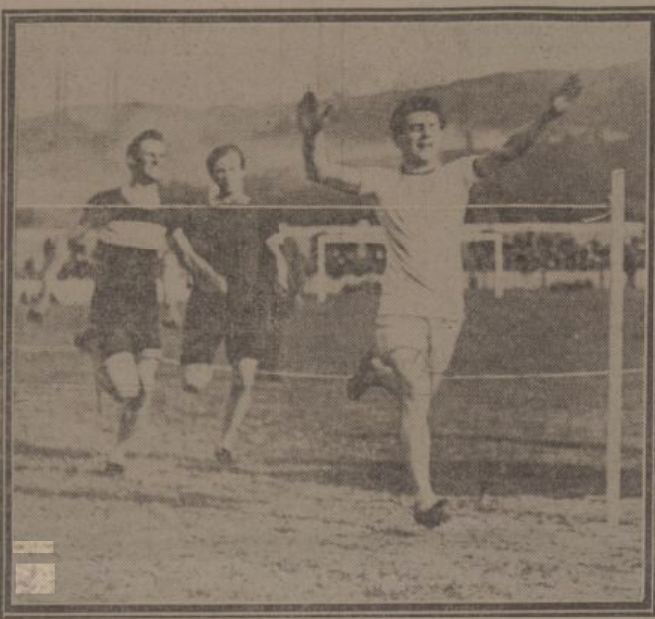
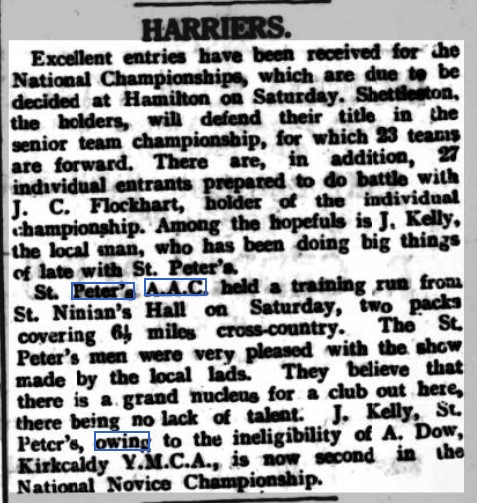
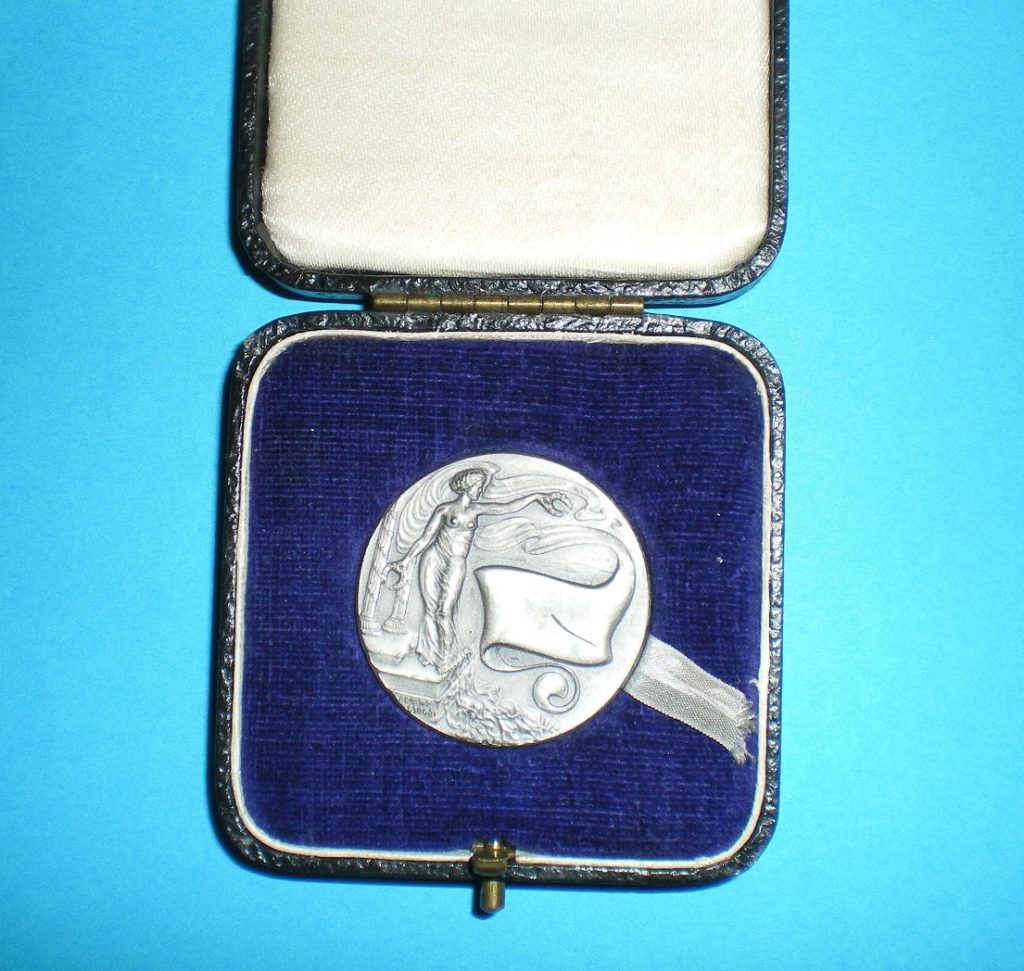
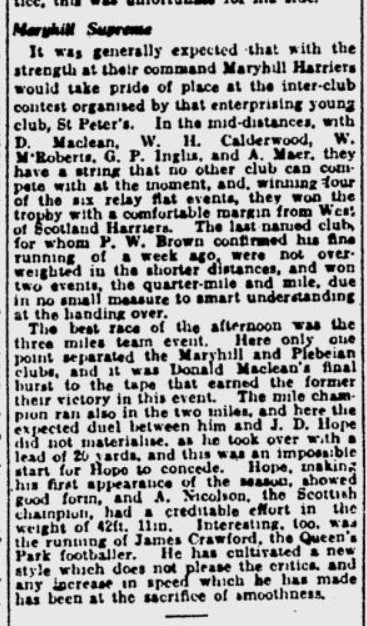
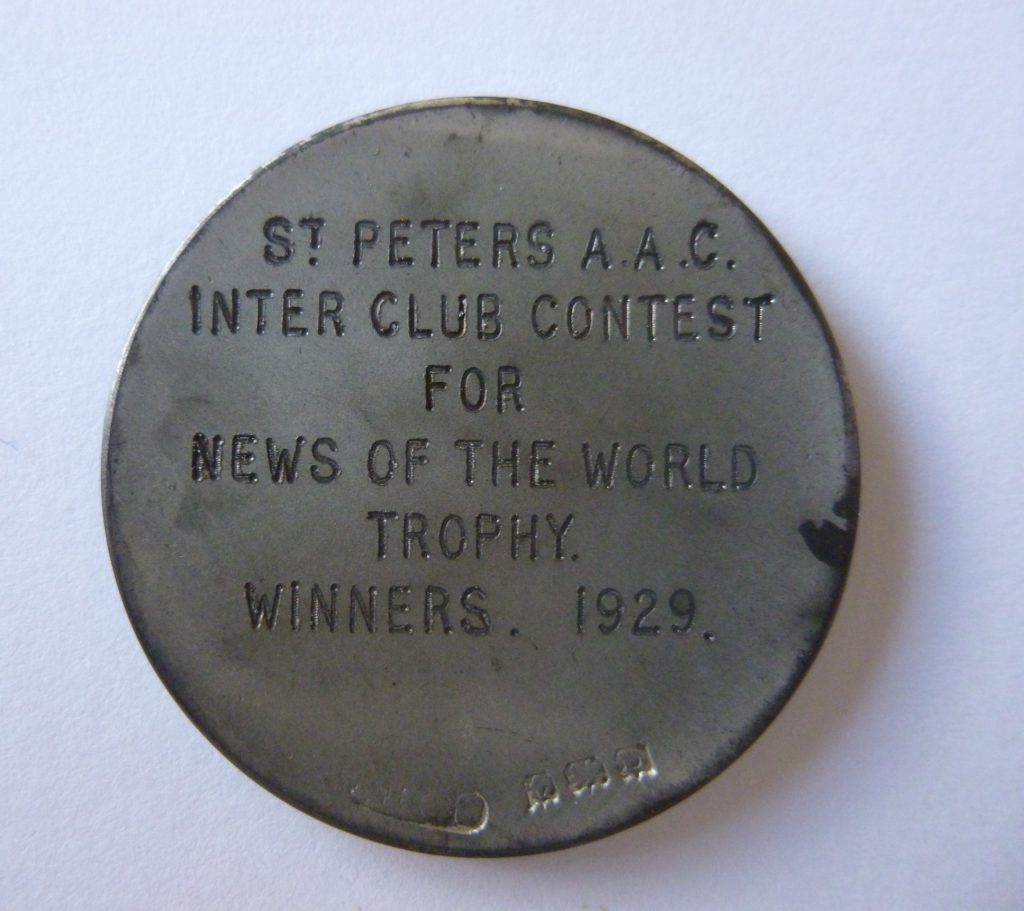
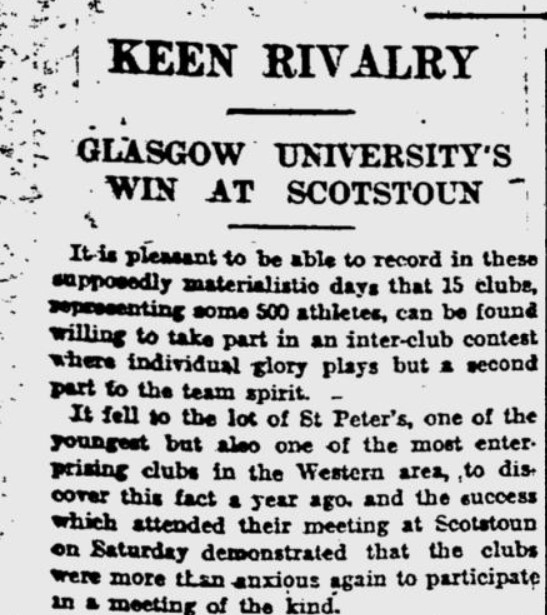
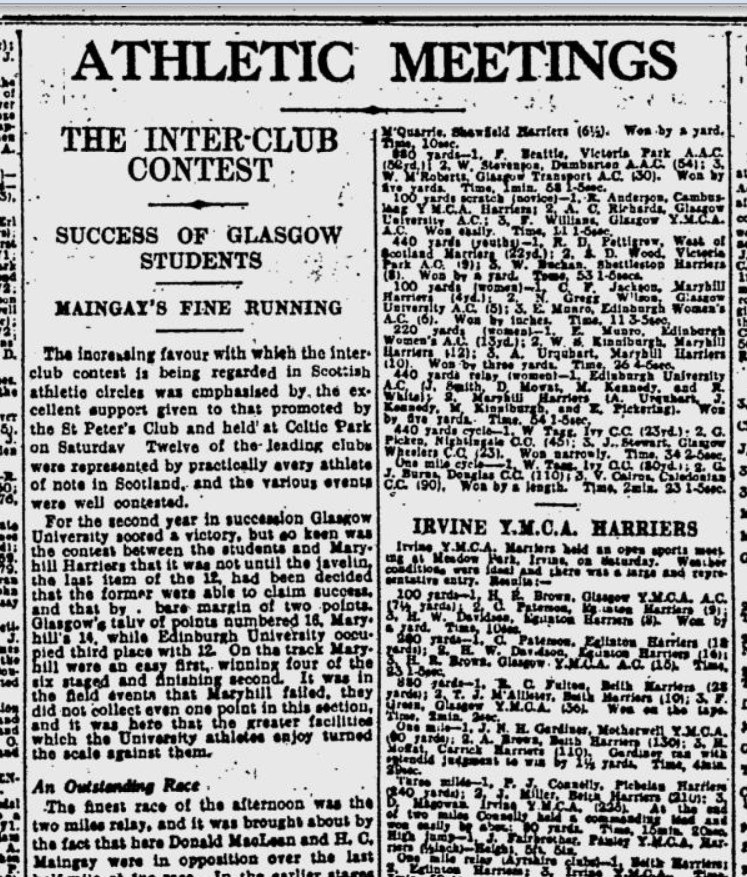
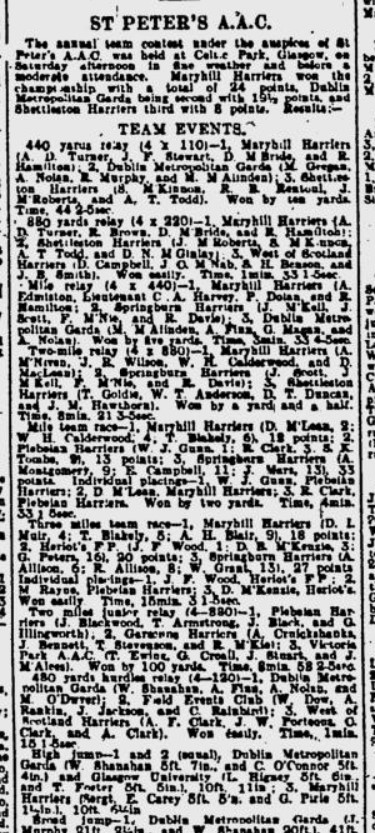
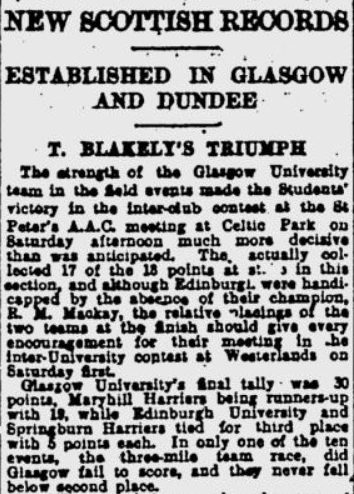
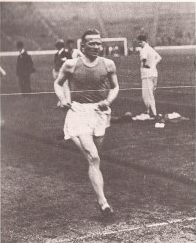
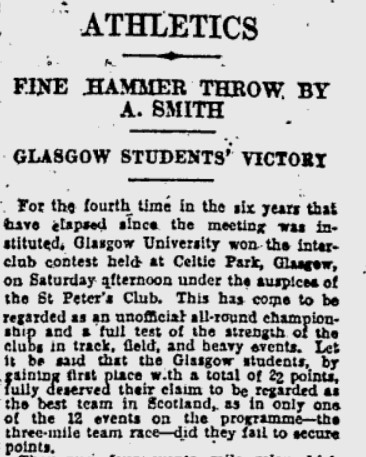
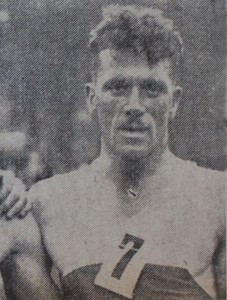
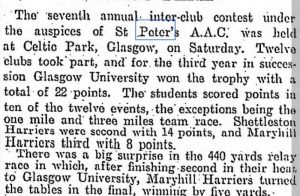
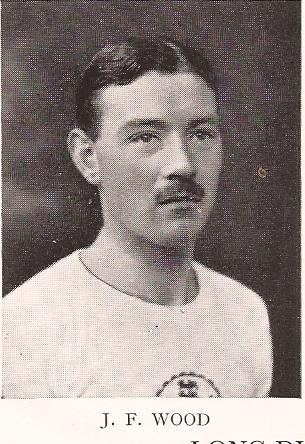
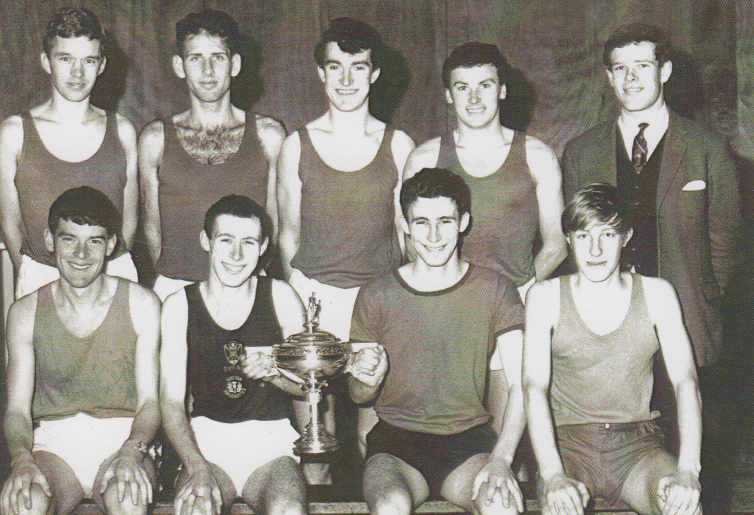
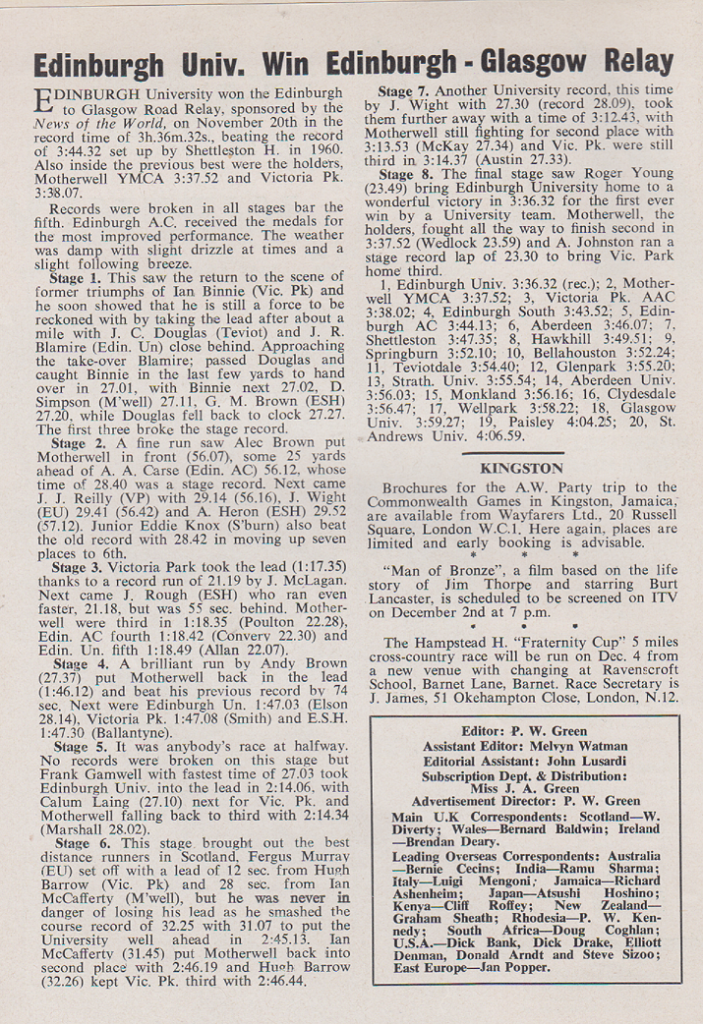
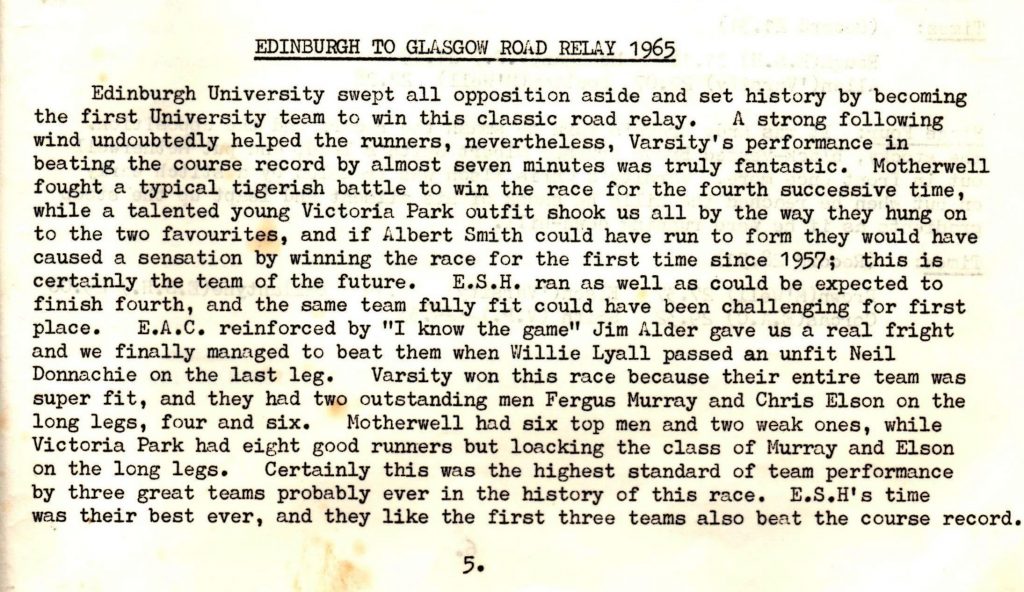
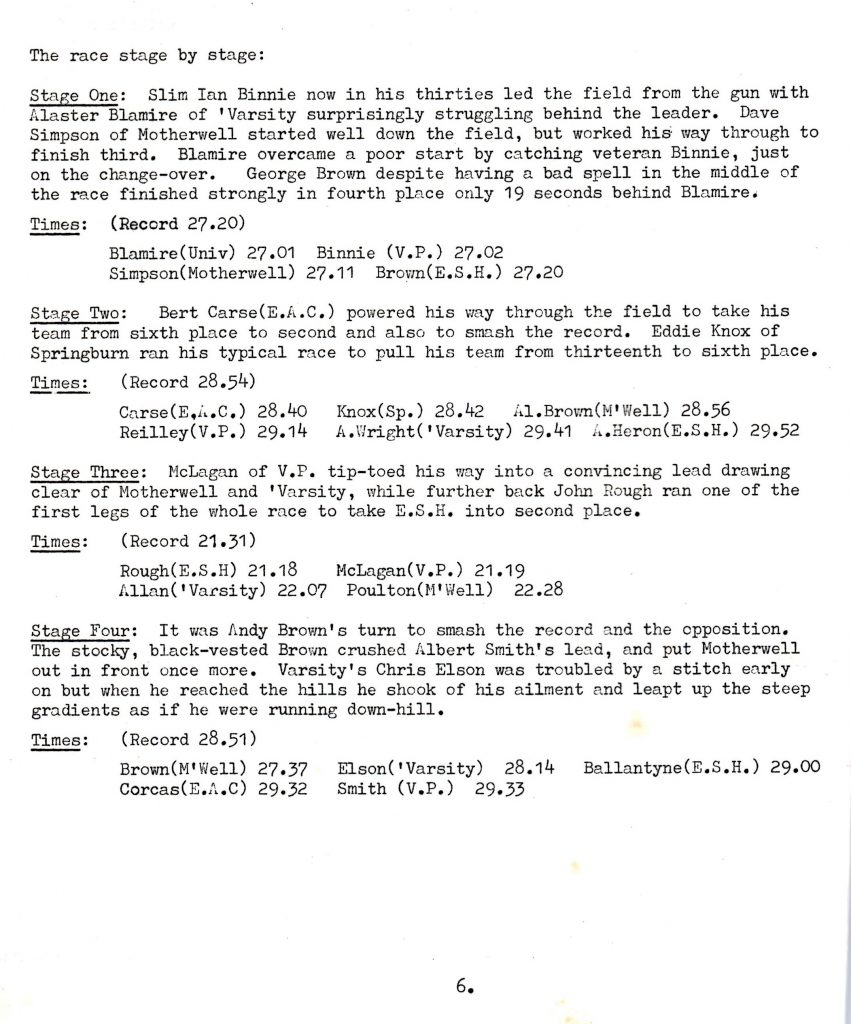
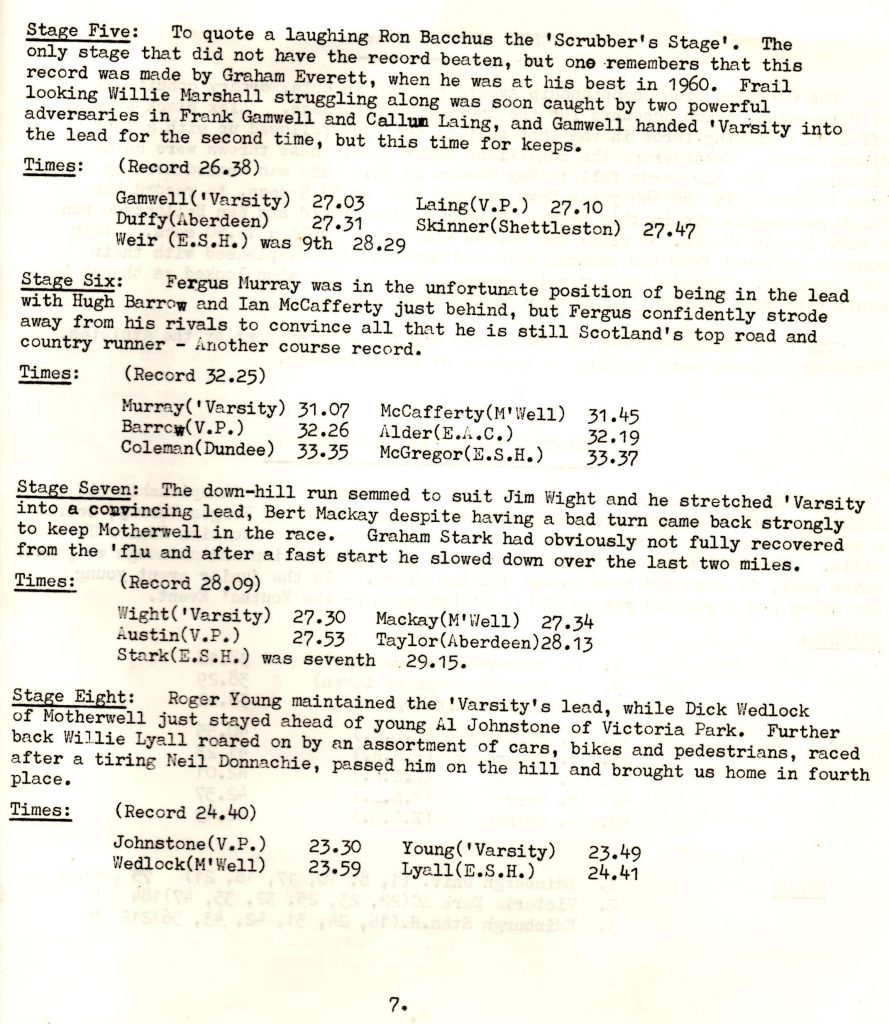
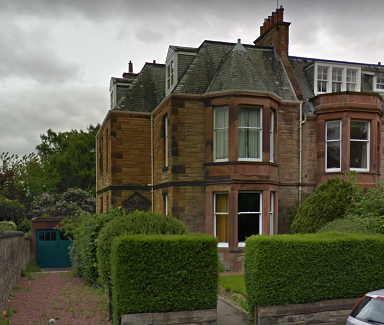
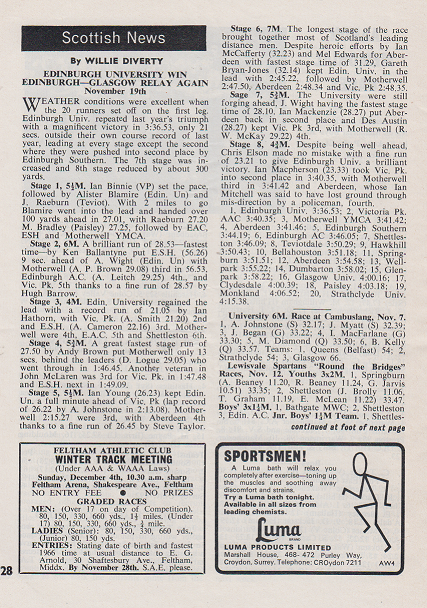
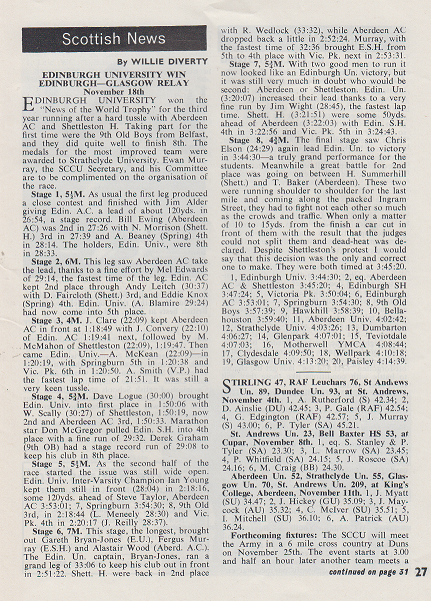
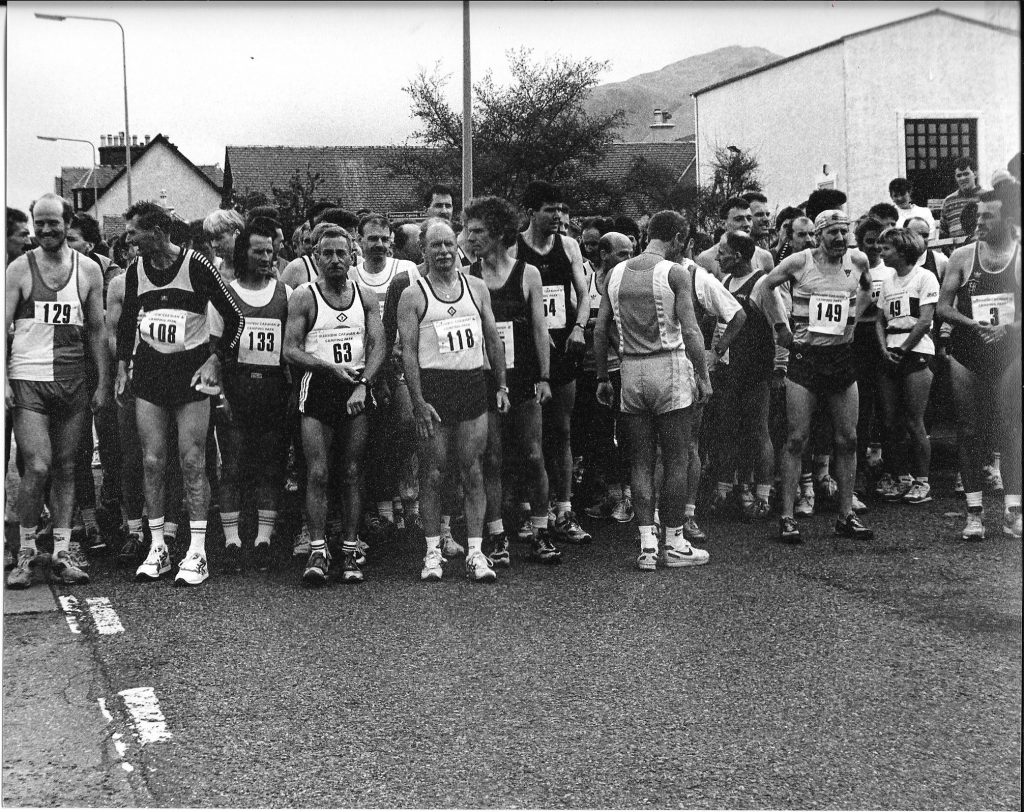
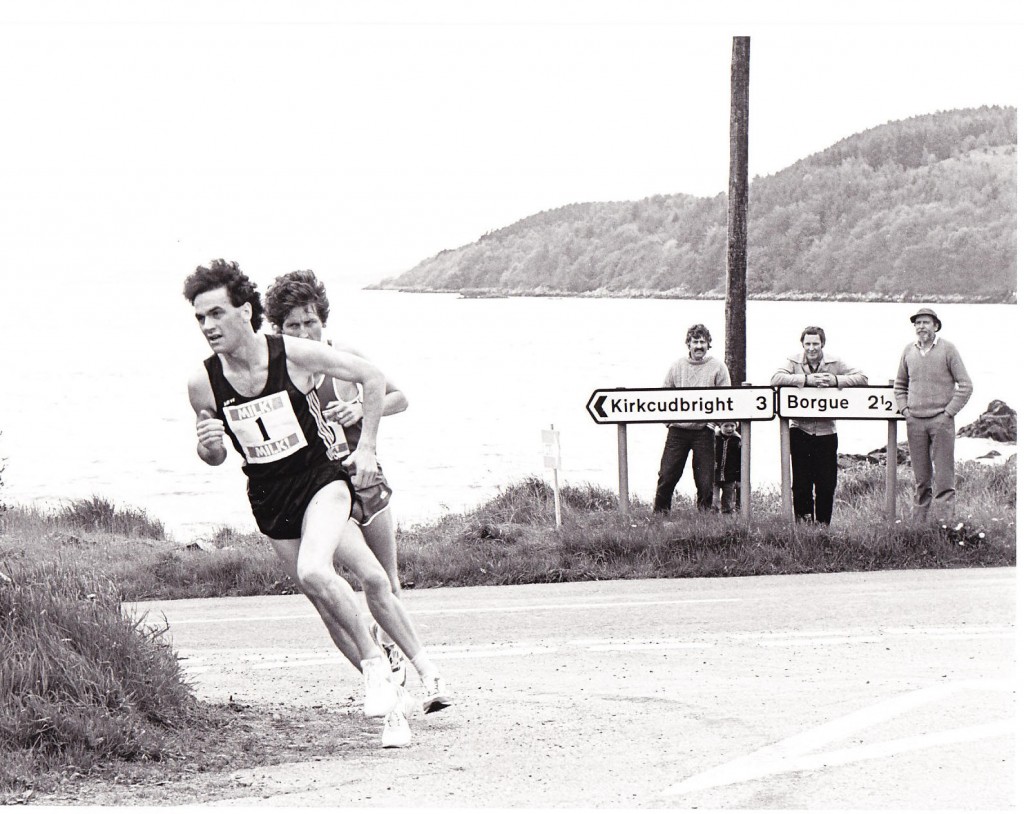
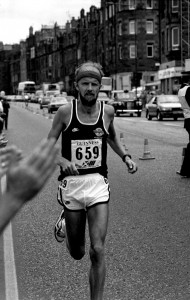
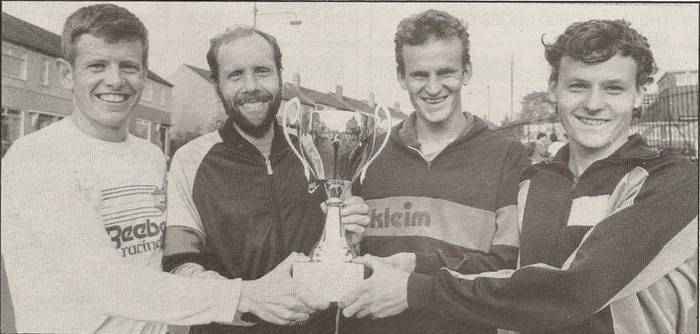
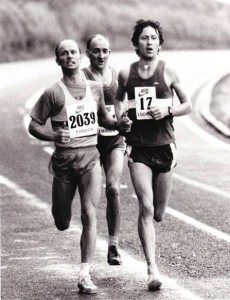
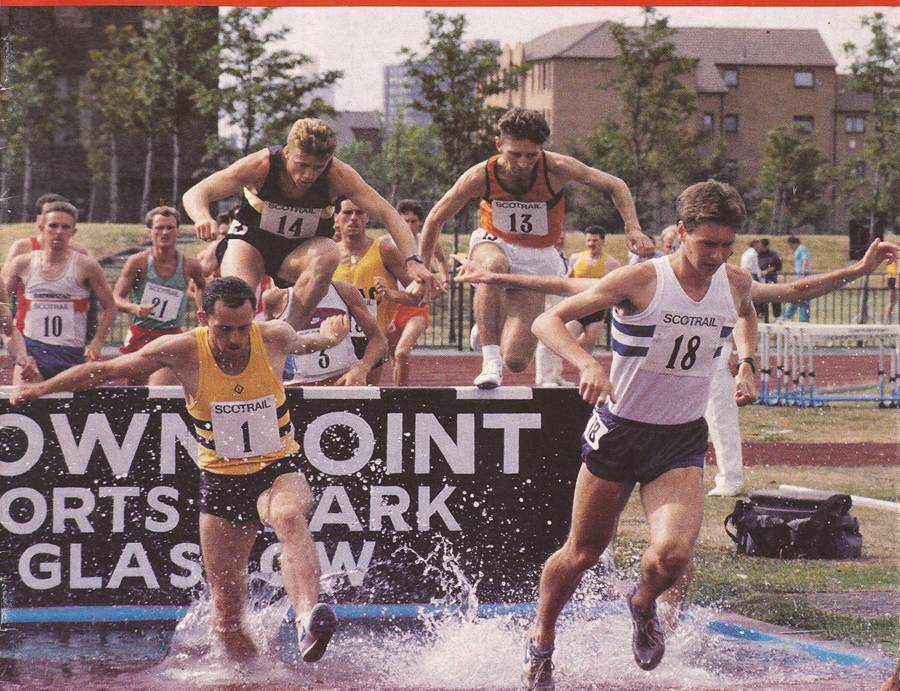
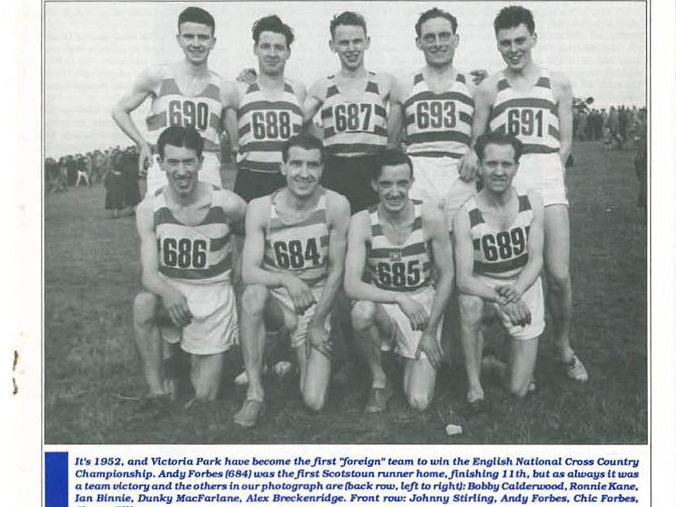
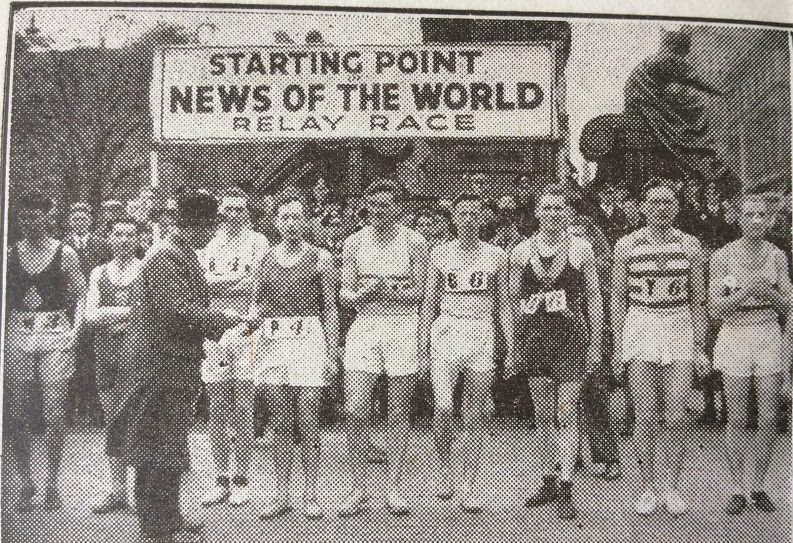
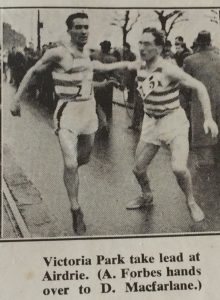
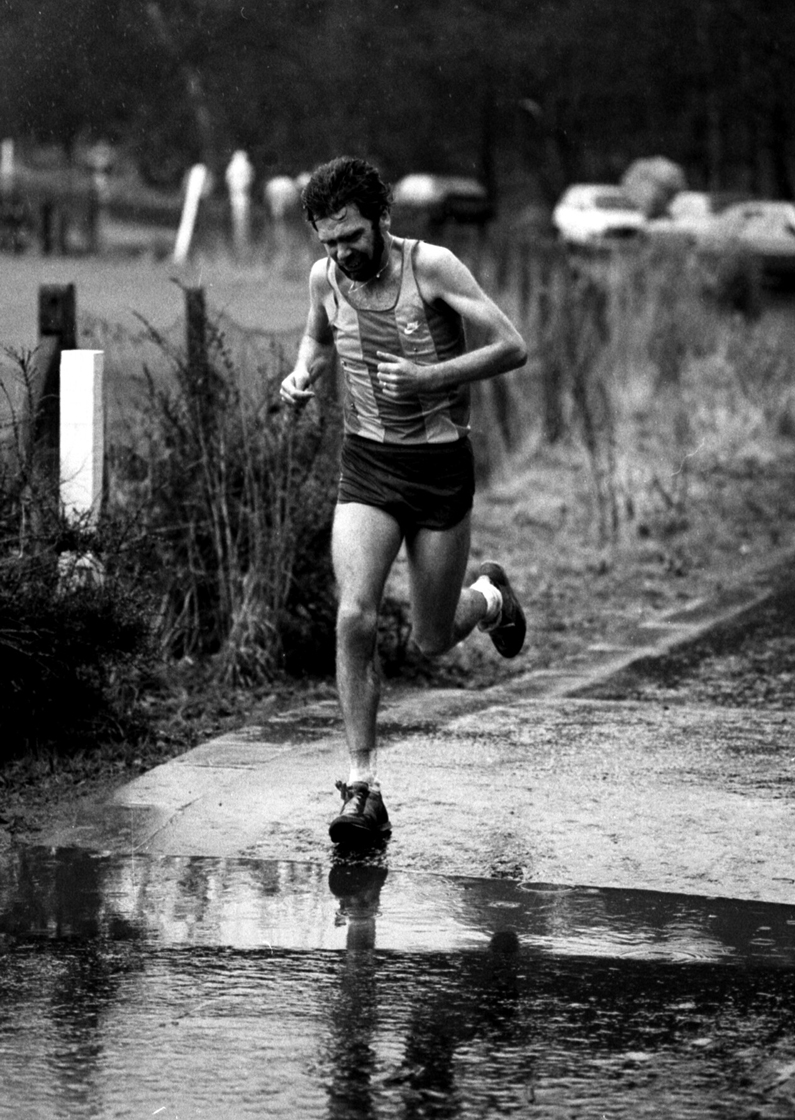
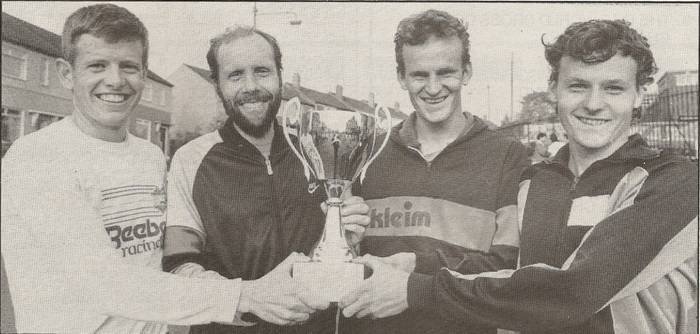
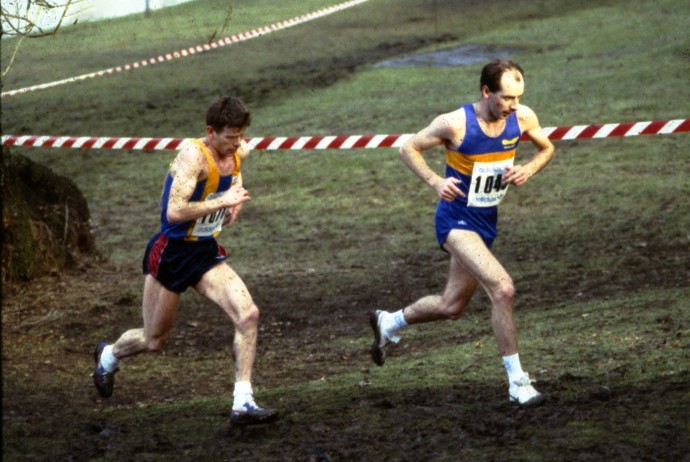
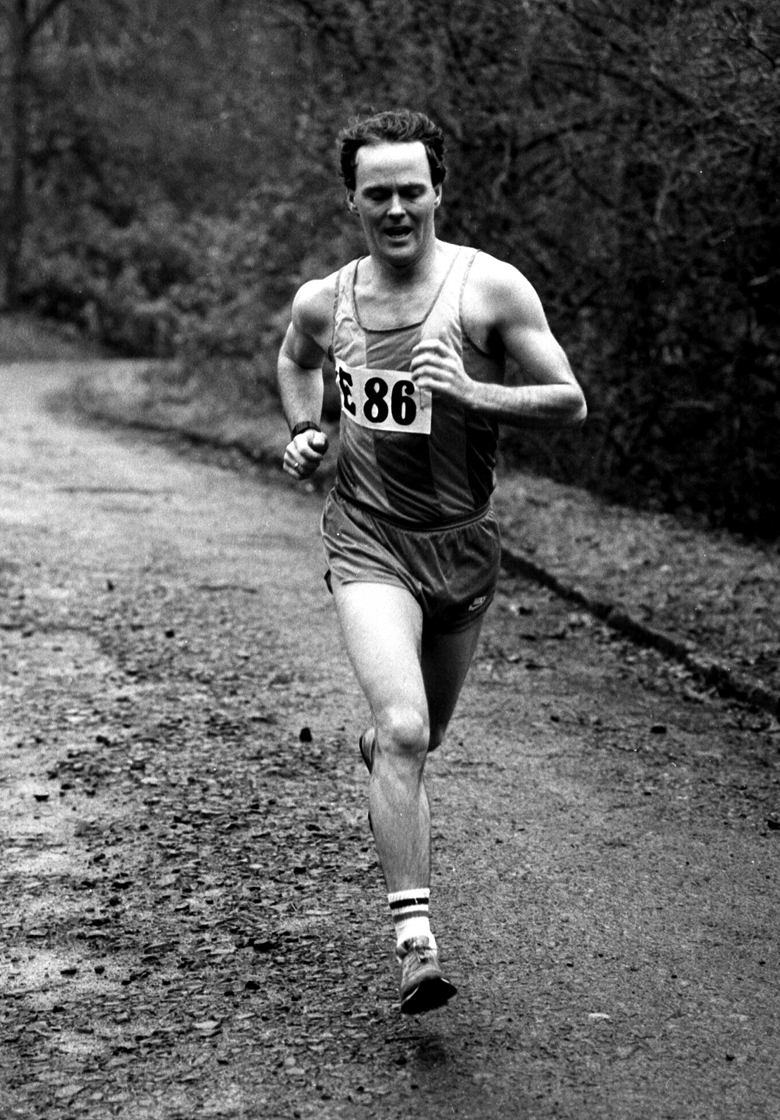
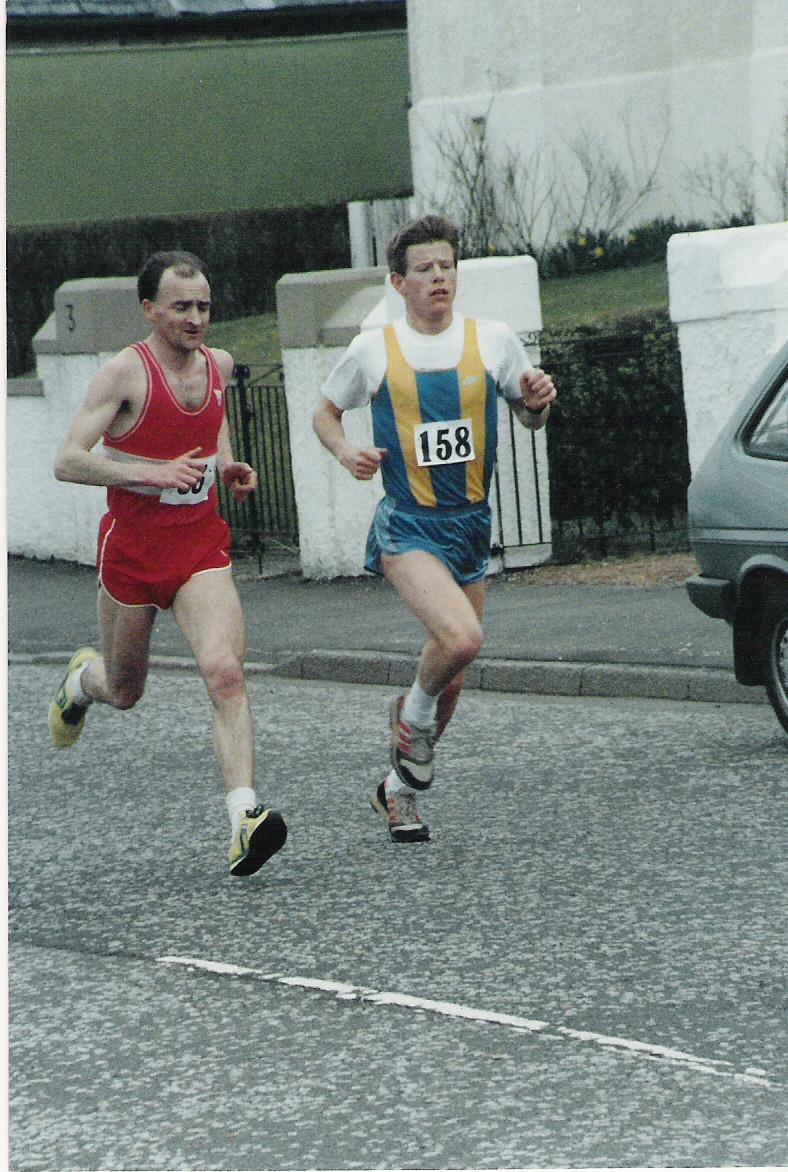
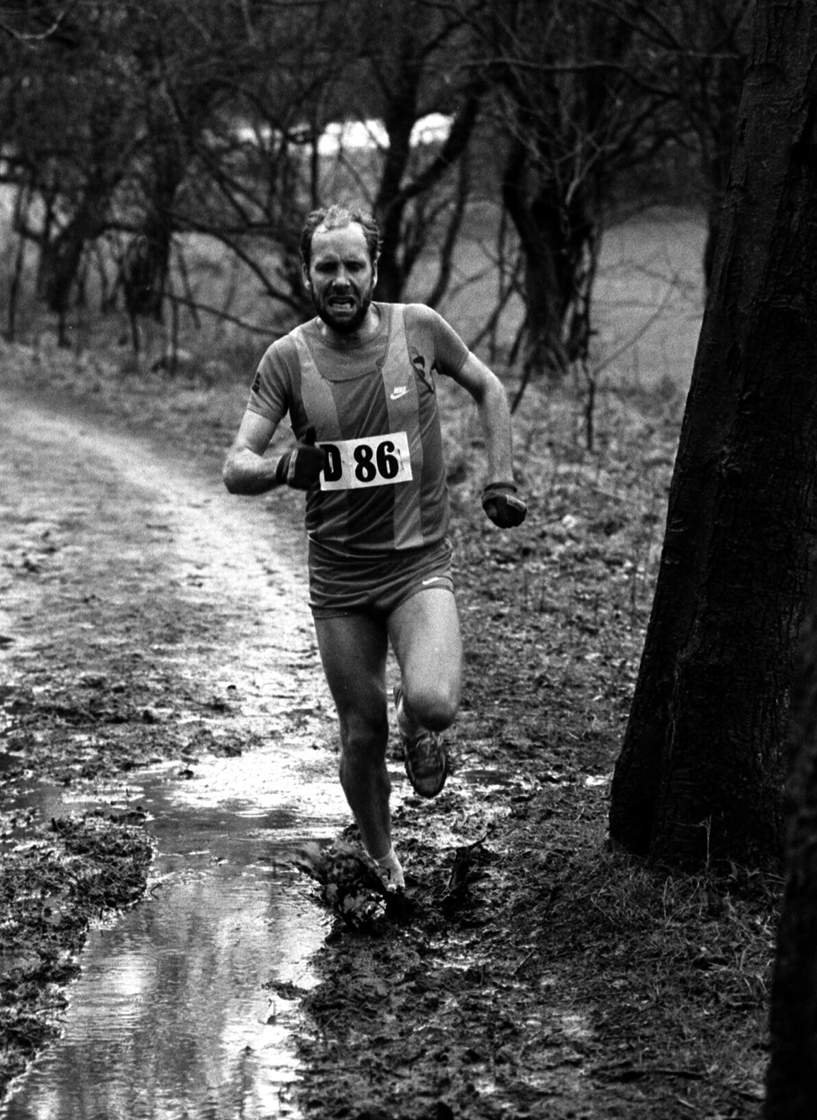
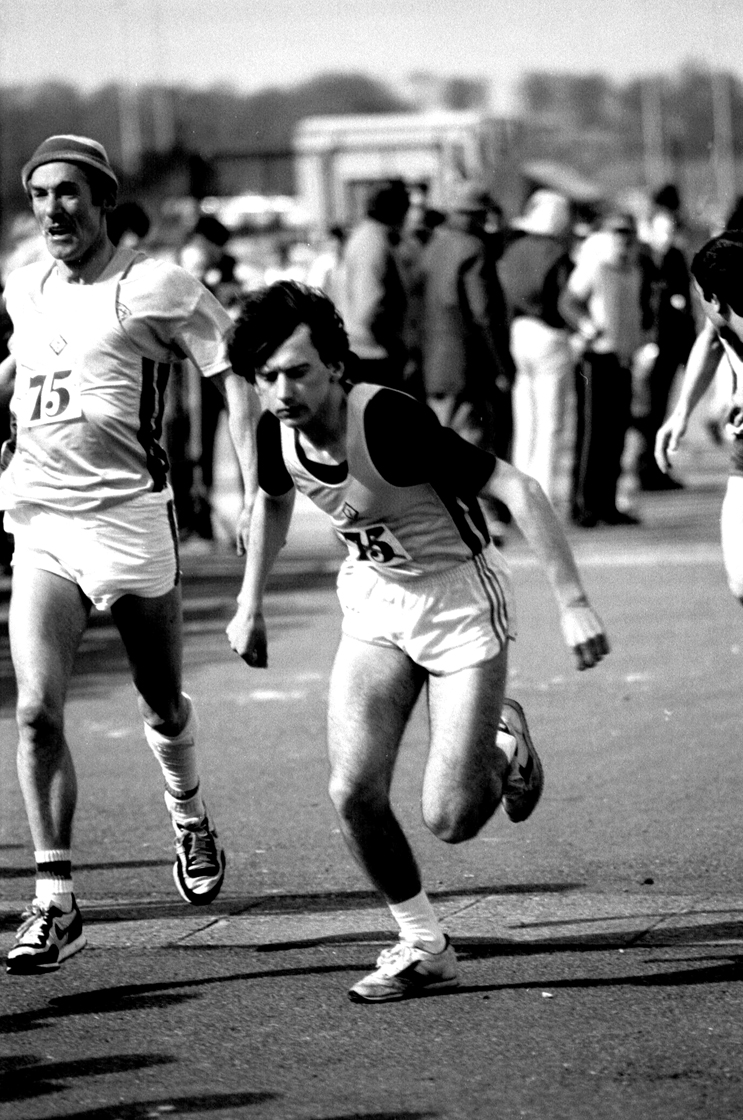
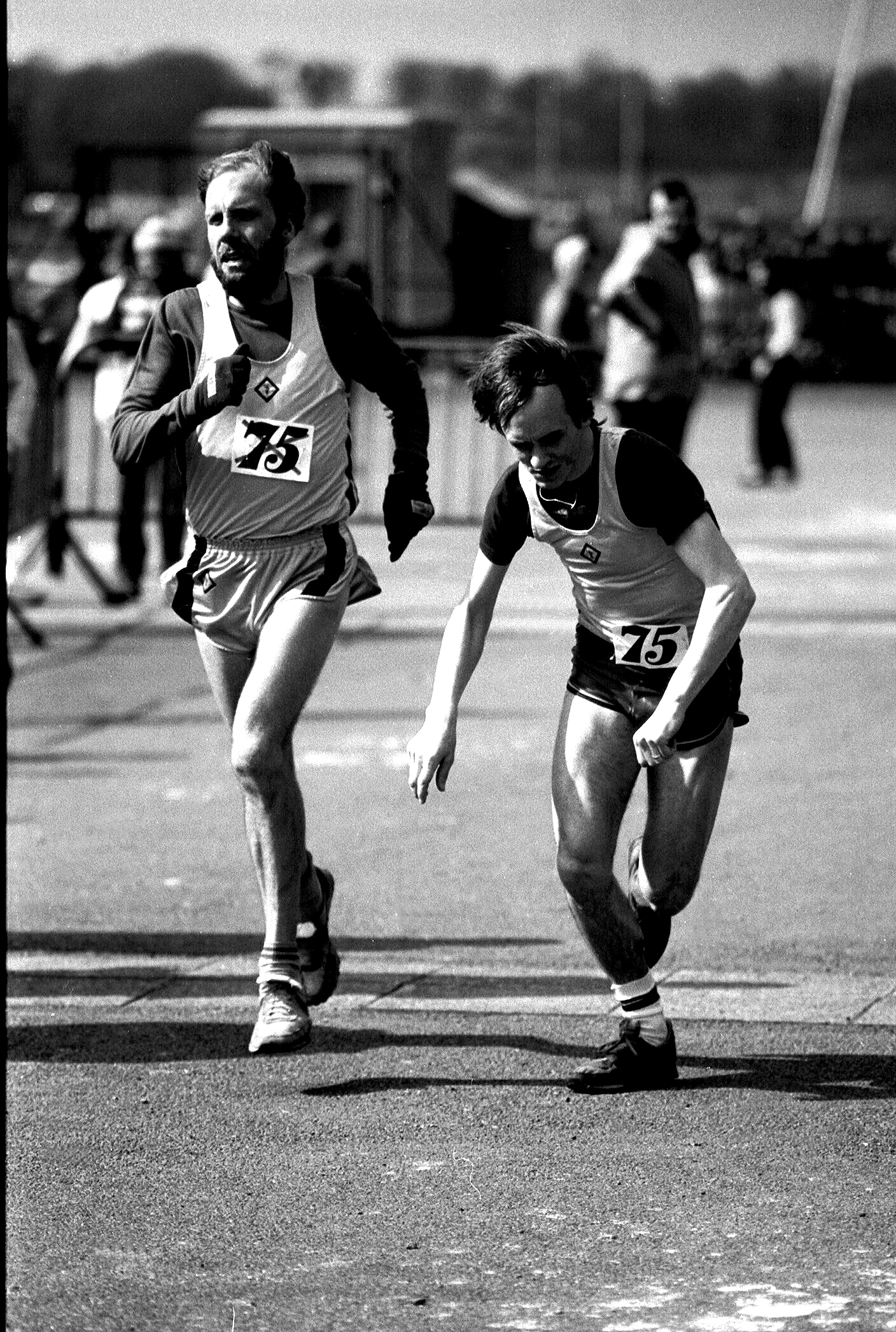
![Stuart%20Barnett%20pic[1]](http://www.scottishdistancerunninghistory.scot/wp-content/uploads/2015/10/Stuart-Barnett-pic1-705x1024.jpg)
![Stuart%20Barnett%20Denbigh%2085[1]](http://www.scottishdistancerunninghistory.scot/wp-content/uploads/2015/10/Stuart-Barnett-Denbigh-851.jpg)
![Stuart%20Barnett%20Boyle[1]](http://www.scottishdistancerunninghistory.scot/wp-content/uploads/2015/10/Stuart-Barnett-Boyle1.jpg)
